From Gibraltar to the Caribbean and back to Sydney
September 1988 to September 1989
Gibraltar
On Thursday 8 September 1988 we tied up at the Customs wharf in Gibraltar. On the passage from Tunisia's Tabarka to Gibraltar we had covered 700 nautical miles in five and a quarter days, averaging 5.6 knots including 29 hours under power. We had completed our two-year circumnavigation of the Mediterranean Sea, and would now have to get ready for some serious ocean-going.
We were finally leaving the historic Mediterranean and its amazing mix of cultures, nations, landscapes, seaways and anchorages. We would never forget the amazing two years we had sailed around it.
However, there were some aspects of the actual sailing that we had not enjoyed and would be happy to forget. Much was unrewarding; the old saw, there’s always too little wind or too much, is right. We’d had some pleasant afternoon drifts, but on passage nothing about the weather lasts for more than an hour or two. There is never a real swell, just a rotten little chop that kicks up in any breeze and hangs on through the next morning’s calm.
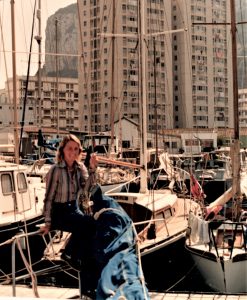 Ashore, with the starry exception of Venice and the Adriatic coasts of Yugoslavia and Greece, we have also had some disappointments. Part of the problem is probably that, rather surprising as it may seem, the people of the Mediterranean basin are not that keen on the sea. (Ulysses has a lot to say about that!) The main aim of fishermen in Greece and southern Italy is to make enough money to move ashore for good. In most harbours we were reluctant to leave the boat for any length of time so that, as in Central America, we did very little exploring inland. Culturally, therefore, we missed many of the pleasures to be found away from the coast, in these ancient empires. We resolved to return to Europe one day, for more extended exploration by land.
Ashore, with the starry exception of Venice and the Adriatic coasts of Yugoslavia and Greece, we have also had some disappointments. Part of the problem is probably that, rather surprising as it may seem, the people of the Mediterranean basin are not that keen on the sea. (Ulysses has a lot to say about that!) The main aim of fishermen in Greece and southern Italy is to make enough money to move ashore for good. In most harbours we were reluctant to leave the boat for any length of time so that, as in Central America, we did very little exploring inland. Culturally, therefore, we missed many of the pleasures to be found away from the coast, in these ancient empires. We resolved to return to Europe one day, for more extended exploration by land.
Having entered Gibraltar's inner harbour we cleared in quickly with some friendly officials. Because of all the work we would have to do, we then took a berth at Sheppard’s Marina, with its good chandlery and easy access to the town.
We picked up a pile of mail and booked flights for a two-week visit back to England to see our mothers and other family. Norma got stuck into washing, including the sails, and serious provisioning at the convenient Liptons supermarket. The little laptop was now keeping records of all the stores. After dealing with a lot of paperwork we purchased – duty free – a new Honda petrol generator, which would supply 240 V more steadily than our invertor, and would back up the engine alternator for battery charging. There was plenty of boat maintenance to keep up with, in hot, humid "Levanter" weather.
Then it was off to England for a couple of rather busy and fraught weeks, and although we started the process of getting Norma’s Mum out to Australia to live with us, it was sad to leave them both alone again.
Once back, we were quickly into more boat work and provisioning, and packing every spare corner with spare parts. We replaced the lower shrouds, as Norma had seen that one of the strands had broken. On October 1 we had a ringside seat for Gibraltar Air Day, a splendid air show including the Red Arrows, the 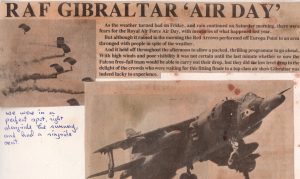 Harriers doing their aerial acrobatics, and other aircraft including Tornados, Jaguars, Canberras and a Shackleton. The next day we had lunch with four of the RAF Jaguar pilots on Satisfaction, Jim (ex-USAF) and Judy, with whom we had spent time in Venice and Malta.
Harriers doing their aerial acrobatics, and other aircraft including Tornados, Jaguars, Canberras and a Shackleton. The next day we had lunch with four of the RAF Jaguar pilots on Satisfaction, Jim (ex-USAF) and Judy, with whom we had spent time in Venice and Malta.
It had always been our intention to leave for the Canaries soon after we got back from Britain. For the first few days after our return to the Rock the weather was fine, and the pilot charts assured us of a continuing high chance of northerlies, so there didn’t seem to be that much of a rush.
Among many other friends we met up again with Mike and Karen on Tola. Their baby boy had successfully been born in Malta and named Falcon. They asked me to give him a post-natal check. After giving them the usual disclaimers - this was not exactly my field of expertise - I made the examinations prescribed in the textbook I carried. As a result I pronounced him healthy and with all joints in good order, and we wished them well for their continuing circumnavigation.
Contrary to our predictions, after a week a strong low-pressure system established itself to the west of Spain, apparently permanently, bringing sou-westers all the way down through Madeira to the Canary Islands. We were thus stuck for a while but began carefully tracking the weather and forecasts, waiting for a propitious time to start our trans-Atlantic passage to the Caribbean. Many in the marina, and several friends, were all waiting for the same.
To save money and move out of the crush we moved from the marina to the anchorage by the side of the airport runway. The weather continued to deteriorate seriously, with strong and gusty winds predominantly from the south-west, directly  contrary to what we wanted and to what was supposed to be the prevailing wind at this time of the year. We took a few little local trips to kill the time, including over to La Linea in Spain and a retrospective visit to Estepona.
contrary to what we wanted and to what was supposed to be the prevailing wind at this time of the year. We took a few little local trips to kill the time, including over to La Linea in Spain and a retrospective visit to Estepona.
During this waiting period there were continuing discussions among the yachts about when to go. Some were already leaving for Tangier in Morocco or Las Palmas in the Canary Islands and other take-off points for the trans-Atlantic passage. But my interpretations of the weatherfax maps I was studying several times a day continued to be pessimistic, contrary to the often much more optimistic forecasts transmitted by the RAF station here.
Indeed, yachts who had decided to get on their way - including some friends who had left against my direct advice as we saw them motoring out - were all reporting that they were having a very bad time of it, with heavy headwinds. Some were already heaving to for days in gale-force winds gusting to 50 knots and being swept to the north. Two boats took about a fortnight for the 700-mile passage to the Canaries, and at least two women friends decided that they were done with ocean sailing and flew back to the States from Las Palmas.
A month after going out to anchor by the runway we were also getting very sick of waiting and having to keep re-provisioning. However, after a particularly bad and sleepless night of vicious thunderstorms a weather window did seem to be opening. The upper-level low that was causing all the trouble had finally filled and there was a chance that the wind would be shifting to the north. Also, the anchorage was becoming untenable as swells were rolling in following the gales. Therefore, on the morning of Friday November 11 1988 we finally decided to leave Gibraltar, under clearing skies and easing winds.
We motorsailed out of the harbour and round to the west through the Strait of Gibraltar in the expected choppy conditions. Then we picked up more bad news on the radio: a boat that had just left Tangier reported adverse conditions and that they were returning. Two other boats had decided to keep plugging on, but their reports were not encouraging. We were in agonies of indecision, but in lumpy seas to the north of the city we decided to divert down to Tangier. We had seen that two other yachts were already doing so. Our good friends Tom and Maureen on Tilly Whim reported that they were in the harbour there and were having a good time! So the decision was quite easy in the end, although we were beginning to wonder whether we'd ever make it across the Atlantic at this rate.
Tangier, Morocco
It was an easy enough approach around the end of Tangier's big harbour wall and through a passage into the small inner harbour. This seemed to be only for yachts. There were many already there, as could be expected, all rafted in several layers out from the wharf. We tied up to Tilly Whim.
We were greeted by friendly officialdom. The dock was cost free and was accessed only by a gate guarded by security men, which was very reassuring. That evening we had a big boat get-together with Tilly Whim and others, a barbeque on the dock: sardines, salads, various German specialities. We were all relieved to be waiting in these pleasant conditions rather than fighting with the ocean as other friends were. The popular saying was, "It's better to be in here wishing you were out there, than being out there wishing you were in here".
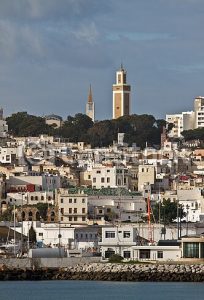 We returned to tourist mode and walked into the city with Tom and Maureen. Tangier is an ancient city with a complex history. In the early 5th century BC the settlement on this bay on the African side of the Strait of Gibraltar was one of the many Phoenician trading posts in the Mediterranean. It became a permanent Carthaginian settlement until 81 BC. The port (then known as Tingis) came under Roman control and later became the capital of the Roman province of Mauretania Tingitana.
We returned to tourist mode and walked into the city with Tom and Maureen. Tangier is an ancient city with a complex history. In the early 5th century BC the settlement on this bay on the African side of the Strait of Gibraltar was one of the many Phoenician trading posts in the Mediterranean. It became a permanent Carthaginian settlement until 81 BC. The port (then known as Tingis) came under Roman control and later became the capital of the Roman province of Mauretania Tingitana.
In the mid-19th century the city was the diplomatic centre of Morocco, with a strong British political influence. From 1923 to 1924 it was part of an internationally administered zone and was returned to self control following World War II, during which time it had been administered by Spain.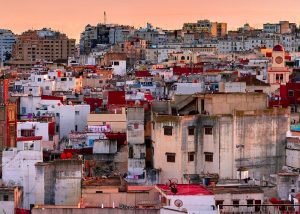
It is uphill into the city from the harbour, with layer upon layer of tightly-packed buildings. Some of the old buildings were very attractive and fronted wide open squares with ornate tiled features. Most men were dressed in Moroccan cloaks with high-peaked hoods like a monk's habit. We walked up into the "new" town and then back down to the older shopping area and the covered market. The next day we returned to the old town, 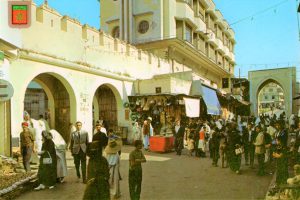 the medina and the Kasbah, viewing the western strait from the heights. This (Sunday) was market day, with many women dressed in red-striped skirts and toped by wide straw hats. There was little hassle from stall-holders and would-be guides.
the medina and the Kasbah, viewing the western strait from the heights. This (Sunday) was market day, with many women dressed in red-striped skirts and toped by wide straw hats. There was little hassle from stall-holders and would-be guides.
Back down on the wharf we were hailed by a yachty who knew (like most of the others) that I was a doctor. "One of the guys is lying flat out on the wharf", he exclaimed. We soon found the invalid lying there, being attended by an attractive young woman. I said to her, "maybe I can help - I'm a doctor". "Thank heavens", she replied - "so am I"! It was our professional agreement that our patient was simply heat-stressed and dehydrated, and simply told his friends to keep him cool and plenty to drink.
The doctor was a young anaesthetist, Lilian, and with her husband Rudy - both Swiss - they were preparing to sail the Atlantic and the Caribbean in their sloop Shiva. They were to become life-long friends.
In Gibraltar and here, we were getting a reputation as weather gurus, reinforced by my constant studying of fax weather maps. During our second day in the harbour we were approached and asked, "are you leaving tomorrow?' "No", I replied, "but maybe the day after". "OK, we'll go shopping today," was the reply. We got the same enquiries the next day, and my report was that the offshore weather systems had appeared at last to be returning to normal and the outlook was good.
Accordingly, after three nights in the harbour we motored out into light easterly winds, closely followed by ten other boats! Soon afterwards we were sailing well, on a broad reach under full sail, south-west down the coast of Morocco in beautiful conditions. By evening we were sailing wing-and-wing with the wind dead astern, over slight seas, and only being overtaken by a racing yacht under spinnaker. The skies were clear enough for star sights. It then became calm for a while, but we caught a nice little dorado; out of practice for catching big fish, we did spray more blood than usual over the deck.
The wind continued nicely into the northern quadrant, rising a little to allow for a splendid ride under spinnaker for much of the way. In beautiful conditions we hardly ever had to touch anything, and were lying in the sun on the foredeck to get out of the shade of the headsail. The contrast between these conditions and those typically associated with the Mediterranean, let alone the appalling weather recently suffered by yachts that had so recently departed Gibraltar, was amazing.
Las Palmas, Gran Canaria
We came into the harbour in Las Palmas - Puerto la Luz - after a sail of 680 nautical miles in just under six days. I recorded in the log that this had been a "benign sort of passage, having waited so long for one".
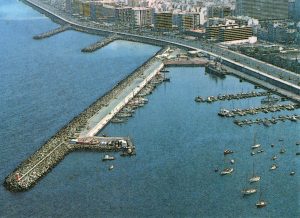 Las Palmas on the island of Gran Canaria is a major stopping and provisioning port for yachts as well as commercial vessels. It is also the starting point for the many yachts in the annual Atlantic Rally for Cruisers (ARC). This is a group and shepherded passage that had become a popular event since its first one two years previously. We had always vowed to avoid this event if we could, because we preferred to be on our own at sea. But because we had been so delayed by weather we arrived just as the huge fleet was gathering. The marina, with a film of oil on the water, was packed out by participants, but in any event we had planned to anchor outside the walled harbour and off the adjacent beach. Checking in was very easy, just a wave from the official on the harbour wharf.
Las Palmas on the island of Gran Canaria is a major stopping and provisioning port for yachts as well as commercial vessels. It is also the starting point for the many yachts in the annual Atlantic Rally for Cruisers (ARC). This is a group and shepherded passage that had become a popular event since its first one two years previously. We had always vowed to avoid this event if we could, because we preferred to be on our own at sea. But because we had been so delayed by weather we arrived just as the huge fleet was gathering. The marina, with a film of oil on the water, was packed out by participants, but in any event we had planned to anchor outside the walled harbour and off the adjacent beach. Checking in was very easy, just a wave from the official on the harbour wharf.
Apart from the fact it's a convenient stop on the long way across the Atlantic, we did need to call into Las Palmas to be assured of refills for our gas bottles and to top up our provisions. It was another sociable stop, as we had several friends in the Rally, and it was good to catch up with them. On the first evening we had Rudy and Lilian over for dinner to help us to eat the dorado we had caught on the way down.
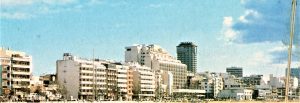 The newer parts of Las Palmas were not very attractive, backed by blocks of high-rise apartments, but the older parts of town to the south displayed some very attractive Spanish-style facades, with courtyards seen through arched front doors. In the heart of the old quarter sits the twin-towered Santa Ana Cathedral, the first church
The newer parts of Las Palmas were not very attractive, backed by blocks of high-rise apartments, but the older parts of town to the south displayed some very attractive Spanish-style facades, with courtyards seen through arched front doors. In the heart of the old quarter sits the twin-towered Santa Ana Cathedral, the first church 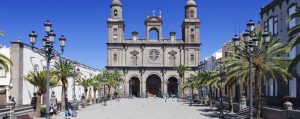 in the Canaries, which was built on the orders of Los Reyes Católicos, Queen Isabella I of Castile and King Ferdinand II of Aragon, after Gran Canaria was conquered by Spain in 1478. Construction started around 1500 but was not completed until almost four centuries later, the result of which can be seen in its differing architectural styles: Gothic, Renaissance and Neoclassical.
in the Canaries, which was built on the orders of Los Reyes Católicos, Queen Isabella I of Castile and King Ferdinand II of Aragon, after Gran Canaria was conquered by Spain in 1478. Construction started around 1500 but was not completed until almost four centuries later, the result of which can be seen in its differing architectural styles: Gothic, Renaissance and Neoclassical.
Rudy and Lilian had rented a VW Polo, and we shared with them a great little trip round the northern part of the island. It's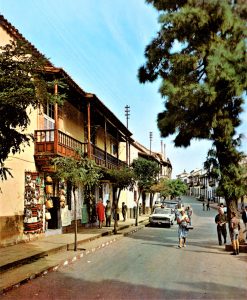 basically a dormant volcano, and from the coast we were rapidly into the
basically a dormant volcano, and from the coast we were rapidly into the 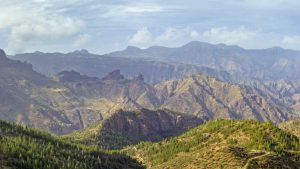 foothills with nice views over the town and harbour. It was then up to Cruz de Tejeda at the very peak of the central mountain and well into the cloud base. From there we took a lovely road through impressive canyon country with volcanic craters, jagged rock gorges and rifts. An amazing variety of plants and flowers were growing everywhere, including a wide variety of cactus.
foothills with nice views over the town and harbour. It was then up to Cruz de Tejeda at the very peak of the central mountain and well into the cloud base. From there we took a lovely road through impressive canyon country with volcanic craters, jagged rock gorges and rifts. An amazing variety of plants and flowers were growing everywhere, including a wide variety of cactus.
Through more green and pleasant hills we came to a small roadside restaurant for lunch and then a short distance further stopped at 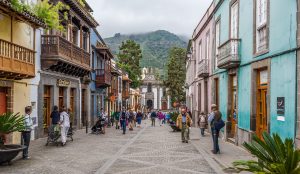 the lovely little town of Teror. Its fine church façade overlooked a charming square, rimmed by Spanish houses with wooden balconies.
the lovely little town of Teror. Its fine church façade overlooked a charming square, rimmed by Spanish houses with wooden balconies.
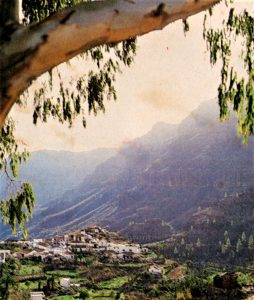 While up in the mountains Rudy ran over a large rock in the road, which he couldn't avoid because of an oncoming car. It punctured the fuel tank and caused some disruption to the gearchange linkage. Luckily, a Shell service station was only a kilometre further down the road. We rapidly persuaded a morose and uncommunicative mechanic to hoist us up on a lift while we assessed the extent of the damage. It was only a small hole in the tank, which we plugged with a screw sealed - traditionally - with chewing gum. Fortunately both Rudy and I were pretty experienced at making on-the-road car repairs! We then fuelled up and got going again.
While up in the mountains Rudy ran over a large rock in the road, which he couldn't avoid because of an oncoming car. It punctured the fuel tank and caused some disruption to the gearchange linkage. Luckily, a Shell service station was only a kilometre further down the road. We rapidly persuaded a morose and uncommunicative mechanic to hoist us up on a lift while we assessed the extent of the damage. It was only a small hole in the tank, which we plugged with a screw sealed - traditionally - with chewing gum. Fortunately both Rudy and I were pretty experienced at making on-the-road car repairs! We then fuelled up and got going again.
After this good little exploration the four of us spent the next day doing yet more provisioning - we were never going to starve at sea - using the car to get to a good general store and supermarket. It was showery, but the forecast was good and we decided to leave the next morning.
A transatlantic passage to the Lesser Antilles
We had been just a week in Las Palmas. We had much enjoyed our day in the mountains and done some good provisioning, but the town was not much to speak of and the anchorage was exposed to the sea and was very rolly at night. Norma took to sleeping in the saloon.
So we were quite glad to put to sea early on November 26, 1988, completely coincidentally being also the day of the start of the ARC. We got out to sea as soon as possible to avoid the rush. It was calm in the lee of the island but by nightfall we were booming along in a firm NNW wind. It was quite rough, and the crests of the wild-looking waves were glowing in the bright moonlight. It was a very good start to the passage, and we made 143 miles in the first 24 hours.
We had a good run down generally SSW towards the Cape Verdes, following the traditional trade wind route for sailing ships across the Atlantic. The old saw was, “sail south until the butter melts, then turn right”, the intention being to leave the effects of the north Atlantic weather and get down to the Trades as soon as possible.
Cera runs and steers herself well when sailing dead downwind, but some of the faster, racier boats in the ARC were preferring to broad reach, gybing from side to side every hour or so. This meant that every now and then one of these yachts would come zooming across in front of us, mostly unlit and with poor or no lookout. But in the vastness of the ocean they all eventually disappeared.
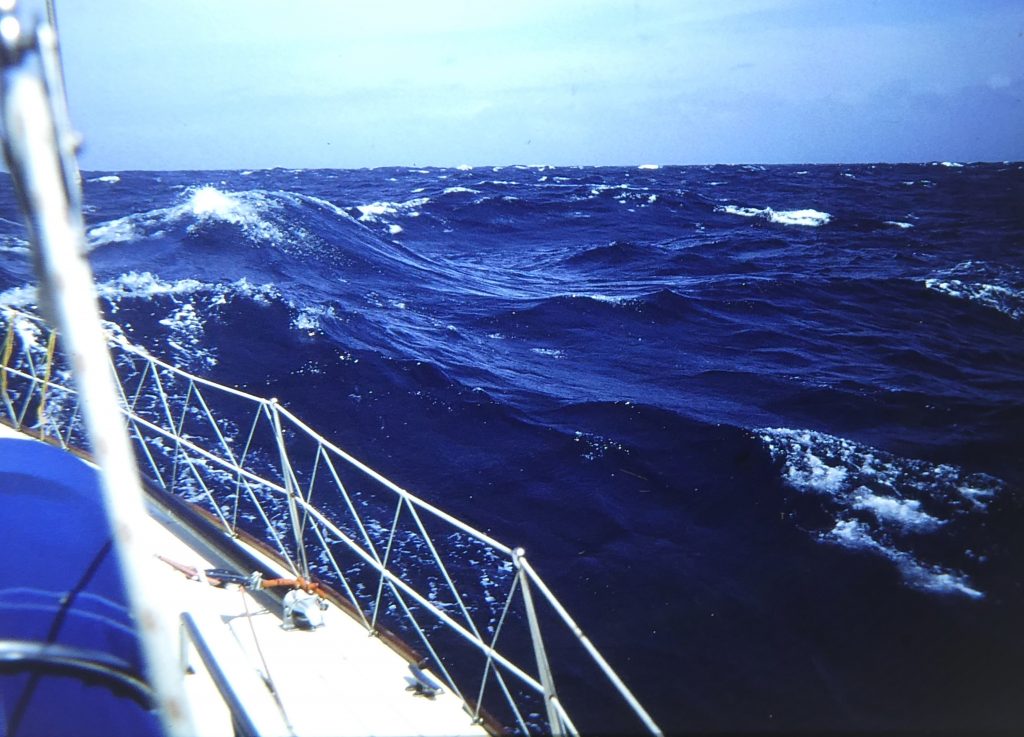 Well into the first week we were still sailing fast, making 150 to 160 miles per day, the best passage-making for a very long time. We were into the tropics on the third day out, but it was not getting much warmer. As the first week passed and we were easing our course more towards the west the wind gave up on us, and we had a day or two of calms, squalls, and headwinds as a series of fronts trailing winter storms in the far north passed over us. Boats further along the route from us were reporting little wind, so we were certainly not yet in the "reliable" trades. Nevertheless, as we settled into the westerly course we were still making well over 120 miles a day, the skies were clear enough for good star sights, and it was a relatively easy ride with not a lot of sail-handling or self-steering vane trimming to do.
Well into the first week we were still sailing fast, making 150 to 160 miles per day, the best passage-making for a very long time. We were into the tropics on the third day out, but it was not getting much warmer. As the first week passed and we were easing our course more towards the west the wind gave up on us, and we had a day or two of calms, squalls, and headwinds as a series of fronts trailing winter storms in the far north passed over us. Boats further along the route from us were reporting little wind, so we were certainly not yet in the "reliable" trades. Nevertheless, as we settled into the westerly course we were still making well over 120 miles a day, the skies were clear enough for good star sights, and it was a relatively easy ride with not a lot of sail-handling or self-steering vane trimming to do.
However, the seas continued to be very uncomfortable for most of the trip, more so than we had anticipated for this supposedly idyllic passage. The problem at this time of the year is the swell generated by the north Atlantic winter storms hundreds of miles away. These sweep down from the north at right angles to the west-going swell driven by the trades. This creates a very confused sea. Fortunately, Cera is not inherently a rolly boat downwind, but even so things got tossed around a bit, including us. We were not experiencing more than about 25 knots of wind, but the seas looked much worse at times, and we were conservative with the sail area – no spinnaker on this run! We heard later that several crews in other boats had taken to sleeping on the floor of the saloon.
About half way I checked my 35mm Pentax and found to my dismay that there was no film in it! This meant that while I had been clicking away in Gibraltar, Tangier and Gran Canaria I had not been taking any photos. Stupid! Fortunately, for the whole voyage Norma had been making up scrapbooks for postcards, cuttings from tourist brochures and her own comments, so that for purposes such as this story I would be able to use scanned photos of the contemporary scene from such sources.
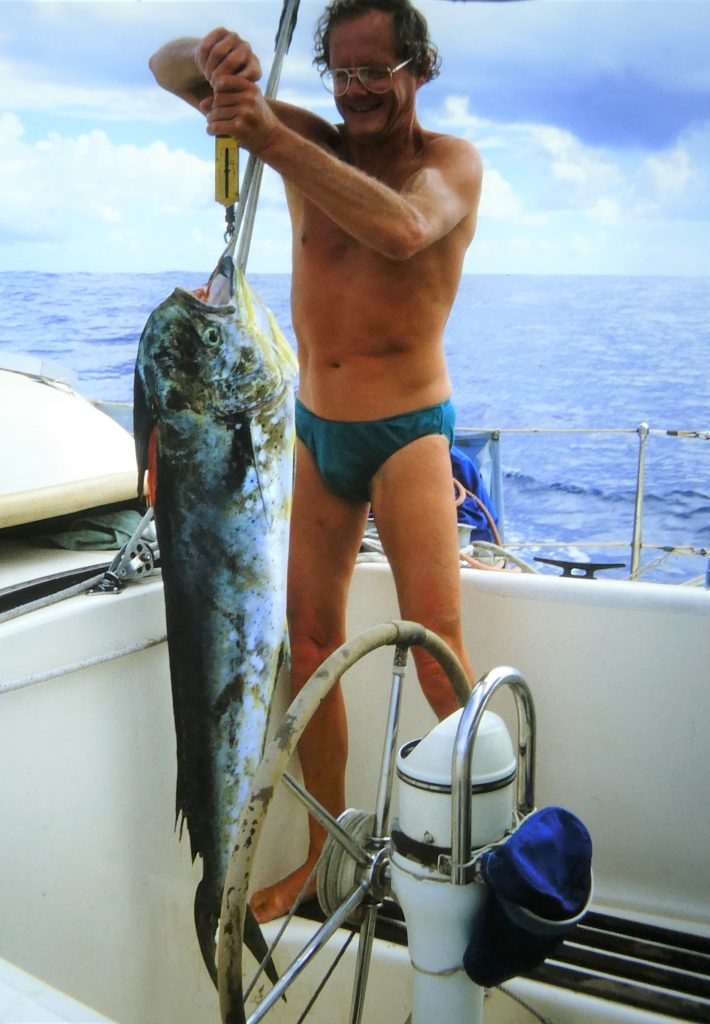 We were successful with the fishing, with fish nearly every day we wanted it, culminating in a monster of a dorado (11 kilograms) which took an hour and a half to get aboard, fed us for three days, and filled six preserving jars. Catching dorados was always a bit sad, as the shimmering blue colour of the fish in the water faded to yellow and finally to white with blue spots as the fish expired.
We were successful with the fishing, with fish nearly every day we wanted it, culminating in a monster of a dorado (11 kilograms) which took an hour and a half to get aboard, fed us for three days, and filled six preserving jars. Catching dorados was always a bit sad, as the shimmering blue colour of the fish in the water faded to yellow and finally to white with blue spots as the fish expired.
By the time we wanted to fish again it had got too rough and the trades too strong. Despite the rolly conditions Norma also managed to keep us supplied with freshly baked bread, not forgetting the "sacrificial" small loaf that we ate immediately because the smell and taste were irresistible.
We were accompanied by a large pod of pilot whales for a while, and Norma chatted to them in their whistling language, a skill she had used before with dolphins.
Two weeks out we went through a weather trough, with shifting light winds and lots of showers. Lightning was visible in the distance to the north and there was a huge swell from the same direction. This all settled into an oily calm, with no wind at all, with the boat stationary in the water. For a couple of productive hours we swam to clean the bottom. (The low price of the Turkish antifouling should have warned us of its poor effectiveness, and at the time I had been doubtful as to its coverage.) We were able to scrape off a forest of small goose barnacles and a fair bit of the long grassy weeds which were even growing up the topsides where the quarter wave washed the hull. There was no doubt that we had been losing up to a knot of speed (24 miles a day) while dragging this lot along with us.
This spell soon passed, the weather cleared and we resumed good sailing at good speed. Entering the third week at sea the easterly trade was right behind us, and we were still suffering the uncomfortable beam swell from the north. We got back to daily runs of 150 to 160 nautical miles in what were becoming rough seas, and had to reef the mainsail for the first time.
Three weeks out we called landfall, as Antigua came clearly into sight. By 1340 on Sunday December 18 we were motor sailing the somewhat tortuous course into English Harbour, on the south side of the Caribbean island of Antigua, at the top of the Lesser Antilles chain.
We had a look at Freemans Bay, off the beach outside the inner harbour, but the water looked unsettled and it was crowded by large charter yachts. We continued in, passing Nelson's Dockyard and into Ordnance Bay, the innermost reach of the harbour. It was surprisingly quiet and peaceful there, and we anchored off the mangroves that surrounded the bay. We rowed over to the dockyard to check in, a simple and quick process.
This had been one of the great ocean passages of our voyaging. We had sailed 2,890 nautical miles in just over 22 days, averaging 130 miles a day or 5.4 knots.
Islands of the Lesser Antilles
Antigua is one of the Leeward islands in the Lesser Antilles archipelago of the Caribbean. It was first settled by the British under Sir Thomas Warner, and with the exception of a brief occupation by the French in 1666 was a British possession until 1981 when it became an independent state within the Commonwealth.
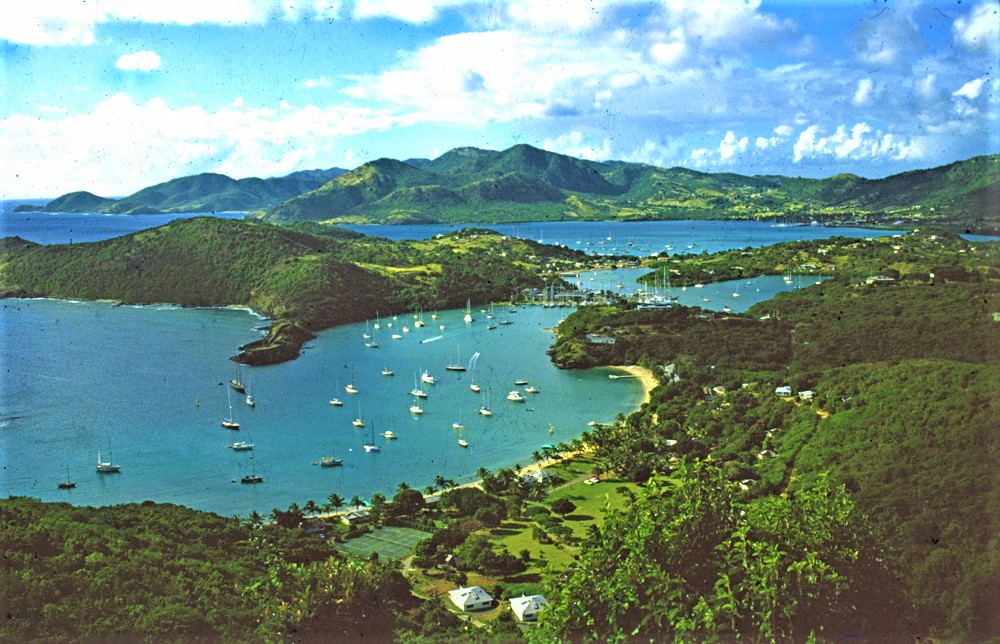 English Harbour is a nearly landlocked harbour and settlement in the far south of the island. The settlement takes its name from the establishment by the Royal Navy of its operations base for the area during the 18th century. It has long been known as a yachting centre and for its superb protection.
English Harbour is a nearly landlocked harbour and settlement in the far south of the island. The settlement takes its name from the establishment by the Royal Navy of its operations base for the area during the 18th century. It has long been known as a yachting centre and for its superb protection.
Nelson's Dockyard, in the centre of the harbour, was abandoned at the turn of the century but had been brought back to life through volunteer efforts led by Commander Nicholson and his family. They were now running a range of businesses based in the old but restored buildings in the complex including a slipway, chandlery and charter operation.
Ordnance Bay, where we first anchored, is one of the most  romantic-sounding places for all those who have read the writings of famous sailors such as our friends the Hiscocks and other pioneering small-boat voyagers. It is the innermost part of English Harbour. Incredibly, at this time, we were the only “real” cruising yacht at anchor in the bay. There were plenty of boats in the vicinity, of course: most were charter yachts, sail and power, of great opulence, tied up to the wall at Nelson’s Dockyard and running powerful generators to keep up with their air conditioners and other modern necessities.
romantic-sounding places for all those who have read the writings of famous sailors such as our friends the Hiscocks and other pioneering small-boat voyagers. It is the innermost part of English Harbour. Incredibly, at this time, we were the only “real” cruising yacht at anchor in the bay. There were plenty of boats in the vicinity, of course: most were charter yachts, sail and power, of great opulence, tied up to the wall at Nelson’s Dockyard and running powerful generators to keep up with their air conditioners and other modern necessities.
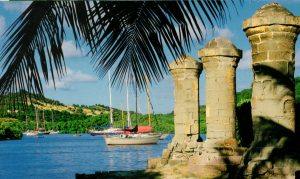 There were some cruising yachts around, of course, but most were anchored further down the bay and nearer the sea off the beach in Freemans Bay, where the wind is fresher and the water a bit clearer. Others were round in Falmouth Harbour, again where the swimming and beaches are better for families and holiday-makers. But we liked Ordnance Bay, very peaceful and encased by mangroves, and the flat calm was a great relief from several weeks of rolly anchorages and heavy-duty seagoing.
There were some cruising yachts around, of course, but most were anchored further down the bay and nearer the sea off the beach in Freemans Bay, where the wind is fresher and the water a bit clearer. Others were round in Falmouth Harbour, again where the swimming and beaches are better for families and holiday-makers. But we liked Ordnance Bay, very peaceful and encased by mangroves, and the flat calm was a great relief from several weeks of rolly anchorages and heavy-duty seagoing.
We were soon visited by Mike and Wendy Frank, an experienced Australian couple who were skippering a beautiful Swan 59, Insensatez. They were between charter guests, whom they had to treat like royalty, and were happy to spend time with cruising Aussies.
 Antigua is now a fine landfall island for yachts, with good facilities in English Harbour, including the surprisingly good Carib Marine supermarket, laundry tubs, and a cheap and frequent bus to the main town, St Johns. The morning after we arrived we took the bus across the island to St Johns, riding through several small villages with colourful wooden houses. One such village was called Liberta, a place for freed slaves. The scenery was generally green and lush, and from the hills we could see the many bays and reefs round the island.
Antigua is now a fine landfall island for yachts, with good facilities in English Harbour, including the surprisingly good Carib Marine supermarket, laundry tubs, and a cheap and frequent bus to the main town, St Johns. The morning after we arrived we took the bus across the island to St Johns, riding through several small villages with colourful wooden houses. One such village was called Liberta, a place for freed slaves. The scenery was generally green and lush, and from the hills we could see the many bays and reefs round the island.
In the town there were more simple shops and stalls by the roadside. We found the Amex office and picked up a huge pile of mail - after a worrying period while they were looking for it. On the waterfront there were more facilities and boutique stalls for passengers from cruise ships.
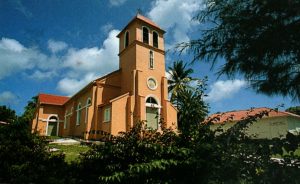 The cathedral on a hilltop had a lovely wooden interior reminiscent of Southern Baptist churches. We visited a very well-presented museum, excellent for such a little place, with information about the original settlers, the Arawak people. The local people we encountered in the bus and shops were cheerful and friendly. The older women looked as though they had stepped out of photos of the old slave times, singing along with the gospel music.
The cathedral on a hilltop had a lovely wooden interior reminiscent of Southern Baptist churches. We visited a very well-presented museum, excellent for such a little place, with information about the original settlers, the Arawak people. The local people we encountered in the bus and shops were cheerful and friendly. The older women looked as though they had stepped out of photos of the old slave times, singing along with the gospel music.
The bus back looked in good order but punctured its left front tyre along the road. It carried no spare, so we all got out and packed into a smaller bus that went out of its way to take us to English Harbour. We were back aboard by lunchtime and got started on responding to the mass of mail.
After a showery period we took ourselves out for a day's anchor in Freemans Bay, where we snorkelled to thoroughly clean the bottom of the boat's hull. We took a walk up to Shirley Heights, with a wonderful view of English Harbour, its bays and Nelson's Dockyard. There were several old ruins along the path, with cactus growing among thorny scrub, and with a few little brown animals running around.

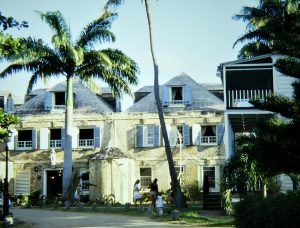 Christmas Eve was a productive day, getting stuck into letter writing and some sail repairs. By this time we were getting friendly with crews from many other boats at the Dockyard, and we were invited to a Christmas dinner by Colin and Virginia, from Melbourne and Brisbane, in their capacious yacht Magnum. This was a long and very enjoyable evening.
Christmas Eve was a productive day, getting stuck into letter writing and some sail repairs. By this time we were getting friendly with crews from many other boats at the Dockyard, and we were invited to a Christmas dinner by Colin and Virginia, from Melbourne and Brisbane, in their capacious yacht Magnum. This was a long and very enjoyable evening.
On Christmas Day we had an early lunch in preparation for a big shore party for all, complete with champagne. Most of the party-goers were young crews from charter boats, and it got pretty noisy. We looked around for a couple more of our age, and thus met Philip (an oil-well insurance magnate) and Heather Rolf. They invited us aboard their yacht for drinks.
To our amazement this turned out to be Aleta, at the time the most admired vessel in English Harbour. She was a gorgeous Perini Navi ketch, 40 metres overall, built in 1984 with a steel hull and aluminium superstructure. With drinks in hand we climbed up to the bridge, where in addition to the usual manual and electric controls and navigation instruments, there was large panel 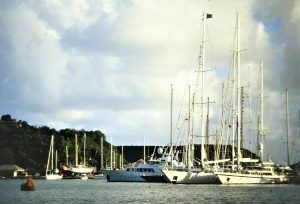 with press buttons and a schematic of the sail and rigging gear. The yacht was one of the first to have a complete captive winch system, with all sails controlled from this position. While I was studying the diagrams Philip asked me, "do you understand all this?" I said I got the picture, and he responded by complaining that his captain wouldn't let him up on the bridge. "Could you run this yacht?", he asked. I said I thought I could, given a good crew.
with press buttons and a schematic of the sail and rigging gear. The yacht was one of the first to have a complete captive winch system, with all sails controlled from this position. While I was studying the diagrams Philip asked me, "do you understand all this?" I said I got the picture, and he responded by complaining that his captain wouldn't let him up on the bridge. "Could you run this yacht?", he asked. I said I thought I could, given a good crew.
During a long session drinking in the vast saloon below, Philip complained again that he did not like either the captain or his partner the chief steward, and suggested that we might like to take over these duties. He would pay us anything we liked, in any currency in any bank in the world. He would also pay for Cera's stay in English Harbour. We could then take him and his wife anywhere we wanted in the world. He would rather have friends run the boat than strangers he didn't get on with. We let this unusual and unexpected job offer lie, while the afternoon drinking continued!
After a showery night we cleared Customs and with the Dockyard, and moved out of English Harbour, round to the west a short distance, and up into the much bigger and open bay of Falmouth Harbour. We were treated by rain and heavy gusty wind, so Norma got straight into catching water. She rinsed the saloon carpet in the dinghy, getting some of the Saharan sand out!
After another showery night we started off due south to the big conjoined twin islands of Guadeloupe, the next stop in our series of sails down the Caribbean chain of the Leeward and Windward islands of the Antilles.
This was a fast day sail of about 40 nautical miles. Guadeloupe is an overseas department and region of France, which means that it has exactly the same status as mainland France's regions and departments, and essentially the same laws and officialdom.
We got wet in heavy rain as we sailed into Anse Deshaies, a few miles down from the north-west tip of the main island. It was an attractive bay, with a pleasant-looking village ashore, but open to the sea to the west. This meant that when the prevailing east wind dropped we turned sideways to the swell and got rolled around. In steady heavy rain we stayed aboard and left the next morning.
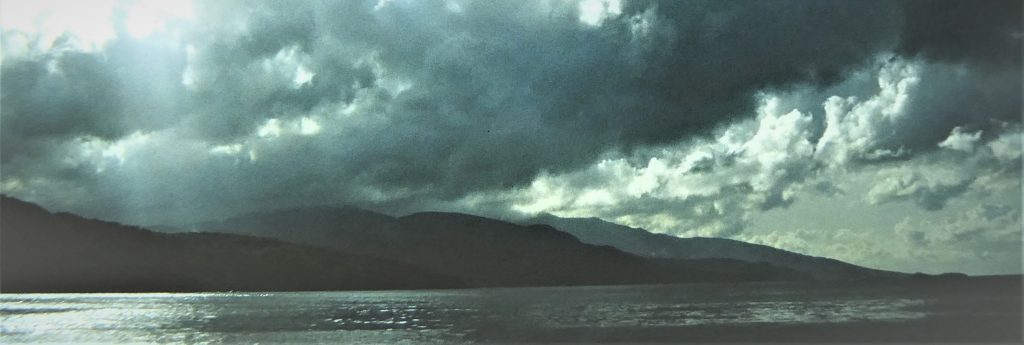 We motored further south down the west coast of Guadeloupe past dark green forests down the sides of steep, forbidding hills, reminding us of the island of Beqa in Fiji. The narrow beaches were of black volcanic sand. We kept close to the coast as we passed the main settlement, Basse Terre, to avoid the gusty south-east wind that was barrelling over the hills and round the southern tip of the island.
We motored further south down the west coast of Guadeloupe past dark green forests down the sides of steep, forbidding hills, reminding us of the island of Beqa in Fiji. The narrow beaches were of black volcanic sand. We kept close to the coast as we passed the main settlement, Basse Terre, to avoid the gusty south-east wind that was barrelling over the hills and round the southern tip of the island.
About eight nautical miles south of the main island lie a collection of small islands, the Iles des Saintes. As we cleared Guadaloupe's 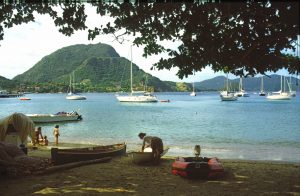 southern tip and started the crossing to the Saintes we were hit by the prevailing 20-25 knot Caribbean south-easterly, very close to our intended course. So, we motor-sailed across, a very bumpy and wet ride indeed.
southern tip and started the crossing to the Saintes we were hit by the prevailing 20-25 knot Caribbean south-easterly, very close to our intended course. So, we motor-sailed across, a very bumpy and wet ride indeed.
We anchored off the main town of the group, Bourg des Saintes, with islands to be seen all around. The water 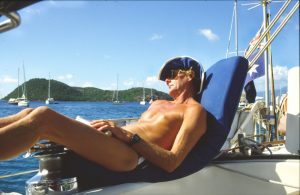 was clear and the protective surroundings were pretty, but the gusty wind tossed us around a bit.
was clear and the protective surroundings were pretty, but the gusty wind tossed us around a bit.
We took a walk ashore around the little town to check in with the gendarmes, and returned to the boat as the showers came in. It was a turbulent night, and although it was 85 degrees F in the morning it felt cooler in the wind. We did some limited shopping ashore and walked up to Fort Napoleon on the hill behind the village. The weather improved during the day, and we were able to sit out in the sun. We also did some swimming and cleaning under the boat: the antifouling paint was not working at all by now.
After this couple of rather restless nights we pulled out through a pass to the south between the islets for another blast across the trades, this time to the island of Dominica.
The Commonwealth of Dominica is an independent island country in the Caribbean. The island was settled by the Arawak from South America in the 5th century. It was later colonised by Europeans, predominantly by the French, who imported slaves from West Africa to Dominica to work on coffee plantations. Great Britain took possession in 1763 after the Seven Years' War, and it gradually established English as its official language. The island gained independence as a republic in 1978.
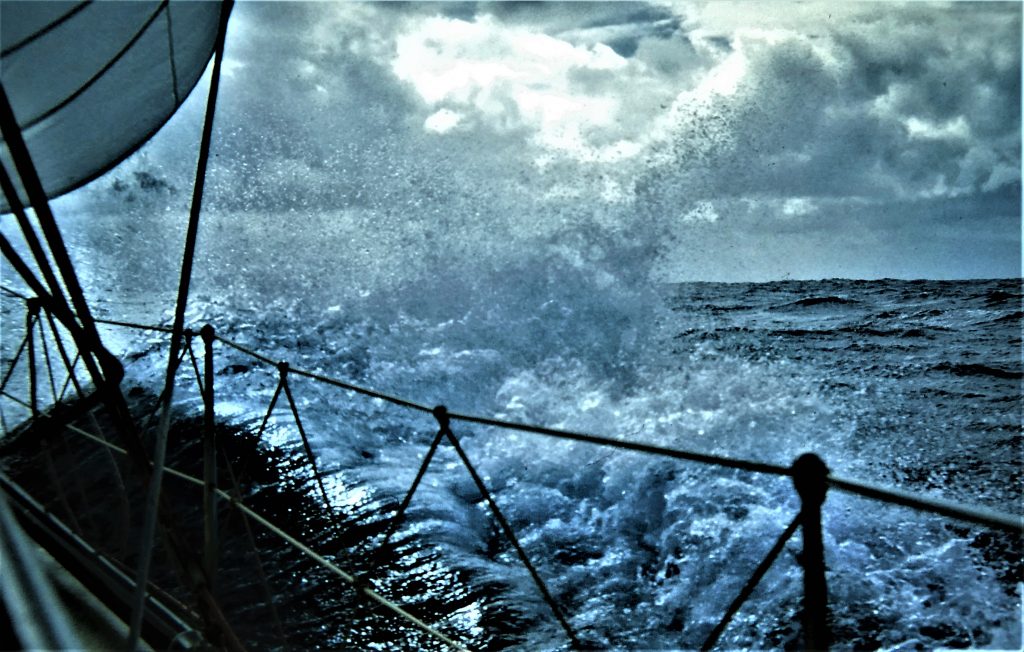 As we started the crossing the wind was up to 25 knots, and we reduced sail to a number three headsail and a well-reefed main. The wind soon increased to about 30 knots, and we got very wet as the waves broke across us.
As we started the crossing the wind was up to 25 knots, and we reduced sail to a number three headsail and a well-reefed main. The wind soon increased to about 30 knots, and we got very wet as the waves broke across us.
Late in the morning we came into the lee of Dominica and approached a headland near its northern end, Prince Rupert bluff. It was shrouded by veils of rain. We rounded the bluff into the wide expanse of Prince Rupert Bay, blasted by some truly vicious squalls as we did so. Our cruising 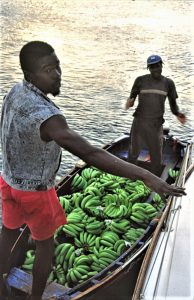 guide warned us that “a real bagful of wind can be encountered here”, and a “tremendous sail can be enjoyed . . . Hang on to Grannie, though!”
guide warned us that “a real bagful of wind can be encountered here”, and a “tremendous sail can be enjoyed . . . Hang on to Grannie, though!”
It was all a bit much for us, but we ended up into the north-west corner of the bay and anchored in quite calm water. We were immediately approached by several boys in little boats, wanting to take us for a ride up the Indian River, which flows into the bay. Other locals sold us some green bananas. We moved out very early in the dark the next morning, cautiously avoiding the many fishing buoys and anchored banana ships.
The western shores of Dominica looked typically dark and gloomy. There were small villages and wooden shacks at intervals along the beach, many at the ends of deep clefts in the hillsides with rivers running through.
Clearing the southern end of the island we were again down to our smallest working headsail and two reefs, more rugged sailing in a close reach, 25 knot winds and two-metre seas.
In the early afternoon we came into the lee of Mont Pelee, the volcanic northern part of the next island, Martinique, and its associated little archipelago. Further down, we entered the big Baie de Fort de France and anchored in the Baie de Flamandes on 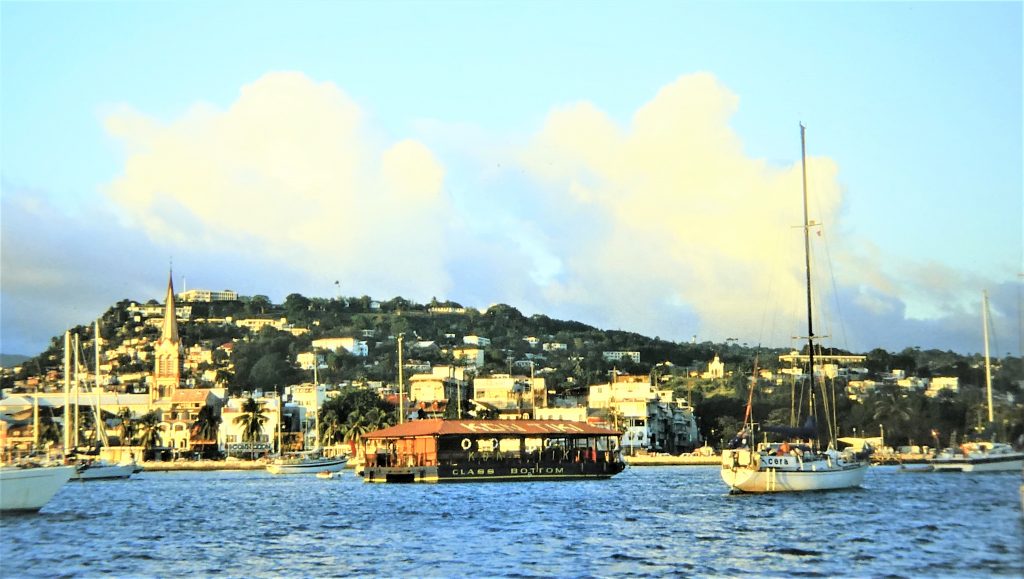 the north side of the bay and off the capital of the island. It had been another rugged day’s sailing!
the north side of the bay and off the capital of the island. It had been another rugged day’s sailing!
Martinique has the same international status as Guadeloupe, essentially being a little bit of France in the Caribbean. It is known for its rugged landscape.
There was swell rolling into the anchorage from the west, to which it was open, and the motorboats whizzing around didn’t help. The town itself was all shut up, as this was New Year’s Eve. The date also meant, of course, that overnight we were greeted by sirens, horns, flares and some fireworks.
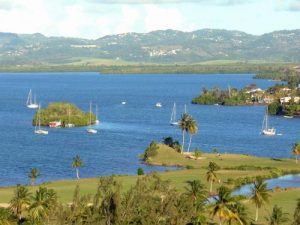 The next morning we faced the reality that we would be back home in Sydney some time later this year, 1989.
The next morning we faced the reality that we would be back home in Sydney some time later this year, 1989.
We went ashore to clear in and out, and then in company with a Kiwi yacht motored across the Baie de Fort de France to the Pointe du Bout and the Trois Islets. We anchored in shallow water in the lee (but with not much protection) of one of the little mangrove islands. The wind was in the typical 30-knot range for a while, but at least the water was flat, so all we got was spray. There was a village and golf course on the mainland. Norma baked some bread, we had beers on a Kiwi boat, and the we walked into the village: pretty basic, but with a post office and market. That night was the best and most peaceful we had had for days and days. We spent the following day peacefully aboard.
But then we had to return to the Fort de France anchorage to go to the town to change money and do some serious shopping for food, beer and wine, which we had been told was cheaper there. It was all very busy, with long queues, but the supermarket was good. We spent the night here, quite peaceful once the ferries stopped, and then sailed out of the bay early the next morning.
As we sailed down the Antilles chain we became intrigued and often frustrated by the differing ways their local administrations dealt with the formalities – such as police and Customs – depending on their cultural and legal histories. St Lucia did have a colonial British feel about it, rather than French. Between our yachty friends, the shorthand version of this division was that some islands were “French” and others “British”.
Our next stop was to be the island of St Lucia. The French were the first Europeans to settle here, signing a treaty with the native Island Caribs in 1660. England took control of the island from 1663 to 1667. In ensuing years, it was at war with France fourteen times, and the rule of the island changed frequently. Representative government came about in 1840, and in 1979 Saint Lucia became an independent state with a legal system based in part on English common law.

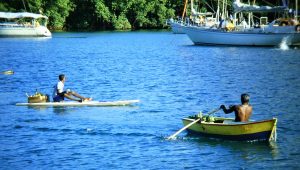 We had an unusually very pleasant sail 40-mile down from Martinique and along the west side of St Lucia to the entrance to Marigot Bay. This was almost invisible from the north, but the narrow channel was soon apparent and the entrance to the well-protected inner bay easy.
We had an unusually very pleasant sail 40-mile down from Martinique and along the west side of St Lucia to the entrance to Marigot Bay. This was almost invisible from the north, but the narrow channel was soon apparent and the entrance to the well-protected inner bay easy.
We enjoyed a peaceful afternoon in this lovely but quite small anchorage. Several more boats came in and it got pretty crowded, with up to 60 boats crammed in during the nights we were here. All were soon attended by scores of young local men in canoes offering us bananas, papayas, woven hats and baskets. They did soon learn who among us were long-distance cruising sailors and were a lot less likely to buy “souvenirs” than those on the charter boats. But we were still happy to purchase decent fruit and vegetables.
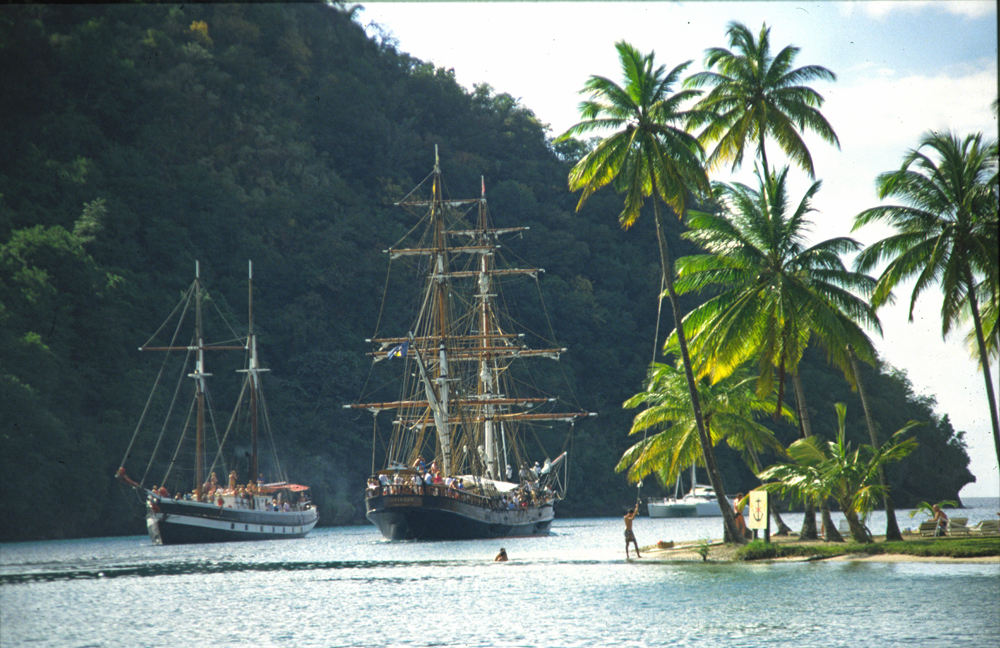 The next day it was oily calm. The inner bay has steep sides, a large part of which is fronted by thick mangroves. On the spit of land between us and the outer bay there were palm trees and a small base for the Moorings charter fleet. On the south side there were a few shops, a wharf and two small, inconspicuous hotels. There was plenty to watch all day, boats in and out including a few larger charter vessels including a square-rigger.
The next day it was oily calm. The inner bay has steep sides, a large part of which is fronted by thick mangroves. On the spit of land between us and the outer bay there were palm trees and a small base for the Moorings charter fleet. On the south side there were a few shops, a wharf and two small, inconspicuous hotels. There was plenty to watch all day, boats in and out including a few larger charter vessels including a square-rigger.
It was a great little anchorage but we were keen to keep going, so after a couple of nights we started out early and sailed down the steep green western coast, swathed in rain, big black clouds overhead. We could see a few beachside settlements, shacks of wood and corrugated iron. Local fishermen were out setting nets, using narrow wooden canoes, some with powerful (subsidised) Yamaha outboards.
Just south of the capital town of Soufrieres, which sits at the head of an open bay, we passed the famous Pitons, tall twin peaks towering into the clouds, a very impressive sight. There is a so-called anchorage there, whereby you drop anchor just offshore and take a line ashore to a palm tree – or, rather, have a line taken ashore for you by a small boy demanding money!
There were a few yachts there when we passed, some probably to see the elephant on the beach. The elephant was called Bupa, which we learnt was the pet of the third Lord Glenconner. We did not fancy the stop and did not see the elephant, which was rather a pity.
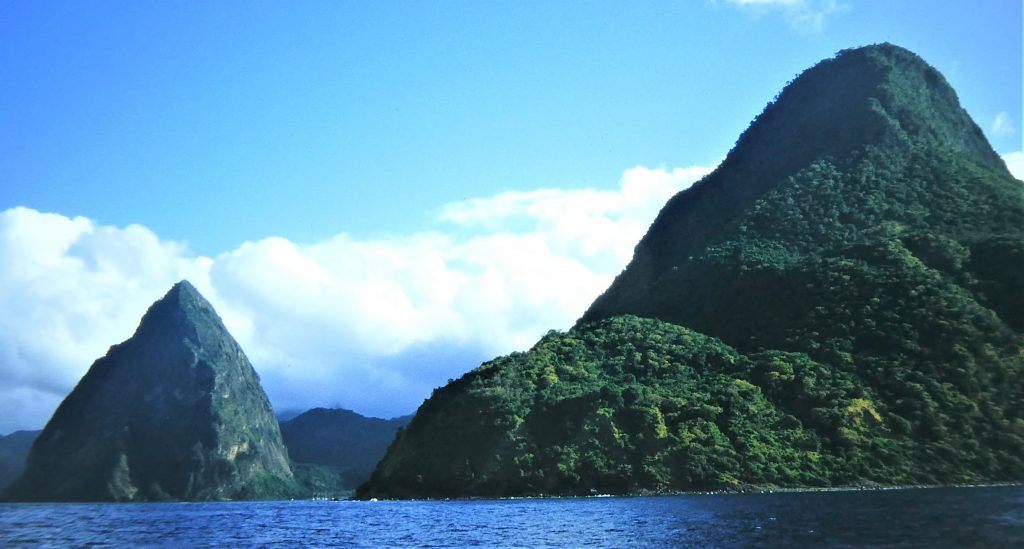
As warned by our cruising guide there were choppy seas and little wind as we cleared the island in swirling currents. The main halyard ruptured at the original rope-to-wire splice as the mast was whipping to and fro, and we replaced it by the topping lift to keep us going. Clear of the island we were sailing nicely in hazy conditions. We were now in the Windward Islands, where the sailing conditions and prevailing wind direction were held to be generally less stressful than further north.
We were then sailing for the St Vincent and Grenadines. This independent territory, with a British colonial history, consists of the main island of Saint Vincent and, south of that, two-thirds of the northern part of the Grenadines, a chain of 32 smaller 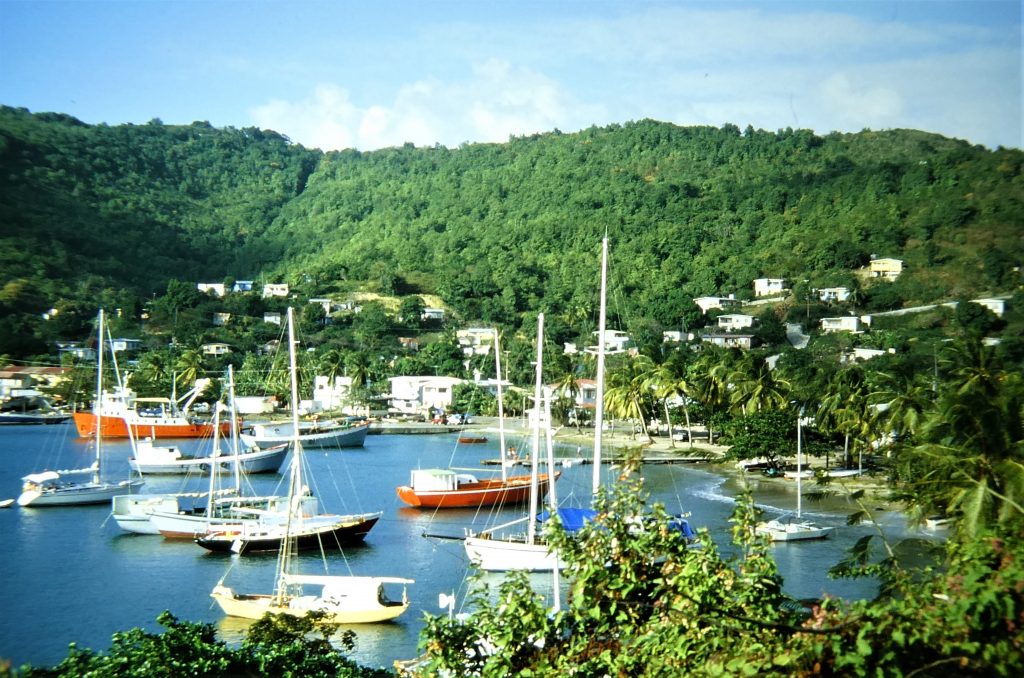 islands. We sailed down the east (windward) side of the large St Vincent Island in bumpy seas, watching the heavy white surf breaking on the rocky shores, and on to the smaller island of Bequia.
islands. We sailed down the east (windward) side of the large St Vincent Island in bumpy seas, watching the heavy white surf breaking on the rocky shores, and on to the smaller island of Bequia.
We anchored in the capacious Admiralty Bay, on the west side of the island. At the head of the bay lay the settlement of Port Elizabeth.
This is one of the most popular anchorages in the Antilles with both live-aboard cruisers and charterers. When we arrived it looked full up. Many of those with whom we had become great friends along the way were there, so we were soon sharing drinks and food on our boat and theirs. It was not perfect, of course: some swell was running in, and on arrival it was cloudy and raining. But when going to bed early, we could see stars in the skies.
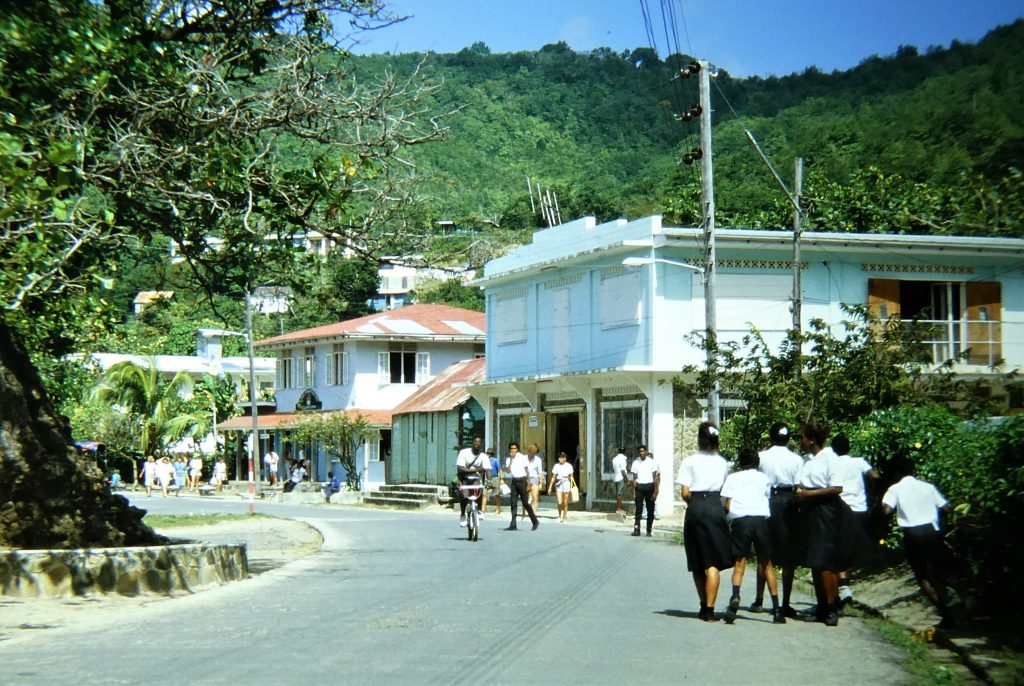 Ashore early the next morning, we found a one-street village with a few shops for sufficient provisions, and the local people were friendlier than on some of the other islands.
Ashore early the next morning, we found a one-street village with a few shops for sufficient provisions, and the local people were friendlier than on some of the other islands.
The contrast between rich and poor is always a potential problem where yachts gather, and unfortunately some of the people who cruise the Caribbean, including the one- or two-week charterers, are far less sensitive about such issues than the average long-distance cruisers. For instance, after one approach and a light hearted brush-off, the kids waiting on the beach to “look after” our dinghy would leave us alone; but they would pester the charterers unmercifully, ending either in friction or the extortion of more cash than their parents would earn in a day.
A splendid shop sold locally-made models of whaling boats and other sailing craft. They were carved from solid by eye, with outstanding craftsmanship – but at a price we couldn’t justify. They were one of the few souvenirs that we would really have liked to buy out here.

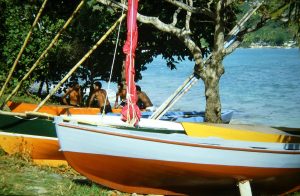 In improving weather we walked over the hills to Friendly Bay on the southern side of the island. This had been the site of a whaling station, but there was nothing to see of that now. What was interesting was a collection of small boatyards, for both building and maintenance, and for fishing ands sailing. Most of them featured most colourful and attractive paint jobs, for which the local men were justifiably very proud.
In improving weather we walked over the hills to Friendly Bay on the southern side of the island. This had been the site of a whaling station, but there was nothing to see of that now. What was interesting was a collection of small boatyards, for both building and maintenance, and for fishing ands sailing. Most of them featured most colourful and attractive paint jobs, for which the local men were justifiably very proud.
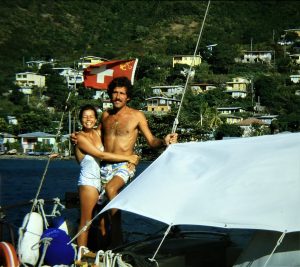 Most evenings, while chatting with friends, we watched the efforts of charterers’ efforts to set their anchors securely and safety in a way that would not threaten us! One did hit our bow and damage a navigation light, but nothing serious. Going ashore one afternoon in the dinghy, I asked a young woman on one of the charter yachts, “are you having a good time?”. “I think so”, she replied!
Most evenings, while chatting with friends, we watched the efforts of charterers’ efforts to set their anchors securely and safety in a way that would not threaten us! One did hit our bow and damage a navigation light, but nothing serious. Going ashore one afternoon in the dinghy, I asked a young woman on one of the charter yachts, “are you having a good time?”. “I think so”, she replied!
After a windy night we motored over to the other (north) side of the bay, which we had noted seemed to be less prone to the swell rolling in. Also, our friends Rudy and Lilian in Shiva were over there, and we anchored nearby. We swam and did some bottom cleaning, and got on with some basic maintenance including the difficult job of redoing the rope-to-wire splice for the main halyard, then re-threading it through the mast.
On the fifth morning we waved fond farewells to Shiva, who were by then planning their voyaging back home to the Mediterranean. We were away to the south, and sailed out into a warm, dry and windy day under headsail only.
We made good time down to the Tobago Cays. This is an archipelago located in the Southern Grenadines of Saint Vincent and the Grenadines, and comprises five small islands and extensive coral reefs. The whole collection is surrounded by a  protective semicircle formed by the World’s End and Horseshoe coral reef to their east.
protective semicircle formed by the World’s End and Horseshoe coral reef to their east.
The Tobago Cays were reputed to be the hardest group in the Antilles for navigation, and some charter companies would not allow their customers to sail there. Eyeball navigation was essential, as the channel marker positions (and even their very existence) were very unreliable. The group is nevertheless very popular and includes probably the most photographed and publicised anchorages in the Antilles.
We worked our way through the outlying shoals and reefs and between the small Rameau and Bateaux mangrove-on-coral islands, and joined what looked like the biggest group of anchored yachts south-west of Baradal island.
It was a pretty outlook from the anchorage across bright blue waters and out to the surf breaking on the outer rim of the reef. Beyond that, the nearest land was in central Africa. But the wind, the “Winter Trade”, continued its unrelenting pressure, whistling in the rigging. We took the dinghy out to the reef for some snorkelling, for the first time in a while. There was quite good coral to be seen, and lots of fish. It was a disturbed night, the wind rock steady at about 25 knots, the boat bouncing in the chop.
 We motored away from the group through a channel to the south west and down to Union Island, the principal island and anchorage in the Northern Grenadines. We anchored in the innermost part of the Clifton Harbour to try to get out of the wind. The surroundings looked lovely: there were a few islets scattered around, a palm-fringed beach, mangroves and the little town.
We motored away from the group through a channel to the south west and down to Union Island, the principal island and anchorage in the Northern Grenadines. We anchored in the innermost part of the Clifton Harbour to try to get out of the wind. The surroundings looked lovely: there were a few islets scattered around, a palm-fringed beach, mangroves and the little town.
We went ashore to Clifton at the dinghy dock by the hotel and checked in at Customs all over again. There were basic stores in wooden shops along the dirt road, and locals lounging around with their funny attitude: disdainful at first but friendly when engaged. We had to go to the neighbouring airstrip for more official clearance, this time with immigration.
We still got kept awake by wind in the rigging again that night, so moved off again early for Grenada, the southernmost of those Lesser Antilles islands that we were planning to visit. It turned out to be a most enjoyable farewell to the chain. We had a fast sail south in squally winds and showers, passing to the west of Carriacou and then down the thickly forested west coast of Grenada, which we could only just see between the heavy showers of rain!
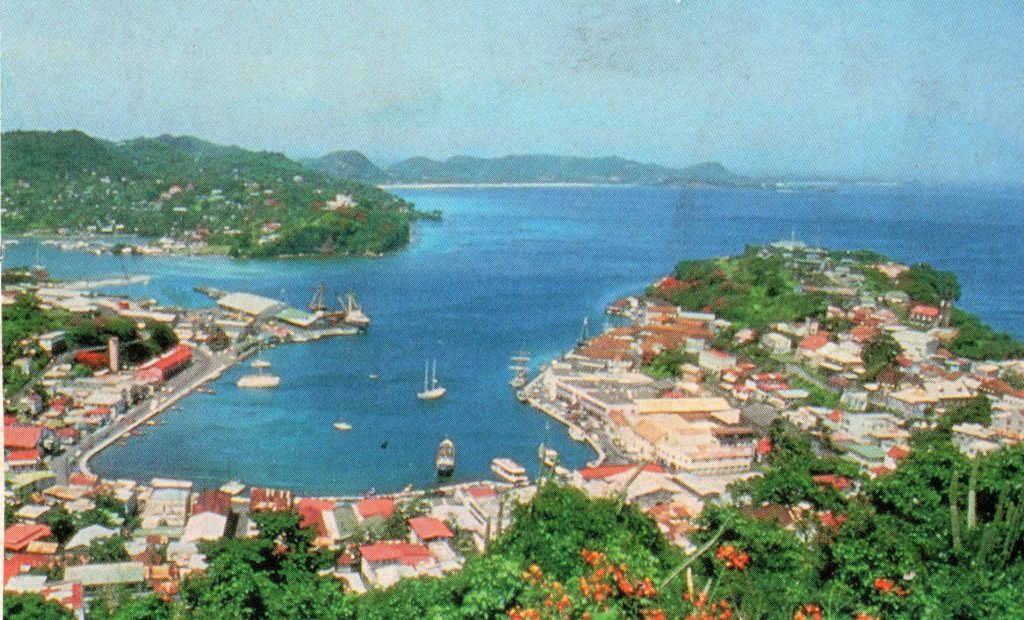 We rounded a headland and turned into St George’s Harbour, near to the southern end of the coast. Houses and warehouses were spilling down the headland slopes, topped by a fort. We passed through the outer harbour and turned through a narrow but well-marked dredged passage into the inner harbour, known as Le Lagon.
We rounded a headland and turned into St George’s Harbour, near to the southern end of the coast. Houses and warehouses were spilling down the headland slopes, topped by a fort. We passed through the outer harbour and turned through a narrow but well-marked dredged passage into the inner harbour, known as Le Lagon. 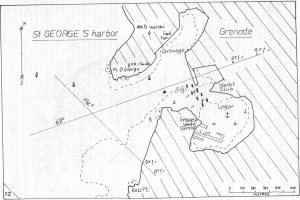
This nearly landlocked bay was a recognised hurricane hole and a very popular anchorage. We anchored near friends off a broken-down wharf at the Grenada Yacht Services boatyard.
Grenada is the southern-most of the larger Grenadine islands. It has had a rather turbulent history. Following several unsuccessful attempts by Europeans to colonise the island due to resistance from the indigenous Caribs, French settlement and colonisation began in 1649 and continued for the next century. In 1763, Grenada was ceded to the British under the Treaty of Paris. British rule continued until 1974, when independence was granted under the leadership of the high-living “Sir” Eric Gairy, who became the first Prime Minister of Grenada.
Civil disorders starting in 1973 then stopped most cruising yachts visiting the island because of fears of theft and boarding. In 1979, the Marxist–Leninist New Jewel Movement overthrew Gairy's dictatorship in a bloodless coup d'état and established the People's Revolutionary Government, headed by Maurice Bishop as Prime Minister and supported by Cuba’s Fidel Castro. Bishop was then arrested and executed by members of the People's Revolutionary Army, prompting an American-led invasion in 1983. 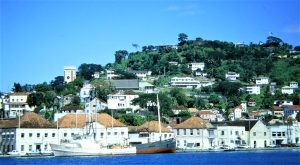 Since then, the island has returned to a parliamentary representative democracy and has remained politically stable. We did not find the local people anything other than upstanding, warm and friendly, indeed more so than in some other places in the Antilles.
Since then, the island has returned to a parliamentary representative democracy and has remained politically stable. We did not find the local people anything other than upstanding, warm and friendly, indeed more so than in some other places in the Antilles.
We much enjoyed a peaceful night with no howling wind! The morning was calm under blue skies. We took the dinghy over to the town the other side of the main harbour, and tied up very conveniently right in front of the waterfront supermarket. We walked up and over the hill to the produce market, a shambolic and very colourful place indeed. In fact, the whole town was very attractive by Antilles standards.
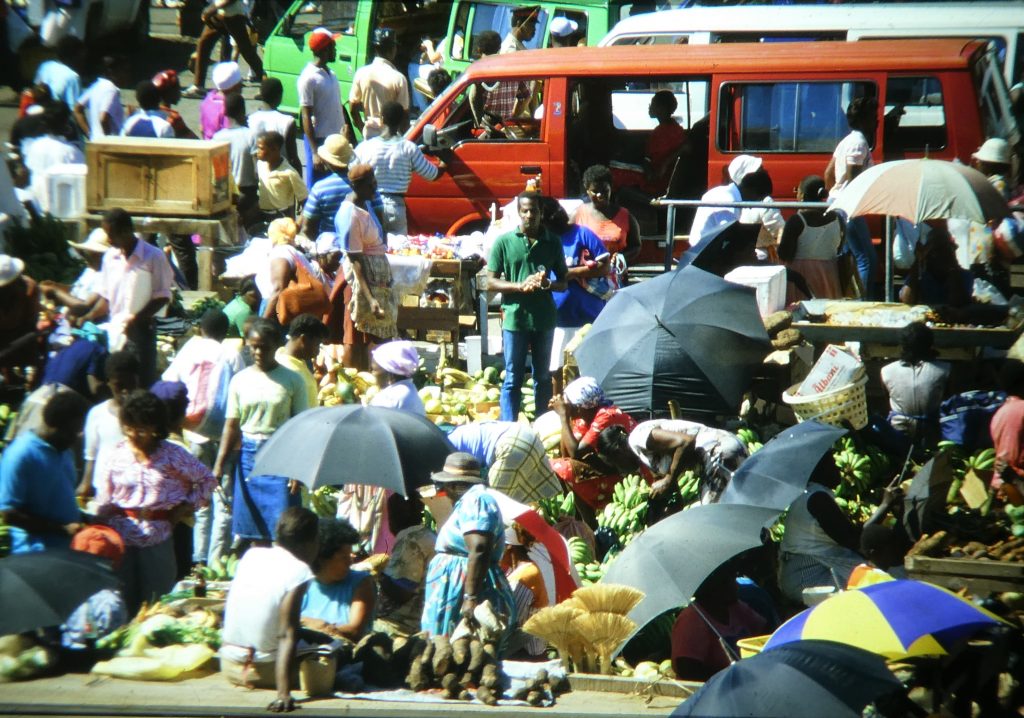 We did some mast maintenance in the afternoon and then started the inevitable round of socialising in such a gathering place. We met again with old friends and made new, including a well-known yachting writer, Frank Mulville.
We did some mast maintenance in the afternoon and then started the inevitable round of socialising in such a gathering place. We met again with old friends and made new, including a well-known yachting writer, Frank Mulville.
After a couple of rainy days on board, mostly letter writing, we walked up to the Venezuelan embassy to deal with the paperwork required for entry to that country – a great deal of paper! We returned for a fabulous and beautifully presented dinner prepared by Wendy and Mike on Insensatez, the 59-ft Swan they were skippering and whom we had met in English Harbour. We felt privileged, but they said they preferred looking after friends than charter guests!
We took a run in a minibus over to the town of Grenville, on the eastern side of the island. It was a beautiful ride over the volcanic mountains and hills of the centre, with thick, green undergrowth around plantations of bananas, papaws, sugar and nutmegs. A lake was glimpsed in the crater of the central peak. Our fellow passengers, all locals, were a cheerful and friendly lot.
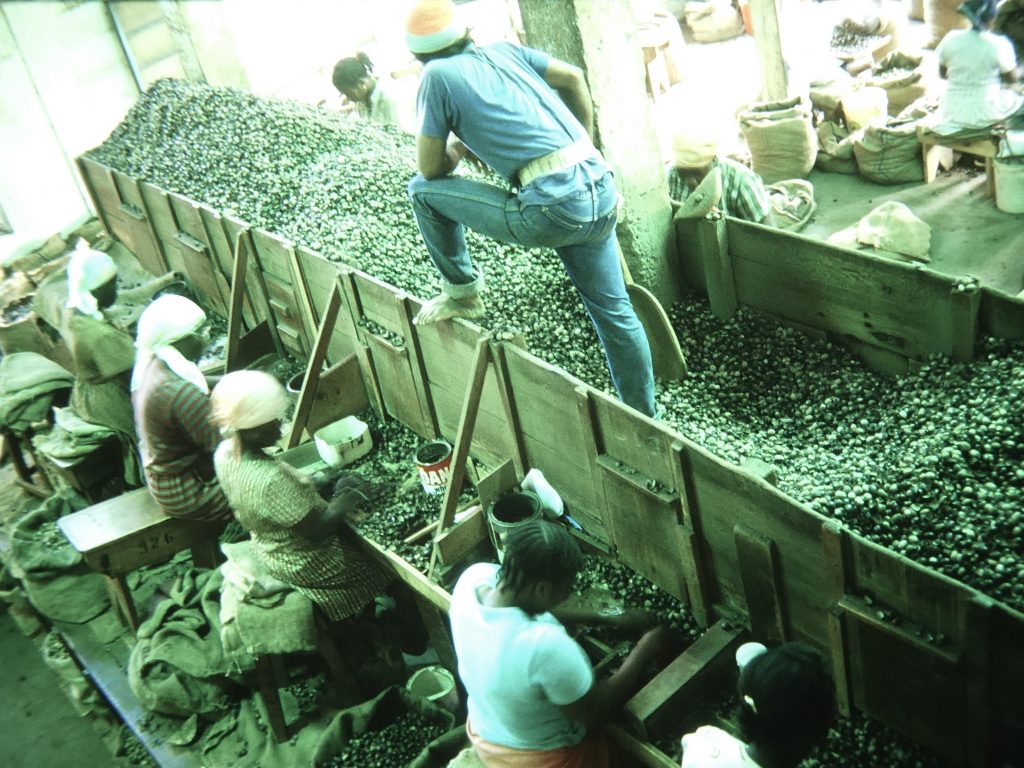 A German lady on the bus, who lived on Carriacou, took us to the “nutmeg factory”. Grenada has long been known as a spice island, and their sale does go to help the fragile economy. We saw women sorting the nutmegs, grating them, floating out second-grade ones, and using a simple machine for shelling them. Everything was very simple, and no value was being added; the processing into oils and spices was done overseas. The noise of rattling nuts rang in our ears.
A German lady on the bus, who lived on Carriacou, took us to the “nutmeg factory”. Grenada has long been known as a spice island, and their sale does go to help the fragile economy. We saw women sorting the nutmegs, grating them, floating out second-grade ones, and using a simple machine for shelling them. Everything was very simple, and no value was being added; the processing into oils and spices was done overseas. The noise of rattling nuts rang in our ears.
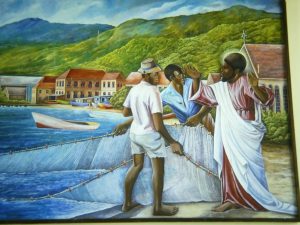 We returned to Grenville town for a walk around, including a visit to the Anglican church with a picture of a black Jesus.
We returned to Grenville town for a walk around, including a visit to the Anglican church with a picture of a black Jesus.
The return bus took a different route on the ride back, running for a while down the eastern coast with its fringing reef and no harbour. We drove through several hamlets, mostly just wooden boxes perched on spindly concrete legs. We thought they looked easy to repair after hurricane damage. We passed more extensive sugar plantations, with groups of coloured workers looking just like old pictures of slaves in the sugar fields. Groups of young men wearing colourful woollen bonnets were lounging around small shops and bars.
After five interesting and happy days with many friends in the “lagoon” we got permission from Customs to move down to another anchorage on the southern shores, Prickly Bay. There was a substantial surge rolling into the main part of the bay near the settlement and bars ashore, so we rounded an easily-seen shoal to an extension up in the north-west corner. We anchored in the lee of a steep headland, with mangroves and palm trees down by the waterside. It was peaceful and quite hot.
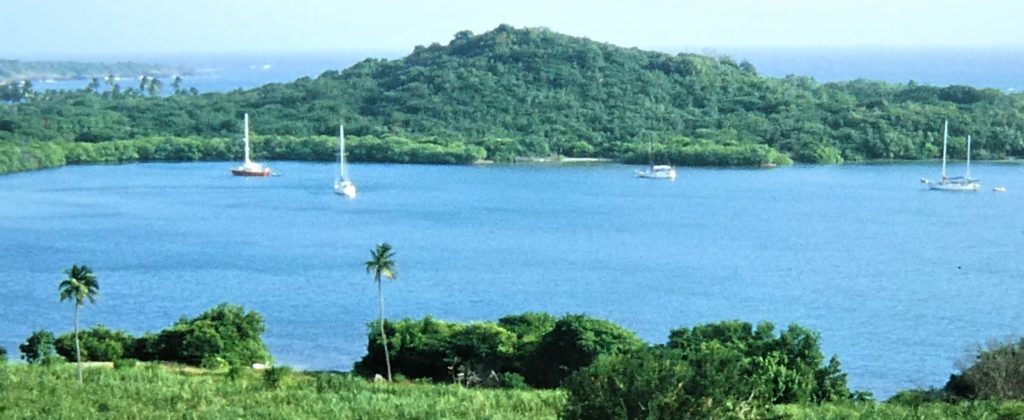
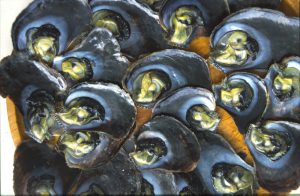 It was still rolly overnight, so we moved further along the southern coast, bucking into an awful chop, and eyeballed through a complex set of reefs into a well-protected bay between the mainland and Hog Island. There were only two other boats there in this most attractive anchorage, surrounded by mangroves and palm trees again, and a sugar plantation. Norma was soon ashore, and returned with a bag of mangrove oysters, good and tasty but very small.
It was still rolly overnight, so we moved further along the southern coast, bucking into an awful chop, and eyeballed through a complex set of reefs into a well-protected bay between the mainland and Hog Island. There were only two other boats there in this most attractive anchorage, surrounded by mangroves and palm trees again, and a sugar plantation. Norma was soon ashore, and returned with a bag of mangrove oysters, good and tasty but very small.
We took an afternoon walk north and up to the village of Woburn through yet more fields of sugar cane. Cattle were taking egrets for rides among tall, thin cactus. There were good views over the bay and Hog Island. We had drinks with Brits Malcolm and Rosalyn on one of the other boats.
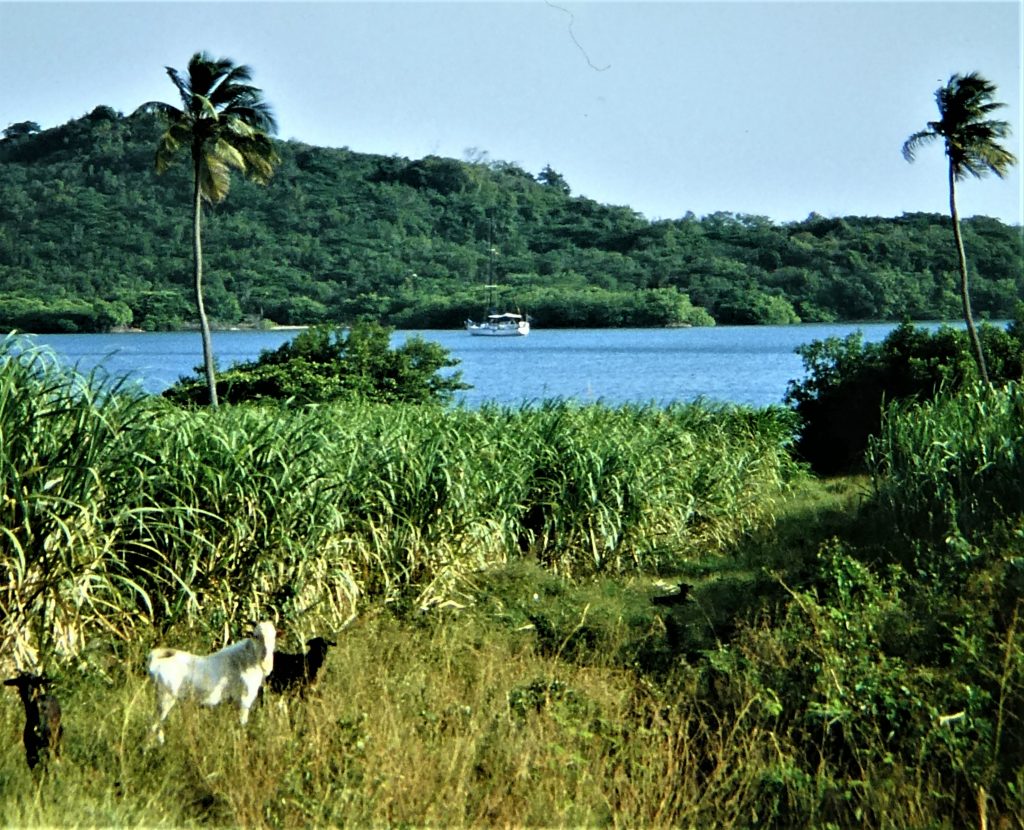 This was a good place for rest and maintenance, and to get ready for the open sea again. We dined well on the British boat, and I had a look at Malcolm’s injured foot. It had been bitten by a wahoo that was lying in the dinghy after he had caught it and thought it was moribund! It was anything but! His foot was healing well, however.
This was a good place for rest and maintenance, and to get ready for the open sea again. We dined well on the British boat, and I had a look at Malcolm’s injured foot. It had been bitten by a wahoo that was lying in the dinghy after he had caught it and thought it was moribund! It was anything but! His foot was healing well, however.
We left the Hog Island anchorage with regret, as it was one the best we had experienced in the whole Antilles. It was here that we really started enjoying ourselves again. But we had to return to Prickly Bay for a night, because the settlement there was also port of entry, and we needed to clear out for Venezuela. The Customs and Immigration officials were surly and contemptuous, which was unusual in Grenada, we had found - their attitude was probably a hangover from the recent turbulent times, we concluded.
On January 24 1989 we sailed for Venezuela.
Venezuela
After a calm and peaceful night we set sail for Isla Margarita, an island off the coast of Venezuela. A small town at the eastern end of the island, Pampatar, is one of the official entry points for the country. To get there we faced an overnight passage of about 130 nautical miles, generally to the south-west.
It started well, sailing wing-and-wing dead downwind, and we soon caught two conveniently-sized nice fish, a rainbow runner and a barracuda. The good wind held in all day. By 10:00 pm we were looking out for the small archipelago of Los Testigos, almost directly in our course. Its lighthouse was flashing in a sequence that was not consistent with our chart, which was a bit confusing but it must have been the right one. Our navigation satellite system decided to go on the blink at an inconvenient time, as usual, but it was a beautiful night’s sail so we were happy simply to keep a good lookout.
Early in the morning we rounded a headland into the wide-open bay off Pampatar. There were a few boats there, as usual some that we already knew. Some swell was rolling in. We rowed ashore and landed in a small surf without getting wet. We had a short chat with a single-handed Brit on the way: he was grumpy about everything in Venezuela, so we didn’t stop to talk for long.
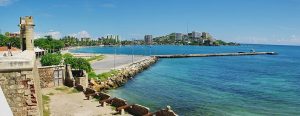 There were only a few basic shops ashore in the town, all with an outback feel about them. We walked to a pleasant-looking Spanish style building that held the Customs office and faced the dour official. He charged us the small entry fee and then tried to charge a higher “boarding fee”, that we declined to pay. Then across to the Guardiana National, who stamped our papers. We then had to walk to the other end of the town, past a large cluster of new condos, to the Immigration office. It was near a fort on the waterfront. They wanted to charge us for entry, but we told them we’d already paid. The next step was to the Port Captain’s office where his overweight assistant told us that we had to clear out when we left the anchorage and to check in at every stop thereafter. (We never did, during our month in the country, and officially we're still there. No-one along the way seemed to mind.) Thus, in all, this “port of entry” had no decent anchorage, no bank to change money, no real facilities, and with officialdom scattered all over the town.
There were only a few basic shops ashore in the town, all with an outback feel about them. We walked to a pleasant-looking Spanish style building that held the Customs office and faced the dour official. He charged us the small entry fee and then tried to charge a higher “boarding fee”, that we declined to pay. Then across to the Guardiana National, who stamped our papers. We then had to walk to the other end of the town, past a large cluster of new condos, to the Immigration office. It was near a fort on the waterfront. They wanted to charge us for entry, but we told them we’d already paid. The next step was to the Port Captain’s office where his overweight assistant told us that we had to clear out when we left the anchorage and to check in at every stop thereafter. (We never did, during our month in the country, and officially we're still there. No-one along the way seemed to mind.) Thus, in all, this “port of entry” had no decent anchorage, no bank to change money, no real facilities, and with officialdom scattered all over the town.
We returned to the boat for a heavy sleep, after which we were joined by our friends Jim and Cindy from Rebel Yell, whom we had first met in Gibraltar and then several times down the Antilles chain.
 After a less rolly night than we had expected we motored a few miles west along the coast to the bigger town of Porlamar to do some shopping. This is a big centre, with masses of high-rise condos, looking a bit like Miami on approach. We landed the dinghy through surf again and walked through the crowded town to the central square and a bank. The Venezuelan supermarket chain is the CaDa, pretty well stocked and very cheap, but we were kicked out at 12:00, siesta time.
After a less rolly night than we had expected we motored a few miles west along the coast to the bigger town of Porlamar to do some shopping. This is a big centre, with masses of high-rise condos, looking a bit like Miami on approach. We landed the dinghy through surf again and walked through the crowded town to the central square and a bank. The Venezuelan supermarket chain is the CaDa, pretty well stocked and very cheap, but we were kicked out at 12:00, siesta time.
We had a pleasant afternoon sail south to Isla Coche, between Margarita and the mainland, and anchored off a long white beach at the west end of the small flat island. Ashore, there were a few palm trees and falling-down shacks. There was a small village a little further south, but in any event this looked like a wild and woolly anchorage. The trade winds became re-established overnight, but the waters remained flat where we were. There were lots of birds around, predominately pelicans; there were hordes on the beach.
Norma went walking on the beach early, as she does, and returned after a long walk along the north side of the island with a good load of clams and other sea shells. We walked together down to the little village of San Pedro and found some defunct salt works and the beginnings of an airstrip. The village was very scruffy, reflecting the country’s current economic slump, with vultures scrabbling around in the garbage being watched by scores of children, surrounded by dogs, goats and pigs. The adobe houses with tiled roofs looked very traditional along the wide dirt roads. The adults had very Central American “Indian” features. There were a few big, old, floppy American cars around. We came to understand that the people were being promised rapid development one year but underwent hard times the next, with disillusionment being the inevitable result.
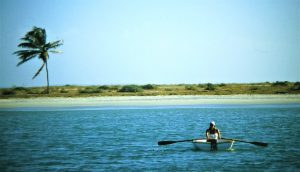
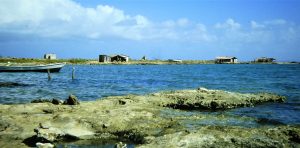 The next stop was only 10 miles away, Isla Cubagua. We again anchored in clear water off a long spit of white sand. There were a few fishermen’s shacks and empty palapas ashore.
The next stop was only 10 miles away, Isla Cubagua. We again anchored in clear water off a long spit of white sand. There were a few fishermen’s shacks and empty palapas ashore.
Rebel Yell joined us later in the afternoon, and the next day we walked the beaches and salt flats of the  eastern part of the island. We visited the site of the first Spanish settlement in Venezuela, Nuevo Cadiz. It was founded in about 1520 and flourished during the days when pearls were abundant. Now, there were only some low walls remaining, and we were stalked by vultures as we walked through the scrub and cactus. There were no permanent settlements anywhere, and the few local people were uncommunicative. We did buy a ray from a fisherman, however, which fed all four of us that evening.
eastern part of the island. We visited the site of the first Spanish settlement in Venezuela, Nuevo Cadiz. It was founded in about 1520 and flourished during the days when pearls were abundant. Now, there were only some low walls remaining, and we were stalked by vultures as we walked through the scrub and cactus. There were no permanent settlements anywhere, and the few local people were uncommunicative. We did buy a ray from a fisherman, however, which fed all four of us that evening.
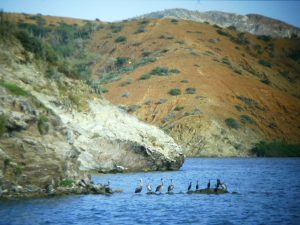 After a worrying squally night in this open anchorage we left early for a very pleasant sail down to the mainland and the large (32-mile long) Golfo de Cariaco. We then had to tack along the gulf to the east in increasing wind, typical of the area and its prevailing weather (as we had found out over several previous weeks). We looked in at a few potential anchorages along the northern shore, but the first acceptable shelter was found in Ensenada Puerto Real. We and anchored in an associated inlet that the cruising guide (Donald Street’s) called Wreck Bay. Sure enough, there were wrecks being dismantled on the beach, and a few fishermen were rushing around in fast outboard-powered runabouts.
After a worrying squally night in this open anchorage we left early for a very pleasant sail down to the mainland and the large (32-mile long) Golfo de Cariaco. We then had to tack along the gulf to the east in increasing wind, typical of the area and its prevailing weather (as we had found out over several previous weeks). We looked in at a few potential anchorages along the northern shore, but the first acceptable shelter was found in Ensenada Puerto Real. We and anchored in an associated inlet that the cruising guide (Donald Street’s) called Wreck Bay. Sure enough, there were wrecks being dismantled on the beach, and a few fishermen were rushing around in fast outboard-powered runabouts.
The scenery was truly wild, with reddish eroded surfaces. There were some scrappy 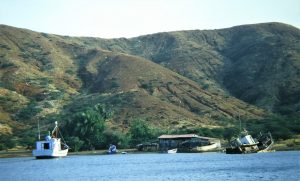 mangroves along the shores. The wind was gusting down into the anchorage, which we were also regarding as a wild and woolly one!
mangroves along the shores. The wind was gusting down into the anchorage, which we were also regarding as a wild and woolly one!
On the way down to the gulf we had caught a very nice bonito, which Norma duly bottled.
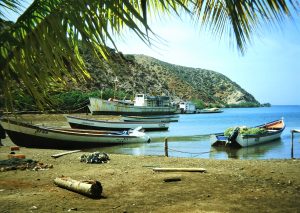 We pulled out early the next morning, and motored into choppy water about four miles further along and into Laguna Chica. We anchored at the inner end off a line of boatbuilders’ palapas, close inshore because of a steeply sloping seabed. A few fishing boats and a ferry were being repaired. There were a few green palms and mangroves around, contrasting with the red backdrop of hills. Ashore it was all very quiet, with very little activity at the boatyards or anywhere else. In the afternoon we did some maintenance work and Norma was busy baking bread.
We pulled out early the next morning, and motored into choppy water about four miles further along and into Laguna Chica. We anchored at the inner end off a line of boatbuilders’ palapas, close inshore because of a steeply sloping seabed. A few fishing boats and a ferry were being repaired. There were a few green palms and mangroves around, contrasting with the red backdrop of hills. Ashore it was all very quiet, with very little activity at the boatyards or anywhere else. In the afternoon we did some maintenance work and Norma was busy baking bread.
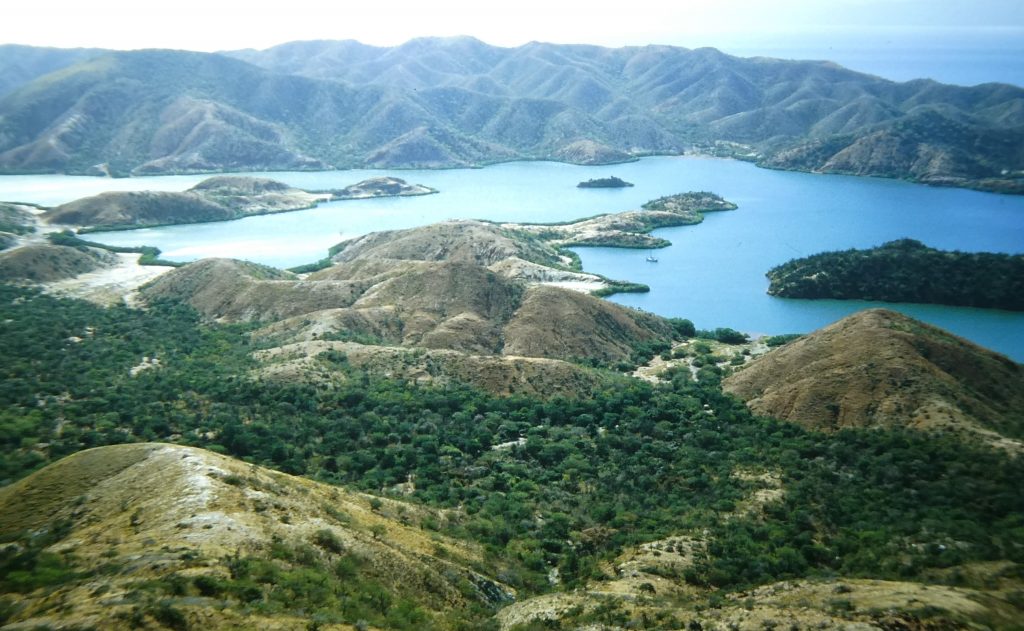 The wind died overnight and it was unusually calm as we pulled out and along to the next inlet, a large one, the Laguna Grande del Obispo (Bishop’s Lagoon).
The wind died overnight and it was unusually calm as we pulled out and along to the next inlet, a large one, the Laguna Grande del Obispo (Bishop’s Lagoon).
There were several coves to choose from, with no roads, no houses, just a few fishing camps. After gently pottering around for a while we chose to anchor between a small peninsula and a little island on the northern side of the lagoon.
 We were completely on our own in one of the most remote anchorages we had ever experienced. We thought the scenery was beautiful: dry red and highly impressive. There were a few small trees and shrubs along the shores, lots of spiny cactus and a few goats to be seen. Frigate birds were flying overhead, and pelicans and cormorants were mostly resting. There were a few vultures further inland.
We were completely on our own in one of the most remote anchorages we had ever experienced. We thought the scenery was beautiful: dry red and highly impressive. There were a few small trees and shrubs along the shores, lots of spiny cactus and a few goats to be seen. Frigate birds were flying overhead, and pelicans and cormorants were mostly resting. There were a few vultures further inland.
We already knew that many (most?) yachties avoided the Golfo de Cariaco and in particular inlets such as the Laguna Grande, regarding it as too lonely and spooky. There was also talk of drug smuggling that tended to scare people off. However, our experience in the Bahamas had been that drug-runners avoided yachts. We certainly never saw any such signs here, and we loved the isolation. We also loved the protected anchorage with flat water, as a rarity we had been missing in the Caribbean thus far – even if we did get the normal late afternoon wind.
We swam soon after arriving to wipe the boat’s bottom yet again; it was now needing more regular and vigorous attention.
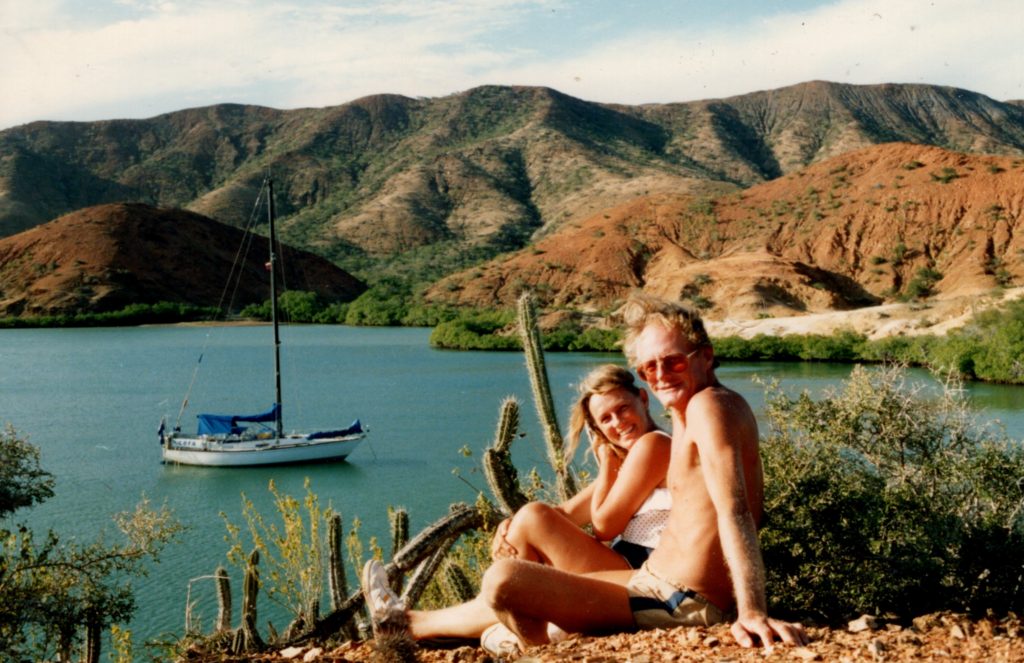 The next morning we took a tough walk ashore, climbing the steep and rock hills to the north of us. We went ashore at a mangrove beach at the outlet of a dry watercourse, walked up through trees – many flowering – and budding shrubs. It was the local spring, apparently. There were a few little birds, including a bright red bulbul.
The next morning we took a tough walk ashore, climbing the steep and rock hills to the north of us. We went ashore at a mangrove beach at the outlet of a dry watercourse, walked up through trees – many flowering – and budding shrubs. It was the local spring, apparently. There were a few little birds, including a bright red bulbul.
It was a difficult scramble up crumbly schist to the top, but we were rewarded by an outstanding view of the red/grey mainland and island scenery, with our beloved yacht Cera lying peacefully in blue water below.
In this wonderful isolation we got on with more maintenance, varnishing, baking, cleaning. We found some bugs in the dry stores, but after a big clean-up we only had to isolate two bags of brown flour.
In the end we were very reluctant to leave what the ship’s log records as “the most peaceful and quiet anchorage for several years!”
We sailed off the anchor and gently out west along the Cariaco gulf in a gentle easterly, passing Cumana on the south side of the entrance. In the afternoon we came to Puerto Mochima, with its narrow entrance hard to see. We sailed through and down this long gulf, extending south into the mainland for about four miles. There were lots of good-looking beaches each side along the way, with locals being ferried to and fro from the village of Mochima, deep in the southern end.
We anchored at the end of an inlet on the eastern side, Bahia Toporo, close to banks of mangroves. We were soon overboard again for a swim and clean. There were green hills around us, but they looked too prickly for easy walking. A few pelicans were crash-fishing, as we called their vertical dives into the water. After a gusty night we moved on down to anchor off Mochina village. This was essentially a row of one-storey concrete block houses, with lots of people visiting for the weekend and enjoying the bars and restaurants.
We took the dinghy ashore and watched the scores of motorboats ferrying people to the beaches we had seen on our way in. It was all very crowded, and we came to understand that this was carnival time, just before Lent. There were several signs that this could be a very noisy evening, and we returned to the Toporo inlet. It got overcast and showery, so we stayed there another day, while Norma did some successful washing.
 After leaving Mochina we rounded the top of the Manare peninsula and down the other side, passing south between the mainland and the bare little island of Venados. We worked into a very pretty and well-protected little bay on the other side of the peninsula from Mochina, Bahia Veradero Oueste.
After leaving Mochina we rounded the top of the Manare peninsula and down the other side, passing south between the mainland and the bare little island of Venados. We worked into a very pretty and well-protected little bay on the other side of the peninsula from Mochina, Bahia Veradero Oueste.
We took a short turn ashore to the beach, flanked by a tiny island and fringed by mangroves. The water was clear but cold and we enjoyed a swim and some snorkelling round the rocks. We saw a flower garden of brain coral, and pink and blue "Christmas tree worms". There were hawks and parrots among the many birds. There were no other boats or signs of humanity. Another lovely little anchorage.
There was some surge in from the north overnight, and despite gloomy skies we sailed out west along the capacious Ensenada Tigrillo, flanked to the south by some unusually green hills. We then cut down across a big open bay to the port city of Puerto La Cruz, a big commercial, industrial and shipping centre. Just down the coast from the port we went round a sandspit/breakwater and turned down a channel past a ferry port and into the big Marina Amerigo Vespucci. This had been recommended by our friends in Tilly Whim, who had left their boat there for a trip inland. We wanted to do the same.
 Being low in fuel, we went first to the fuel dock and filled up with diesel. When asked for the money, we simply did not believe it: 51 Bolivars for 145 litres! This was less than two US dollars total at the exchange rate of the time, evocative of the dire financial situation facing the country. We tied stern-to to one of the marina walls, next to a pleasant Swedish couple who came over for evening drinks. It was a fairly typical marina, surrounded by quite pleasant condo-style terraces in various pastel colours. There was a tiny shop for basic provisions. We had heard about some concerns on security, but were told of no problems recently.
Being low in fuel, we went first to the fuel dock and filled up with diesel. When asked for the money, we simply did not believe it: 51 Bolivars for 145 litres! This was less than two US dollars total at the exchange rate of the time, evocative of the dire financial situation facing the country. We tied stern-to to one of the marina walls, next to a pleasant Swedish couple who came over for evening drinks. It was a fairly typical marina, surrounded by quite pleasant condo-style terraces in various pastel colours. There was a tiny shop for basic provisions. We had heard about some concerns on security, but were told of no problems recently.
The next day, accompanied by our Swedish friends, we took a water taxi ride across the entrance canal and took the “por puesta” – a big taxi or minibus – into the city. It was a good-looking place, with some prosperous-looking shops and typically posh bank 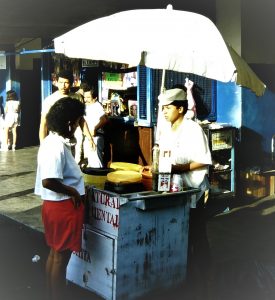 buildings. We walked down to the market, sampling a fried cheese tortilla as a snack on the way, and had a good (and very cheap) lunch at a pleasant terrace restaurant on the waterfront: baked goat with albondegas.
buildings. We walked down to the market, sampling a fried cheese tortilla as a snack on the way, and had a good (and very cheap) lunch at a pleasant terrace restaurant on the waterfront: baked goat with albondegas.
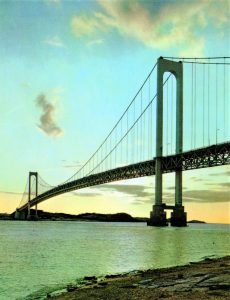 For our trip into the hinterland we had optimistically wondered whether we might get down to see the famous Angel Falls, but we soon established that they were far too far away and hard to get to anyway. So we decided to take the normal bus to Ciudad Bolivar, about 300 kilometres to the south on the River Orinoco and the capital of the region. We left the port early for the start of a two-day trip.
For our trip into the hinterland we had optimistically wondered whether we might get down to see the famous Angel Falls, but we soon established that they were far too far away and hard to get to anyway. So we decided to take the normal bus to Ciudad Bolivar, about 300 kilometres to the south on the River Orinoco and the capital of the region. We left the port early for the start of a two-day trip.
The bus was a bit old and dilapidated, but the driver was not bad. We started through green countryside through foothills, then through flat scrubby land along long straight roads. We passed through an oil town, and alongside the road ran big oil pipelines.
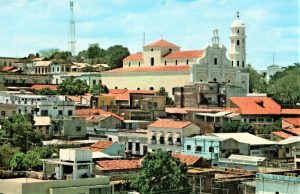
Our final approach to Bolivar was over a high and very impressive suspension bridge over the Orinoco River, rivalling the similar bridges in Lisbon or San Francisco, we thought. The river here narrows to a mile in width. The bridge is about 350 kilometres from the Orinoco Delta, and is the first bridge in from the sea. The city is thus a major river port for the inland regions of eastern Venezuela. The bus station was, as usual, a way out of town, so we took a local bus to the waterfront precinct into the centre.
We had lunch at the Gran Hotel de Bolivar and checked into a big, high-ceilinged room for the night. We walked the old town and visited the recently reconstructed cathedral which, like the adjacent buildings, was a pleasant place sitting in the Bolivar square. We ate in the hotel that evening, but the meal was awful. The ship’s log records: “didn’t complain. Should have”.
It rained overnight, and in the morning we took a bus east down the river to Ciudad Guayana and its port area, San Felix. The rain was bucketing down, and the bus was dilapidated and filthy. We passed over and through several puddles and deeper floods, and water started spurting up through the rusty cracks in the floor and collapsing seat mountings of the bus. Our unseaworthy vehicle was “sinking”, we joked. The driver was fast and aggressive, but we did make it to the San Felix bus terminal. We had brunch at the adjacent Hotel Intercontinental, a help-yourself buffet, and ate enough to keep us going for the day.
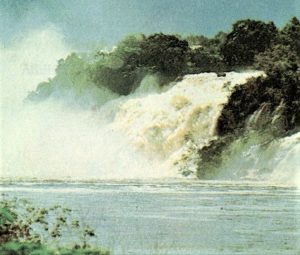
 We took a walkway up the Rio Caroni, a tributary of the Orinoco, to the Parque La Llovizna and its landscape of wooded islands linked by bridges and stepping stones. This took us to the dramatic Llovizna Falls. These are not high but very wide, with wide expanses of boiling white water. This was an impressive scene indeed, as it was nearing the end of the rainy season.
We took a walkway up the Rio Caroni, a tributary of the Orinoco, to the Parque La Llovizna and its landscape of wooded islands linked by bridges and stepping stones. This took us to the dramatic Llovizna Falls. These are not high but very wide, with wide expanses of boiling white water. This was an impressive scene indeed, as it was nearing the end of the rainy season.
We hitched a lift back to the San Felix terminal with a friendly black local, and immediately jumped on another bus to take us up through agricultural delta country north to the town of Maturin. We chose to keep going up to the coast, but had to wait for a por puesto to fill before leaving, as there was no bus. To get going at all we had to pay for a couple of additional empty seats – 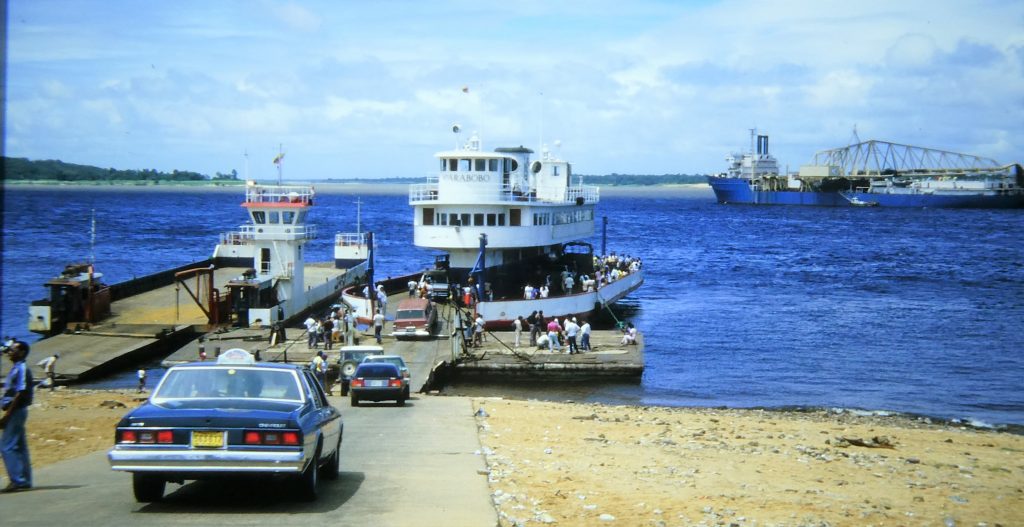 not a big deal, at local prices.
not a big deal, at local prices.
This was the best drive of the two days, starting by crossing the Orinoco by ferry and latterly through folds in the hills backed by mountains reminiscent of the volcanic peaks of the larger Caribbean islands. Through the delta country we crossed another river and passed through many little towns and villages, where some Carnival celebrations were still going. Simple processions were moving along, kids in costume, many of the adults with made-up faces, silver crosses and paper dolls. As the sun sank, we could see feasting and dancing in the open houses. Much of the activity was on the road, and the fast – but reasonably skilled – driver used his horn in a typically South American way.
As we approached the coast we enjoyed some lovely views down the valleys, but it was dark by the time we reached Cumana. We then took yet another por puesto, but couldn’t see much of what would have been a lovely run through a national park along the coast south of Mochina, with the bays and islands we had just explored by sea. It was a late taxi ride back to the boat, and we were straight to bed after a busy, active but enjoyable trip away.
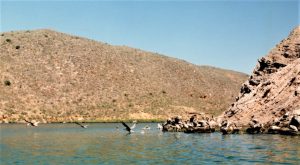 We motored out the next morning and moved up to anchor off the Puerto Cruz town beach. We went ashore for the market and bought plenty of provisions including booze, frantically using up local money! The anchorage was shallow and rough, so as soon as possible we motored to one of the nearby offshore islands, Chimana Grande. We anchored in the north-east corner of the Bahia Grande, a nice place, swarming with the pelicans that were nesting here, along with hawks and parakeets. We were in stark surroundings with a desert look, rimmed by mangroves at sea level, in complete silence - pelicans make no noise.
We motored out the next morning and moved up to anchor off the Puerto Cruz town beach. We went ashore for the market and bought plenty of provisions including booze, frantically using up local money! The anchorage was shallow and rough, so as soon as possible we motored to one of the nearby offshore islands, Chimana Grande. We anchored in the north-east corner of the Bahia Grande, a nice place, swarming with the pelicans that were nesting here, along with hawks and parakeets. We were in stark surroundings with a desert look, rimmed by mangroves at sea level, in complete silence - pelicans make no noise.
We rowed the dinghy through mangroves to an adjacent little bay, Bahia Mangle, to check it out, and then brought the yacht round for its excellent protection and lovely surroundings. There were no other boats of any kind to be seen.
We did a little beachcombing and maintenance while we were there, and were sorry to leave our pretty place of solitude for an overnight passage to the completely different surroundings to be found in the Archipielago de los Roques, some 150 nautical miles to the north-west.
We motor-sailed out to the west of Chimana Grande into a substantial swell and light winds, and a set coming down against us from the north. We passed close to Isla la Tortuga, where we had thought of stopping for the night, but it was getting too dark and so we pressed on. In this region, where winds were a constant feature of the weather, it was a bit frustrating not to have any now we were on passage! In the morning the easterly did come in, and we were able to set the spinnaker for some very nice sailing for the rest of the day.
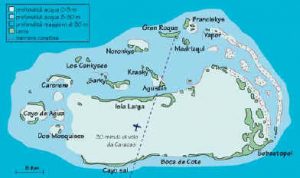 In the late afternoon we eye-balled through twisting coral passages and anchored in the lagoon off the coral cay of Francisqui, on the north-east side of the archipelago of Los Roques. The whole is effectively an immense coral atoll, an archipelago of about 20 by 10 nautical miles in size, almost completely enclosed by a ring of coral reefs and interlinked long islands. Some dozen or so yachts were there, some in an inner lagoon through an entrance that looked too shallow, and found a good place behind a corally shoal in the north-west part of the lagoon. The surroundings were pleasant, reminiscent of the Pacific, with the high island of El Grande Roque in the background. Ashore there was mangrove scrub, but “our” beach was strewn with litter. Early bed after a pretty sundown.
In the late afternoon we eye-balled through twisting coral passages and anchored in the lagoon off the coral cay of Francisqui, on the north-east side of the archipelago of Los Roques. The whole is effectively an immense coral atoll, an archipelago of about 20 by 10 nautical miles in size, almost completely enclosed by a ring of coral reefs and interlinked long islands. Some dozen or so yachts were there, some in an inner lagoon through an entrance that looked too shallow, and found a good place behind a corally shoal in the north-west part of the lagoon. The surroundings were pleasant, reminiscent of the Pacific, with the high island of El Grande Roque in the background. Ashore there was mangrove scrub, but “our” beach was strewn with litter. Early bed after a pretty sundown.
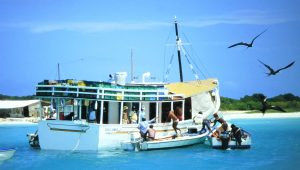 After a windy night we motored out and down past the island and settlement of El Grande Roque and then south across the northern half of the lagoon to a little un-named island just north of Lanqui. Near us was a fish-buying boat doing good business with the local fishermen off-loading their catches, mainly conch. In a pleasant afternoon we walked around the corally island beaches. There were big piles of conch shells among the mangroves, succulents and scrub. It all looked a bit Bahamian.
After a windy night we motored out and down past the island and settlement of El Grande Roque and then south across the northern half of the lagoon to a little un-named island just north of Lanqui. Near us was a fish-buying boat doing good business with the local fishermen off-loading their catches, mainly conch. In a pleasant afternoon we walked around the corally island beaches. There were big piles of conch shells among the mangroves, succulents and scrub. It all looked a bit Bahamian.
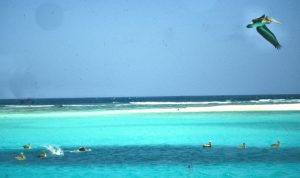 This was a good, calm anchorage for the night, and we had a pleasant sail the next morning to the west, eyeballing through the several shoals. We hooked a nice fish on the way. We came to anchor off the beach on the small island of Sarqui,
This was a good, calm anchorage for the night, and we had a pleasant sail the next morning to the west, eyeballing through the several shoals. We hooked a nice fish on the way. We came to anchor off the beach on the small island of Sarqui,  along with a single Dutch boat. Around us were masses of tiny fish in black shoals, looking like moving rocks. They were being tirelessly bombed by pelicans and an occasional booby, an amazing and amusing sight that continued all day. Norma also caught a couple of fish off the boat, so it was fish and fresh bread for dinner.
along with a single Dutch boat. Around us were masses of tiny fish in black shoals, looking like moving rocks. They were being tirelessly bombed by pelicans and an occasional booby, an amazing and amusing sight that continued all day. Norma also caught a couple of fish off the boat, so it was fish and fresh bread for dinner.
Then it was a short motor to Lanqui-Carenero and a good anchorage between two small islands. It was a pretty spot and justifiably popular, with our neighbours including several yachts, a Venezuelan game-fishing boat and another conch-buyer. Our spot was well protected from the constant wind, so we explored around in the dinghy and had a long swim.
We left in the morning through a pass out of the Roques archipelago and had a good sail downwind in the easterly trade to the next group of islets about 30 miles to the west. These are a pair of large atolls forming the Archipielago de las Aves – “of the birds”. The first one was Las Aves de Barlovento, where three little islets form part of the ring of coral that forms the atoll. Between two of these little islands there was a wonderful anchorage, which we shared when we arrived with three local fishing boats.
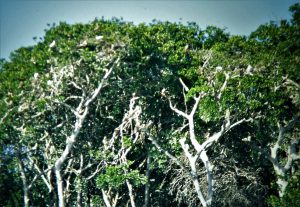
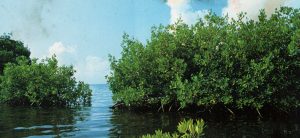 There was a string of high trees along the island, all amass with birds, mostly boobies. We rowed the dinghy in to an inner lagoon among the mangroves, alive with nesting boobies, looking inquisitively up to us from their nests and perches.
There was a string of high trees along the island, all amass with birds, mostly boobies. We rowed the dinghy in to an inner lagoon among the mangroves, alive with nesting boobies, looking inquisitively up to us from their nests and perches.
In the evening we watched clouds of birds returning from the west, circling before they joined the existing throngs. A few were being singled out for pursuit by frigate birds. Pelicans then joined the boobies high in the trees. It was all quite a sight.
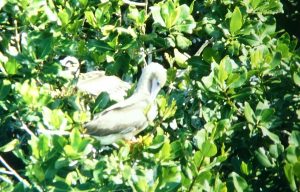
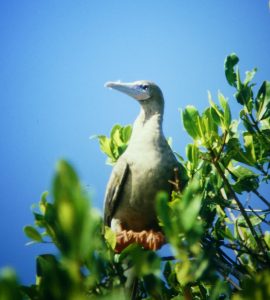
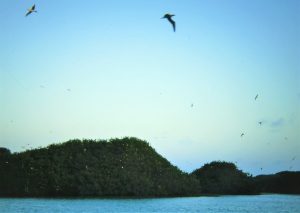
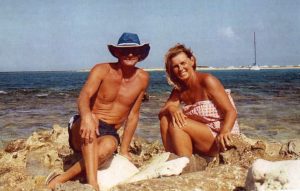
After the usual windy night we left for a two-hour sail to the other of the Aves, Las Aves de Sotavento. There was an astonishing blue glow in the water in the lagoon. We anchored among three islets half way up the western (lee) side of the atoll in a  very pretty spot off a fishing camp. The islets were rugged, bare, with just three palm trees to show. A local canoe came by, offering crayfish in return for cigarettes, not money. They were happy with batteries and rum in exchange for a three-pound cray. Norma baked bread while dealing with the cray, and it made for a superb dinner in this remote place.
very pretty spot off a fishing camp. The islets were rugged, bare, with just three palm trees to show. A local canoe came by, offering crayfish in return for cigarettes, not money. They were happy with batteries and rum in exchange for a three-pound cray. Norma baked bread while dealing with the cray, and it made for a superb dinner in this remote place.
Our short time in the Aves was wonderful, albeit challenging. The cruising guides warned of “dangerous coral banks” and “forlorn cays”, but by this time in our voyaging we were pretty comfortable with  navigation in such waters and conditions and relished the solitude they offered. But not so much the unrelenting Caribbean trade wind, especially at night!
navigation in such waters and conditions and relished the solitude they offered. But not so much the unrelenting Caribbean trade wind, especially at night!
We left Venezuelan waters on 23 February 1989. We had really enjoyed our month of cruising here, and could have spent much longer in many places if the seasonal timetable could be ignored. The people were great, the conditions often shambolic and required tolerance, but some of the anchorages were the best and most peaceful we had ever experienced. We were sad to have to move on, this time for the Dutch “ABC” islands of Aruba, Bonaire and Curacao.
The Dutch "ABC" islands
The Dutch "ABC" islands were originally settled by the Dutch in the 16th century. At the time, Spain and Portugal were briefly united, and cut off the supply of salt from Portugal to Holland. The Dutch set up and established salt pans in the three islands and a few other places in the Antilles to ensure supply of the salt that was essential for preserving fish. The Dutch West India Company was established to trade along the Spanish Main, pan salt and market slaves from Africa. In 1915 oil was discovered and became a mainstay of the islands' economy.
Aruba, Bonaire and Curacao are now components of the Netherlands Antilles, semi-independent and governed by Holland.
Bonaire, the easternmost of the ABC, is a day sail from the Aves. After a wind-in-the-rigging unsettled night we set off dead downwind for the start of a great sail, and rounded the southern tip of Bonaire by early afternoon. Along the shore we saw a  row of sad-looking dwellings that were once for slaves in the salt pans behind the huts. An obelisk, one of many, designated the location of such a pan. We sailed up the west side to the main town, Kralendijk, and tied up at the town dock by the Australian boat (Gunilla, with Ingmar and Pauline) we had met in Venice and Yugoslavia.
row of sad-looking dwellings that were once for slaves in the salt pans behind the huts. An obelisk, one of many, designated the location of such a pan. We sailed up the west side to the main town, Kralendijk, and tied up at the town dock by the Australian boat (Gunilla, with Ingmar and Pauline) we had met in Venice and Yugoslavia.
Two officials came down to clear us in, and we then went out to anchor off the town waterfront - quite close, because the island is the tip of an underwater mountain with steep sides. Gunilla joined us for drinks.
We just stayed the night and then had another good downwind sail to Curacao. There is a big and mostly commercial harbour in the main town of Willemstad, but like nearly all cruising yachts we made for a lagoon-like inlet, Spanish Water, about five nautical miles down the coast to the south-east.
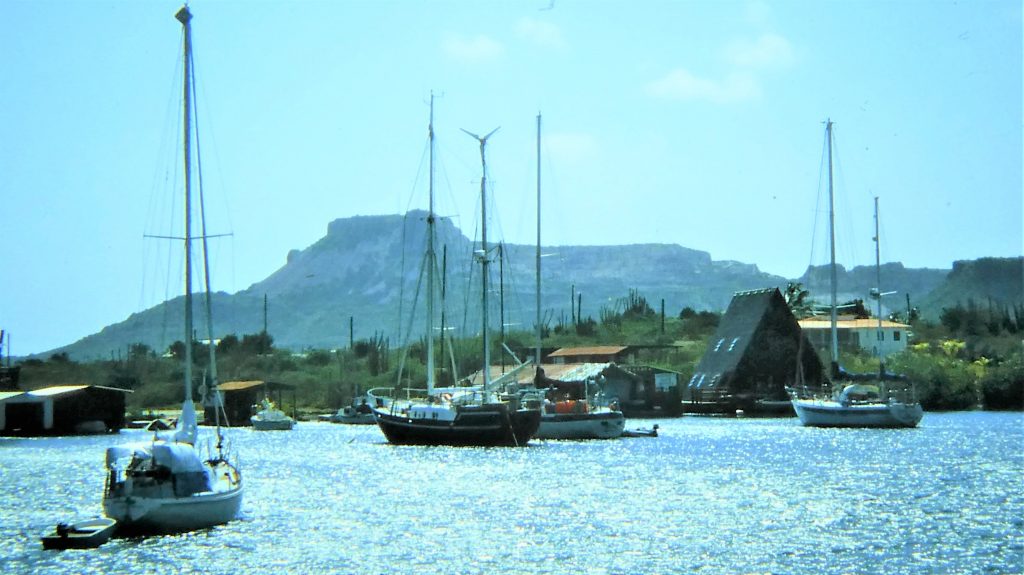 It's a narrow entrance and hard to see from the sea in poor light. We then motored up a narrow channel and as the inlet opened up we could the several little peninsulas and bays all around. We chose to join several other yachts in the biggest of the bays, up in the north-west corner, where we could see a popular yachty meeting place that we'd heard of, Sarifundy's Marine Services. This is a small and friendly operation, just a shed, café and a dinghy dock really, run by a very helpful Dutch couple, Jos and Hanny. We were quickly ashore for some good local advice.
It's a narrow entrance and hard to see from the sea in poor light. We then motored up a narrow channel and as the inlet opened up we could the several little peninsulas and bays all around. We chose to join several other yachts in the biggest of the bays, up in the north-west corner, where we could see a popular yachty meeting place that we'd heard of, Sarifundy's Marine Services. This is a small and friendly operation, just a shed, café and a dinghy dock really, run by a very helpful Dutch couple, Jos and Hanny. We were quickly ashore for some good local advice.
We caught up with some basic maintenance in the afternoon, and next morning took a bike ride into Willemstad. This was quite a hilly ride, but we only had to take the occasional walk. We cleared in with Immigration and were told we didn't need to report to Customs unless we were carrying guns. Unfortunately the bank, post office and Amex agent were all shut (Saturday), but we bought a few bags of provisions at the market.

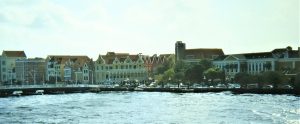 Willemstad harbour is huge, used by oil tankers and cruise ships among others. In the town there were several Dutch-style facades around the harbour front, where some cruise ships and tugs were tied up.
Willemstad harbour is huge, used by oil tankers and cruise ships among others. In the town there were several Dutch-style facades around the harbour front, where some cruise ships and tugs were tied up.
The ride back was tougher, being against the trade wind, and Norma's back was playing up. In the outskirts of the town the dwellings were basic and their inhabitants Caribbean black, but there were a lot of quite new and posh houses in the Spanish Water area. There were big hills to the east, being nibbled away by phosphate quarries.
Spanish Water became very busy over Sunday, a gloomy day weather-wise but with scores of little runabouts and jet skis rushing around, messing up the water for the dinghy races. A couple of days later a fatality was only just avoided when a jet ski hit the head of a Dutch sailor diving on his anchor, fortunately with little injury.
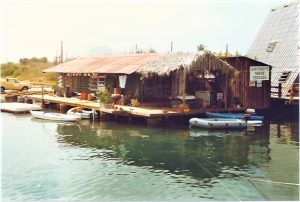 As on every Sunday evening, Sarifundy's laid on a barbeque for the visiting yachts; quite a feast, with several relays of meat and good salads. Inevitably, a most pleasant yachty get-together.
As on every Sunday evening, Sarifundy's laid on a barbeque for the visiting yachts; quite a feast, with several relays of meat and good salads. Inevitably, a most pleasant yachty get-together.
On Monday I cycled into town again to take advantage of its good facilities and easy communication, while Norma got stuck into a big clean-up operation on the boat. It was a fast ride in, pushed along by the trades. I picked up a huge pile of mail at the Amex rep and got some money out of the bank. A parcel had arrived, but at the post office I was told I must go to the head office up in the north of the town. On the way there I picked up some stuff at a supermarket and fixed a puncture on the bike. That made me miss the closing time for the parcel desk, so I sat around outside having lunch waiting for the afternoon opening. Then it was another hard ride back against the unrelenting trade wind.
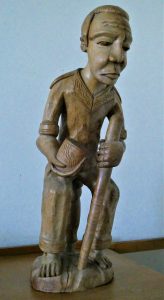 In the evening we were visited by an Australian who had seen the burgee for our sailing club, the Coastal Cruising Club of Australia, of which I had been Commodore. Amazingly our visitor - living on his 60ft yacht - had been one of the founder members of the club!
In the evening we were visited by an Australian who had seen the burgee for our sailing club, the Coastal Cruising Club of Australia, of which I had been Commodore. Amazingly our visitor - living on his 60ft yacht - had been one of the founder members of the club!
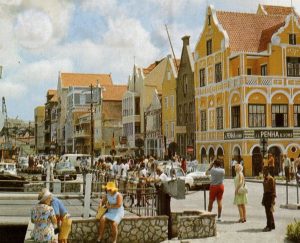 We then dived into heavy-duty letter-writing after which it was back into town for more shopping, business and copying borrowed charts. Curacao was likely to be the last time we could do much of this kind of thing before we reached Papeete, which would not be for quite a while. We also had to generate from various sources a pile of cash that we would need for a bond in French Polynesia.
We then dived into heavy-duty letter-writing after which it was back into town for more shopping, business and copying borrowed charts. Curacao was likely to be the last time we could do much of this kind of thing before we reached Papeete, which would not be for quite a while. We also had to generate from various sources a pile of cash that we would need for a bond in French Polynesia.
Then more socialising among the boats, and a couple of days later back again to Willemstad. This time we took a bus, with a cheerful driver bouncing along to reggae music. We cleared out with Immigration, bought some food and hardware - and a beautiful Haitian carving of an old man, one of many lovely carvings displayed on Haitian stalls in the market.
Over the next day or two in this superb anchorage we continued getting ready, and participated in several discussions on the best routes to Panama. We and others were regarding the six or seven hundred miles of sailing to Panama with some trepidation, as both the pilot charts and the experience of several before us gave rise to a pessimistic attitude regarding wind speed, sea height and adverse currents. The winter trades were said to really barrel round the curving coast of Colombia. Still, we thought, it can't be any worse than what we have experienced over the thousands of miles we had already sailed.
The socialising culminated in another Sunday barbeque at Sarifundy's, the day after which we departed for the San Blas islands of Panama.
Panama: the San Blas islands and the Canal again
We had a lovely start for the passage, in a steady trade under blue skies, but as soon as cleared the lee of Curacao the northerly swell came in again. We had a washing machine sea bringing uncomfortable conditions by evening. We passed to the south of Aruba, not worth a visit and clouded by smoke from oil refineries. The continuing strong but favourable wind was joined by a west-going current, and in the first 24 hours we made 158 nautical miles, good going.
About 50 miles due west of Aruba we rounded the prominent Peninsula de la Guajira, the northern-most point of Colombia and after which we would turn down to the south-west and Panama. We had decided to stay well off the peninsula, after talk of smugglers and lawlessness. We were still sailing very well, classic trade-wind conditions, with shoals of flying fish. Several landed aboard, as usual, but Norma had already tried cooking them and they aren't good eating. We made 164 miles the second 24 hours, fast for us.
The next night we had to change course to avoid a large vessel, probably a fishing boat. He most likely never saw us, because we were running without any navigation lights to avoid ourselves being seen.
As our course temporarily took us away from the coast of Colombia it became windier and rougher in this rightfully notorious bit of sea. Our last night at sea was foul, with high seas, heavy winds and rain squalls, all needing constant attention to steering as the self-steering vane came under stress. By the following mid-day Norma first caught sight of the Cayos Holandes, the first islands we would be visiting in the San Blas archipelago of Panama. On final approach the seas got even steeper and very rough, just as we had been warned. It's an intimidating approach because all the island are surrounded - and protected - by coral reefs, through which we would have to find the right pass.
Coming from the east, an American cruising association's journal recommended skirting the eastern end of the Hollandes group, going around to their south and immediately turning up through deep water into the lagoon off what was known as "Robinson's island". We took their advice.
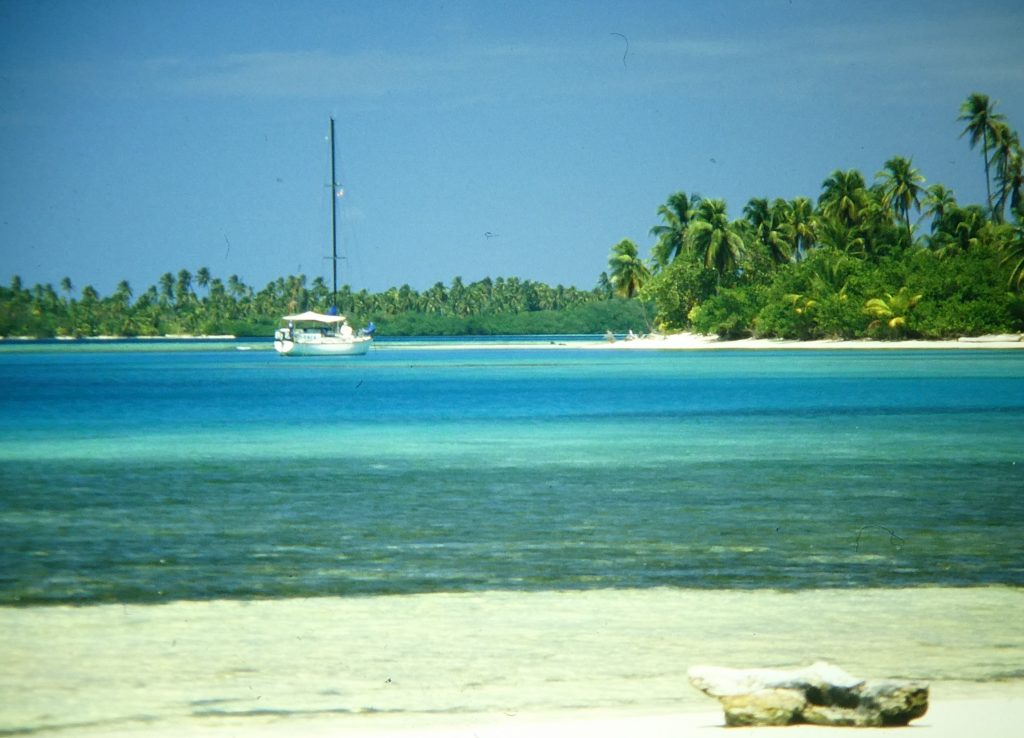
This was an absolutely gorgeous anchorage, justifying the over-used “idyllic” descriptor. Norma soon went for a short walk ashore and met some English-speaking locals. As so often among island people everywhere, their first words were "where're you going?" There was one other yacht in the bay, a big Australian ex-racing sloop being skippered by an Australian couple.
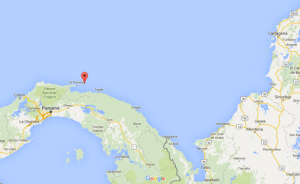 These islands, and the adjacent mainland, are the territory of the Kuna Indians, one of the only three remaining tribes of northern South America. The 365 or so islands, in groups of cays, range along the northern shores of the Darien Peninsula of Panama, and a 200 km strip of territory along the mainland remains Kuna land.
These islands, and the adjacent mainland, are the territory of the Kuna Indians, one of the only three remaining tribes of northern South America. The 365 or so islands, in groups of cays, range along the northern shores of the Darien Peninsula of Panama, and a 200 km strip of territory along the mainland remains Kuna land.
The Kuna have inhabited Panama since recorded history began there, have never been conquered and are unique in having maintained tribal customs by opposing the inroads of civilisation. They are thought to be the last of the full-blooded Carib people who inhabited the Caribbean before the Spanish conquest.
After a very heavy night's sleep, aided by a special treat – calm water and no wind! – we soon met Arnolfo Robinson, who came across in a heavy dugout canoe to introduce himself. He was on his way to an adjacent cay, where he had a farm. Norma then baked some bread. In the afternoon.
Arnolfo's daughter, plus another Kuna lady 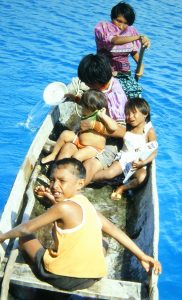 and three kids came over, bringing some simple fruit and veg - and a bag of molas. These are the reverse appliqué embroidered panels that are used to decorate the national costume they wear all the time. We invited them aboard and duly bought a few. The two ladies were in full local dress, with mola blouses, bright bracelets, golden nosepieces. The purchase of molas is what Norma came to call the anchoring fee for the San Blas. The Kuna women were friendly but tended to be uncommunicative, with an air of studied indifference. This is because their nature is naturally impassive.
and three kids came over, bringing some simple fruit and veg - and a bag of molas. These are the reverse appliqué embroidered panels that are used to decorate the national costume they wear all the time. We invited them aboard and duly bought a few. The two ladies were in full local dress, with mola blouses, bright bracelets, golden nosepieces. The purchase of molas is what Norma came to call the anchoring fee for the San Blas. The Kuna women were friendly but tended to be uncommunicative, with an air of studied indifference. This is because their nature is naturally impassive.
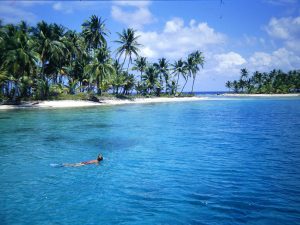 We went ashore to make further contact with Mr Robinson. His name was through his father, who was taken as a boy to New York by the captain of a trading schooner, the Sam Robinson. He gave us some good background information on the islands and a sheet of instructions on entry procedures at the bigger settlements. It did seem that the formalities were not of much importance as long as you brought money and purchased molas!
We went ashore to make further contact with Mr Robinson. His name was through his father, who was taken as a boy to New York by the captain of a trading schooner, the Sam Robinson. He gave us some good background information on the islands and a sheet of instructions on entry procedures at the bigger settlements. It did seem that the formalities were not of much importance as long as you brought money and purchased molas!
We walked around the island and caught a small stingray that made a good evening meal, along with very fresh bread. We continued to enjoy this lovely place, doing some maintenance, swimming and snorkelling, and taking gentle walks. The surf on the ocean side of the islands was something to see.
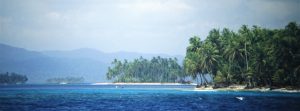
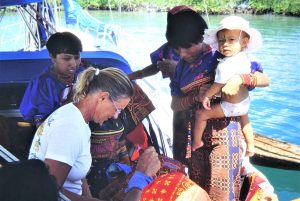 After three nights we headed south-west towards the mainland, anchoring south of a chain of cays called the Brisas. It was again very pretty here, and the only other vessel was a dugout, fishing. We could see mountains along the mainland to the south, and the village of Ciedras was just visible. We attracted more visitors in dugouts; we did buy some simple molas, but the really good ones were very expensive. We gave a kid a dollar for a fish, which was excellent for the evening.
After three nights we headed south-west towards the mainland, anchoring south of a chain of cays called the Brisas. It was again very pretty here, and the only other vessel was a dugout, fishing. We could see mountains along the mainland to the south, and the village of Ciedras was just visible. We attracted more visitors in dugouts; we did buy some simple molas, but the really good ones were very expensive. We gave a kid a dollar for a fish, which was excellent for the evening.
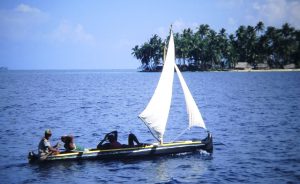 The nights continued calm, and we continued south-west towards the entrance to the Rio Ciedra and the village there. There were dozens of dugouts out sailing, white sails, the main with a sprit and a small headsail. They were moving surprisingly fast, sometimes with the assistance of paddlers.
The nights continued calm, and we continued south-west towards the entrance to the Rio Ciedra and the village there. There were dozens of dugouts out sailing, white sails, the main with a sprit and a small headsail. They were moving surprisingly fast, sometimes with the assistance of paddlers.
 The village as seen from the boat was on two adjacent islands, with jampacked bamboo and palm-leaf dwellings, with one or two more substantial. We saw a possible anchorage just to the west of the bigger island, but we thought it was too close to the village. We continued round a headland and found an excellent anchorage among the mangroves, well protected.
The village as seen from the boat was on two adjacent islands, with jampacked bamboo and palm-leaf dwellings, with one or two more substantial. We saw a possible anchorage just to the west of the bigger island, but we thought it was too close to the village. We continued round a headland and found an excellent anchorage among the mangroves, well protected.
The first canoes beat us to it! The islanders were clambering aboard with molas before we got the anchor set, laying them out all over the cockpit and deck. All this, and the brightly-dressed women, made a very colourful sight indeed. They were mostly women, many with children, and just a few men. The total aboard came to 40-50 visitors at its peak. But everyone was polite and well-mannered, even the kids. Even though we only bought three molas, no-one was upset about it.
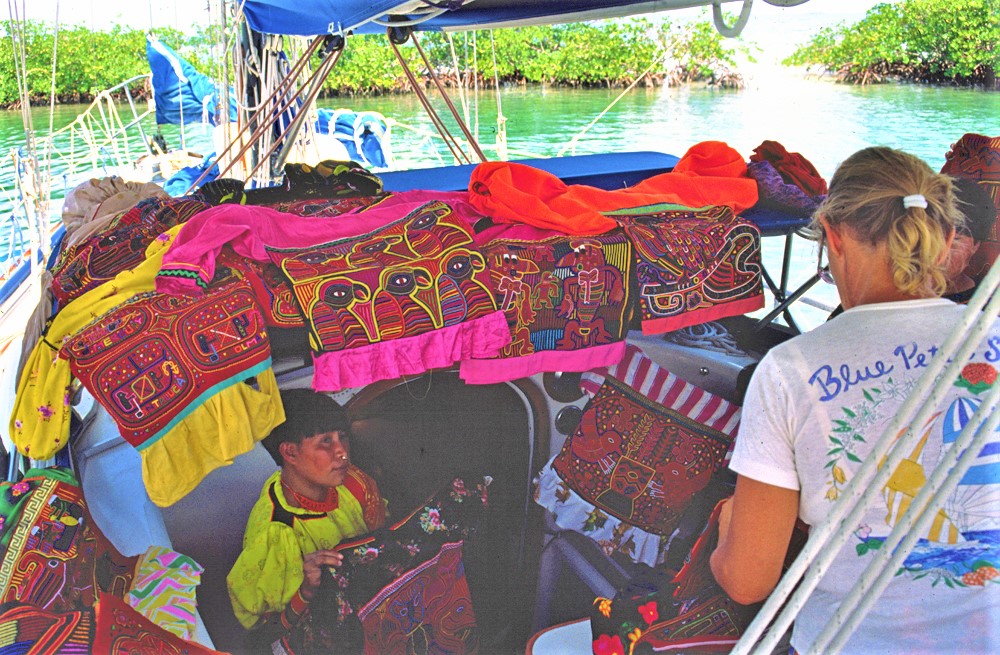
They all seemed happy just to sit around or potter over the deck. One of the men was a missionary, speaking a little English. He explained that few yachts visited the mainland, and the villagers just wanted to visit the boat, look over us, and touch things. He assured us that we did not have to buy molas, and no offence would be taken. We did note that some of the poorer women did look a bit sad. He warned us that this would be only a preliminary invasion, so we made our excuses and started the engine – which was quite enough to scare them all off, quite scared!

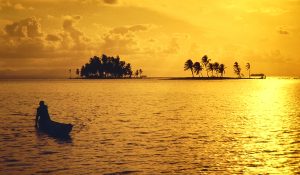 Looking for somewhere quieter, we moved up the Cayos Limon. We crossed a shoal between two islands and were briefly aground – which wiped a few barnacles off the keel! So we did some more cleaning up, including tar on the topsides left by the dugouts. We had a couple of visits, offering more molas. Enough, already! We gave one of them some matches, and he promptly lit a fire directly upwind of us.
Looking for somewhere quieter, we moved up the Cayos Limon. We crossed a shoal between two islands and were briefly aground – which wiped a few barnacles off the keel! So we did some more cleaning up, including tar on the topsides left by the dugouts. We had a couple of visits, offering more molas. Enough, already! We gave one of them some matches, and he promptly lit a fire directly upwind of us.
We moved out of the Golfo San Blas the next morning and rounded the Isla Porvenir then the Punta San Blas. On the way we noted several small cays (Islas Robeson) deep in the western reaches of the gulf with very Anglo name: Islas Gertie, Elsie, George and Nellie. We also noted on the chart Bajos Alden and Selfridge, and the Canal Porter. Why all this? Settlers? Pirates? We never did find out.
The town of Porvenir is a port of entry, and there was a Princess Line cruise ship there, having pulled in last night. We saw another Greek ship nearby.
It was overcast and showery, and the wind was against us, so we motor-sailed west along the Panama coast, passing inside some dangerous charted but unmarked shoals, prominently breaking. We took the channel between the coast and the Isla Grande, sailing in a gentle wind under now sunny skies. The shores each side were thick with palms and scattered bunches of Carib-style bushes backed by lush hillsides.
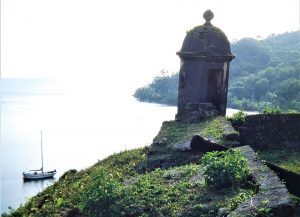
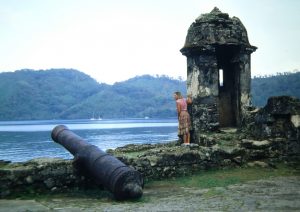 This had taken us round the Punta Grande and we were now sailing south. We rounded a headland inside a little island, Isla Drake, at the northern entrance to the big harbour bay of Portobelo, or Porto Bello.
This had taken us round the Punta Grande and we were now sailing south. We rounded a headland inside a little island, Isla Drake, at the northern entrance to the big harbour bay of Portobelo, or Porto Bello.
It was a beautiful approach to the anchorage near the ruins of Fort Fernando, with hills on all sides covered by jungle growth. On the south side of the bay we could see a simple village with a prominent white church and more ruins. There were Brahmin cattle on a small beach. It all seemed redolent of galleons, treasures and pirates.
The port indeed has an interesting history. It was once the western headquarters of the Spanish Plate Fleet, where they picked up gold and other treasures plundered from South America and then set sail back to Spain. The pirate Henry Morgan sacked the supposedly impregnable port in 1668, and in 1741 it was stormed and taken by Admiral Vernon.

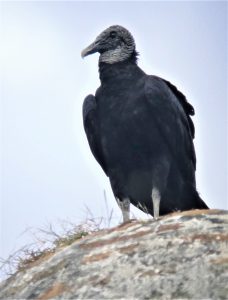 Before the light disappeared we walked up through the fort. The ruins were well maintained, cannon barrels apparent in many apertures, pepper-pot enclosures at the fort corners. Hundreds of birds were twittering and swooping around. As the sun set the insects came out and we retreated to the boat.
Before the light disappeared we walked up through the fort. The ruins were well maintained, cannon barrels apparent in many apertures, pepper-pot enclosures at the fort corners. Hundreds of birds were twittering and swooping around. As the sun set the insects came out and we retreated to the boat.
The harbour has the distinction of having the heaviest annual rainfall in the North American continent, and it was showery overnight. In the morning in clearing weather we dinghied ashore to explore Portobelo village. It was a sleepy and poor place, mainly just shanties, but overwhelmed by several collections of impressive ruins. Forts were ranging up the hillsides, there was an attractive church, and a Customs house between a range of guns fronting the fort and the village. This was used to store the treasures of the Spanish Main. There were vultures everywhere, moving slowly when approaching us, then lifting into the air in light winds, circling and soaring in thermals as the land heated up.
A return trip through the Panama Canal
We had a beautiful sail the 20 nautical miles or so down from Portobelo to the enormous breakwater that protects Christobal Colon and the Atlantic end of the great Panama Canal. We drifted through the multitude of anchored ships and turned into the Panama Canal Yacht Club. We tied stern-to in the new visitors' wharf. We dined that night with the pleasant American couple in the berth next to us, Robert and Anne in their 46ft aluminium sloop Annika, enjoying good steak and chips.
When we entered Cristobal Harbour at the Atlantic end of the Panama Canal, we had completed an almost exactly five-year circumnavigation of the north Atlantic, including the Mediterranean in both directions. This was, I might say, a cause for some celebration.
We called the authorities to find out what the current formalities were. Once upon a time, it was compulsory to go to the wide-open yacht anchorage in “the flats” and wait for the boarding officer. We were pleased to learn that we could now clear out from the Panama Canal Yacht Club. The club has a marina which is usually full of local yachts, and a stern-to wharf for visitors, costing us about $9 a day. Anchoring out was free, but we knew from experience that setting up the transit and doing all the other things we needed to do in Colon – we didn’t want to stop at the other end – would entail a lot of toing and froing, and it’s a fair dinghy ride from the flats in the trade-wind chop. Furthermore, the club is a friendly and helpful place, unlike its counterpart in Balboa, which had recently been voted one of the worst yacht clubs in the world.

 The next day was busy and at times frustrating, typical of Panama. We waited for Immigration to come to us, but they didn't, so we walked into Colon and to the bank and took out $500.
The next day was busy and at times frustrating, typical of Panama. We waited for Immigration to come to us, but they didn't, so we walked into Colon and to the bank and took out $500.
For safety, we took the taxi back, because it was said that bad guys would see you come out of the bank and be a possible mugging target. For the same reason, all photos of Colon in this account are from local literature, because it was said to be a bad idea to carry a camera.
This time we did check in with Immigration, and went on to the Consulare Navire for a cruising permit. It turned out that we should have gone to the Port Authority first. We finally got that sorted out, went then to the Canal Port Captain, filled in yet more forms (pretty much identical to the others), and were booked in for transit three days later. By this time the Panamanian authorities were step by step taking over the running of the Canal from the Americans, but we didn't notice much difference from five years before, transiting the other way, filling forms after forms after forms.
Politically and economically, the Panamanians were now in very troubled times. The locals we talked to – taxi drivers and the like – seemed universally to hate the de facto ruler Noriega and his cronies, but were resigned to his staying in power whatever happened in the election (then soon to some). They seemed surprisingly unwilling to blame the Americans for the dollar shut-off, which only made things a lot worse for the poor people and didn’t budge Noriega an inch.
One important change for us was that the yachts were now not being taken through while sharing locks with ships, but allocated to yacht-only days, twice a week. The transit fee was $55, and they still had in their computer the details of Cera and her Canal measurements from the last time. To complete a wearying day we filled up with fuel by carrying jerry cans from the yacht club's fuel dock. The log records, "Exhausted to bed, as usual in Panama Canal Zone".
Some rain overnight, and we then went off for the well-remembered open market. It had been replaced by a supermarket, which was adequate, so we did a substantial stock-up. It was likely to be some time before we could do another.

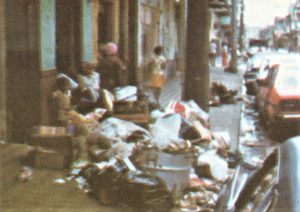 Colon itself was a sad sight. Five years before, when going the other way, and despite a fearsome reputation for muggings, we had found it a clean and pleasant place, with lovely old French-style colonial buildings, a legacy of the French attempt to build a canal before the Americans took over. It had since fallen into dreadful decay, with appalling poverty and unemployment contributing to its present lawlessness.
Colon itself was a sad sight. Five years before, when going the other way, and despite a fearsome reputation for muggings, we had found it a clean and pleasant place, with lovely old French-style colonial buildings, a legacy of the French attempt to build a canal before the Americans took over. It had since fallen into dreadful decay, with appalling poverty and unemployment contributing to its present lawlessness.
Those who were not crooks or thugs were still the sort of charming people who make Panama a most pleasant Latin-American country, and all the nice guys expressed great concern at our limited forays by foot into the town. But the decrepit taxis were 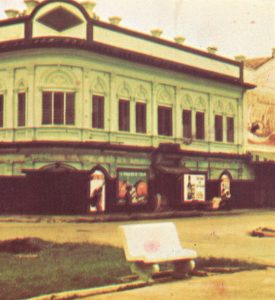 cheap, and we made use of them. Many people were simply lounging around, presumably unemployed. New tenement blocks had no windows, just gaps between the breeze blocks. Most small shops were boarded over.
cheap, and we made use of them. Many people were simply lounging around, presumably unemployed. New tenement blocks had no windows, just gaps between the breeze blocks. Most small shops were boarded over.
It was a weekend, and we spent Sunday clearing away the boat and sorting out our long lines. On Monday we confirmed transit for Tuesday and cleared out with the port authorities.
As mentioned above, transiting the other way five years ago we had used the locks individually, sharing them with the ships. Now, the yachts were being grouped into a pair of two-day transits each week and do not go through with a ship. This is much safer and easier, with far less turbulence and a lot more space in the locks, but there are fewer spare yachties left over to help with line-handling on each others’ boats. This has made an opening for the locals, but they were charging $50 each. We were lucky, meeting a charming American lady living on a boat in the marina. This was Nancy Bollinger and her sons Bob and John, joined by Chick, a Canadian on whose boat they were staying. All were looking for a ride through the Canal. They were experienced enough to make good crew and great company.
At 9:30 on Tuesday 21 March 1989 we had to wait while the other boats in our convoy waited for their crews to turn up. At 11:00 a bunch of advisers at last appeared, but not one for us! I dashed down to the Canal office, where I was told the forms we'd filled in had disappeared and there were no other advisers available. Apparently, the man filling in our form had left the office in order to attend to some personal business, and never filled in the box saying when we were to go through. However, a man from the office was willing to come with us, although he was not an official "adviser". By that time all the other boats had left, but after more drama clearing a fouled anchor we motored out as fast as we could and just in time joined a group of yachts jilling about outside the Gatun Lock gates.
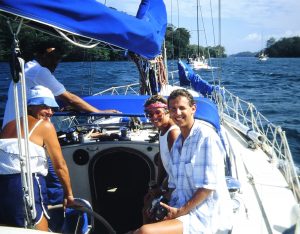 We rafted up with Robert and Anne in Annika, and worked out the details of how we were going to tie together. It was a bit awkward in a strong northerly wind. We entered the lock, and after several throws of the threatening monkey fists finally got the lines up and secured. There was another raft ahead of us, and two more behind, in groups of three.
We rafted up with Robert and Anne in Annika, and worked out the details of how we were going to tie together. It was a bit awkward in a strong northerly wind. We entered the lock, and after several throws of the threatening monkey fists finally got the lines up and secured. There was another raft ahead of us, and two more behind, in groups of three.
We were walked through the next two up-going Gatun locks, getting used to line-handling and boat-handling in some turbulence as the locks filled. We then had about 21 miles of motoring through the lovely piece of water that is the manmade Gatun Lake, formed when the Chagres river was dammed in the early part of the century. Since the whole system was started up in 1914, enough rain has fallen to  keep the lake full and supply all the water needed to operate the locks. The lake is scattered with pretty little islands, and we were able to take a few scenic short cuts off the main shipping channel with a headsail set to help us along. Our "adviser" was not sure of the way, so we simply followed a pair of French boats through the well-buoyed Banana Cut and splendid jungle scenery.
keep the lake full and supply all the water needed to operate the locks. The lake is scattered with pretty little islands, and we were able to take a few scenic short cuts off the main shipping channel with a headsail set to help us along. Our "adviser" was not sure of the way, so we simply followed a pair of French boats through the well-buoyed Banana Cut and splendid jungle scenery.
This was to be a two-day passage, as opposed to the one-day trip five years previously. We came to an anchorage opposite the settlement of Gamboa, just over half way, at 6:00pm. It was a pretty place to stay. Our adviser left us for the night, in our case with our profound gratitude for helping us out of a situation which was not our fault.
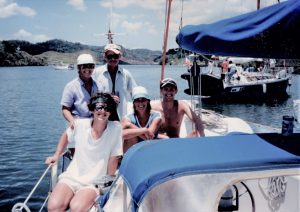 The lake is, of course, fresh water, and we all went in for a very welcome swim, because it was hot. As the sun went down we had a few rums, and later Norma made us all an excellent dinner, with our three crew as splendid company. We don’t really have room to sleep three guests (we had never done so before), but the boys decided to sleep in the cockpit, under the awning. Ships slipped by in the night like ghosts, leaving surprisingly little wake at their moderate speed.
The lake is, of course, fresh water, and we all went in for a very welcome swim, because it was hot. As the sun went down we had a few rums, and later Norma made us all an excellent dinner, with our three crew as splendid company. We don’t really have room to sleep three guests (we had never done so before), but the boys decided to sleep in the cockpit, under the awning. Ships slipped by in the night like ghosts, leaving surprisingly little wake at their moderate speed.
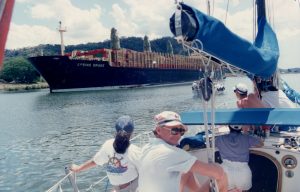 The next morning was again fine, hot and steamy, and once again we had the wait for our advisers. This time, I was resolved to press on with the group regardless, if nobody turned up
The next morning was again fine, hot and steamy, and once again we had the wait for our advisers. This time, I was resolved to press on with the group regardless, if nobody turned up  for us! But we got our adviser all right, an absolutely charming lady of Chinese descent (like many in Panama, which is a real melting-pot of the races). Sharp as a tack, Libia was a graduate of the Marine Academy in New York, currently a senior mate on the Canal tugs, and studying for her Master’s ticket. She was even kind enough to come on board bearing a great bag of ice!
for us! But we got our adviser all right, an absolutely charming lady of Chinese descent (like many in Panama, which is a real melting-pot of the races). Sharp as a tack, Libia was a graduate of the Marine Academy in New York, currently a senior mate on the Canal tugs, and studying for her Master’s ticket. She was even kind enough to come on board bearing a great bag of ice!
Libia said that in her opinion rafting groups of yachts was easier and safer than the old way we had gone before, in the docks along with the big ships, and we agreed.
And so, off again, immediately into the Gaillard Cut, the narrowest part of the canal, where the original construction called for the carving of a great slice through the hills of the divide. This is where most of the some 20,000 deaths occurred during the Canal’s building, from injury, yellow fever, and malaria.
At the end of the cut we came to the first of 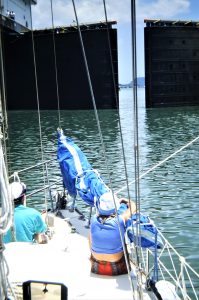 the down locks, Pedro Miguel, where we had to wait
the down locks, Pedro Miguel, where we had to wait 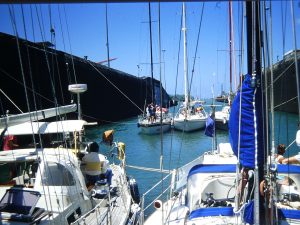 for some ships to come the other way before our bunch of yachts got in. After this lock, we motored in our rafts across another small lake to the last pair of locks, Miraflores, where there was a little turbulence as the salt water of the Pacific rushes in and mixes with the fresh water that had brought us down.
for some ships to come the other way before our bunch of yachts got in. After this lock, we motored in our rafts across another small lake to the last pair of locks, Miraflores, where there was a little turbulence as the salt water of the Pacific rushes in and mixes with the fresh water that had brought us down.
We peeked through the gap as soon as the Miraflores dock gates began to open, and through it we could see the Pacific Ocean! This made us very happy, and the ship's company gave three cheers.
All we had to do then was to motor a few miles to the Balboa Yacht Club to let off our adviser and three crew, who were unmatchable company and had become good friends. We didn’t stop at the club, instead following Annika to an anchorage at the small island about seven miles away, Taboga, for the night. We had stayed at this anchorage for a night before going to Balboa to organise our transit the other way, all those years ago. A familiar boat there this time was the steel Australian yacht Gunilla, which we had been coming across in odd places ever since the first time in Venice.
The Pearl Islands of Panama
It was a pleasant morning after a rather disturbed night, rolling in the swell and chop. There was also a lot of carbon black fallout from the nearby burning of forests and cane plantations, which was making our nice clean topsides filthy again. So off we went, aiming for the Pearl Islands in the Gulf of Panama.
It is said that when Balboa first visited this group, he noted the inhabitant’s use of pearls and mother-of-pearl for necklaces and for decorating implements such as canoe paddles. This was his inspiration for naming the group the Pearl Islands.
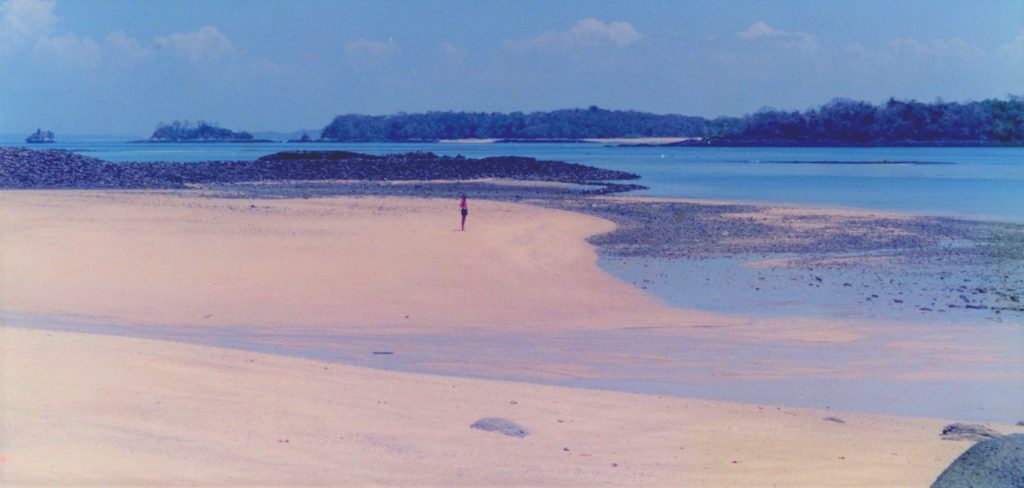 We had visited this lovely little archipelago previously, of course, in 1984 en route for the Canal. We therefore had some knowledge of the place and this time planned to careen our vessel and antifoul her bottom. The tidal range along the Pacific coast of Central America is up to four metres, which is what we had also made use of when careening in Costa Rica five years before.
We had visited this lovely little archipelago previously, of course, in 1984 en route for the Canal. We therefore had some knowledge of the place and this time planned to careen our vessel and antifoul her bottom. The tidal range along the Pacific coast of Central America is up to four metres, which is what we had also made use of when careening in Costa Rica five years before.
We had a gentle sail down from Taboga and into the islands, passing by the Contadora resort (where we had thought of doing some shopping) because the anchorage that we had used before looked too exposed. We came to anchor off a beach on Chapera Island. We then found that the recent hot weather had done no favours for our stored eggs and turned the bread mouldy.
We spent the night there and motored on down through the narrow channel between the islands of Mina and Viveros to a well-remembered beautiful anchorage between Bayoneta and Vivienda islands. Ashore, we were surrounded by 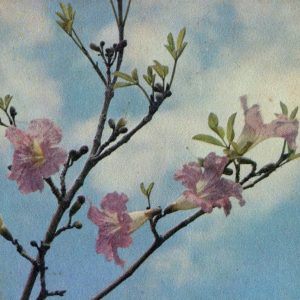 bright green, bushy trees, big boulders and fields of rocks. Many of the deciduous trees were now bare, with many displaying pink flowers, a pretty contrast. The
bright green, bushy trees, big boulders and fields of rocks. Many of the deciduous trees were now bare, with many displaying pink flowers, a pretty contrast. The  Bayoneta beach was a mass of shells, and Norma found some lovely murex.
Bayoneta beach was a mass of shells, and Norma found some lovely murex.
However, we had work to do. On the way down we had become conscious of the smell of diesel fuel, which got worse as we wove our way through the islands. I had a quick look on the way, and sure enough, saw fuel spurting from somewhere near the injector pump. The engine was running roughly. Once at anchor I found that one of the pipes between the injector pump and injector was fractured under the nipple at the pump end. I tried a few bodge-up fixes, but none worked. It was clear that we would have to return to Panama City for help.
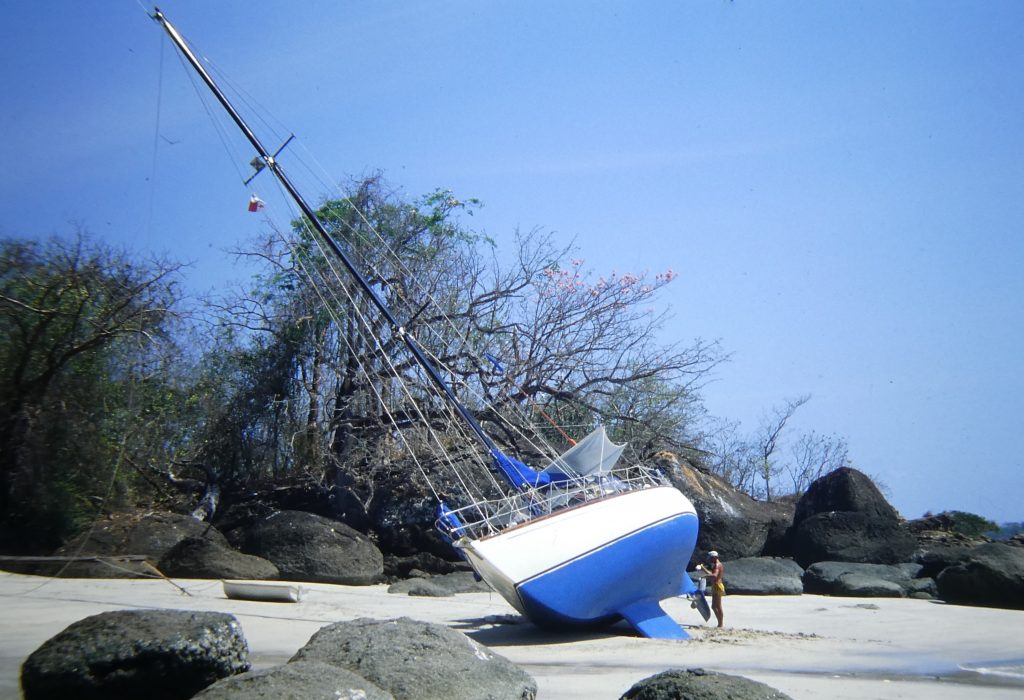
We decided to get the careening over first, and after some reconnoitring in the dinghy chose the closest, a sand beach on Vivienda. We moved there the next morning, took a line from the masthead to a tree ashore and another line astern to an anchor to align us properly. After the water had receded we cleaned off the bottom (which was not too dirty because of the work we had regularly done by 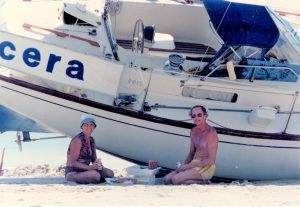 diving) and applied a coat of Venezuelan antifouling. We finished the upper side by lunchtime, and then sat out in the shade while waiting for the water to return. As ever, it’s a worry to watch the water rising, hoping – as it has always done before – that the boat will in fact rise up before the water rushes over the gunwales and into the vessel! We returned to “our” anchorage for the night, and in the morning did the other side with no problems.
diving) and applied a coat of Venezuelan antifouling. We finished the upper side by lunchtime, and then sat out in the shade while waiting for the water to return. As ever, it’s a worry to watch the water rising, hoping – as it has always done before – that the boat will in fact rise up before the water rushes over the gunwales and into the vessel! We returned to “our” anchorage for the night, and in the morning did the other side with no problems.
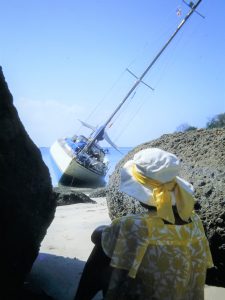 With that all done we had quite a pleasant beat back up to Taboga, arriving under a smoky haze. The water was a bit choppy overnight, and we then did some simple shopping in the village before taking the very basic little ferry into the dock at Balboa.
With that all done we had quite a pleasant beat back up to Taboga, arriving under a smoky haze. The water was a bit choppy overnight, and we then did some simple shopping in the village before taking the very basic little ferry into the dock at Balboa.
Carrying the fractured injector pipe we took a taxi into Panama City, with an exceptionally helpful English-speaking driver. There was supposed to be a Perkins agent near the centre of the city, but we failed to find it. We went through crossroads near the Presidential palace, glared at by steely-eyed armed guards. We drove out to another diesel engine shop in the suburbs, but no go.
Our driver then asked - having to that point politely followed our instructions without question - just what it was we were looking for. I showed him my cracked pipe, and he responded immediately by saying he knew a workshop that made and tested fuel injection equipment! He took us out to an industrial suburb, and the workers confirmed that they could make us a new one within an hour or two. We thanked the driver and suggested he go back to the city, but he said he was reluctant to leave us here alone. We assured him we’d be OK.
We had a good lunch of fried chicken across the road, and then picked up our brand new injection pipe plus a spare length of piping in case we had another failure. Another helpful taxi driver then took us back to Panama City centre.
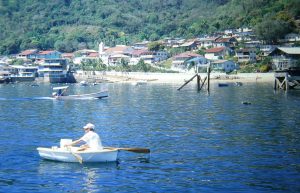 We did some substantial shopping at the big El Rey supermarket, good by Central America standards, and took another taxi back to the wharf. All the drivers discussed the forthcoming elections with us, none of them having anything good to say about the current administration or General Noriega and his cohorts.
We did some substantial shopping at the big El Rey supermarket, good by Central America standards, and took another taxi back to the wharf. All the drivers discussed the forthcoming elections with us, none of them having anything good to say about the current administration or General Noriega and his cohorts.
Then it was the ferry back to Taboga and the boat, where more carbon fallout was making things dirty again. After a disturbed night in a heavy swell, I fitted the new injection pipe and bucketed by dinghy several litres of water. Norma did some washing. I checked the mast and all the rigging, and after a busy few days and a better night we finally set sail for the Galapagos islands.
Passage from Panama to the Galapagos
We left Taboga for the wide Pacific on Friday 31 March 1989. We were very pleased to be in the Pacific again, and immediately felt that the motion of the sea was more regular and settled than in the turbulent Atlantic.
The passage started quite well, with some trepidation regarding the engine, but it started and ran perfectly well to our great relief. The wind was very light, declining to nothing by the evening. The sun set bright red, behind a massive haze of smoke from sugar-cane burning. As dark fell a good northerly wind came in and held through the night and next day. We had the close company of some moderate-sized whales, entertaining and worrying at the same time!
Over the next few days the wind periodically came and went but remained good for sailing and we had little work to do. As the first week out came to an end, however, the variation in wind was between very light and none. The log recorded: “Still no fish. No moon. No nothing!” But in the dark of the night we were trailing a beautiful stream of phosphorescence behind us. Our pace 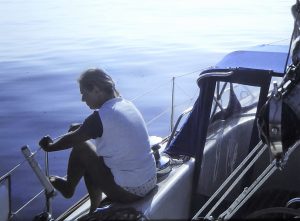 was down to under 50 nautical miles a day, very unusual and hard to get used to. By this time, of course, we were approaching the equator and well out of the trades and into the notorious doldrums.
was down to under 50 nautical miles a day, very unusual and hard to get used to. By this time, of course, we were approaching the equator and well out of the trades and into the notorious doldrums.
Nine days out we got some sailing wind, but it was dead on the nose! And, of great significance, we crossed the equator and returned to the southern hemisphere for the first time in six years. We celebrated accordingly.
By this time, the wind being the direction it was, we had decided to make our Galapagos destination Academy Bay, on the island of Santa Cruz, one of the only two ports of entry. We were being set every which-way by strong currents during our final approach, but were entertained by sealions popping their heads up around us, rolling over and waving their flippers in the air.
In the evening of Sunday April 10 we entered Academy Bay, Puerto Ayora, Isla Santa Cruz, in the centre of the Galapagos islands of Ecuador. Coming into the harbour, we passed high, black lava cliffs and pounding surf. There was a volcanic cone up behind the bay, with its head in sea breeze clouds.
The Galapagos Islands
Entering the so-called harbour of Academy Bay, we passed by and waved to our friends Robert and Anne in Annika and then anchored fore-and-aft to face into the swell, among other boats and fairly well tucked into what was a bay wide open to the east. Gunilla, with Pauline and Ingemar, were also in the harbour.
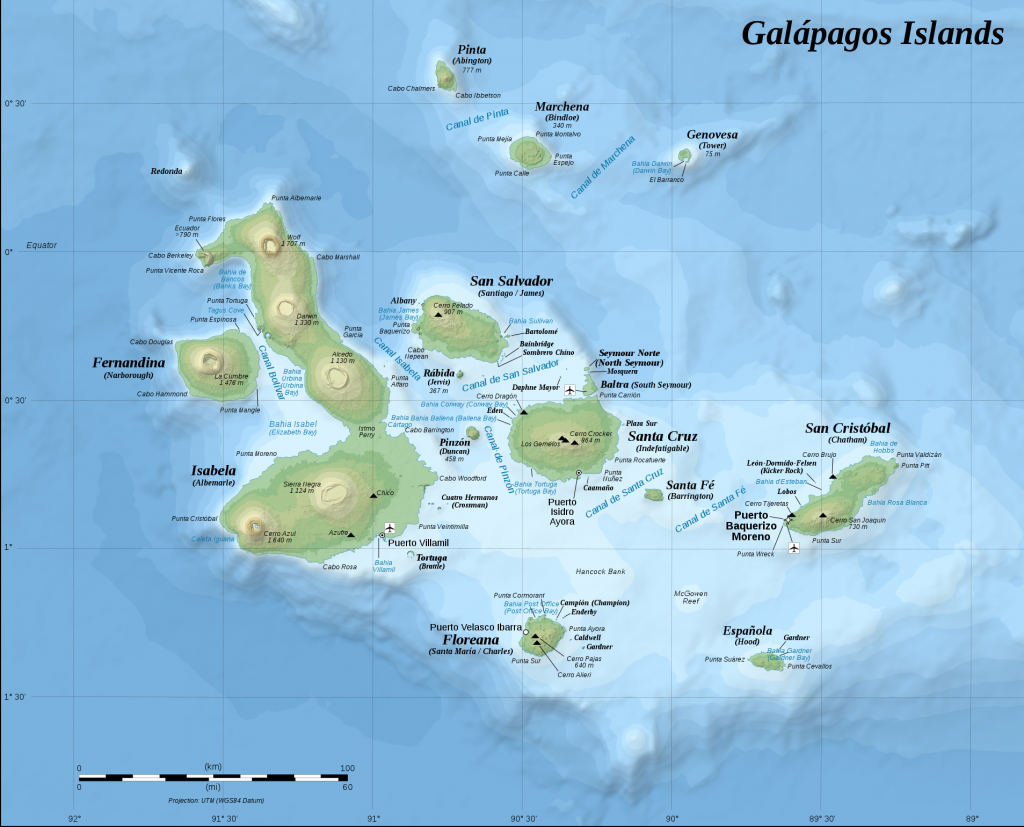
We had sailed 955 nautical miles in nine days and 11 hours, at an average speed of 4.2 knots, including quite a lot of motoring in calms. For us, a slow passage.
Once anchored there was less motion than we feared, and we had a good night.
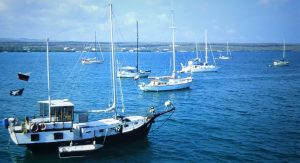 We then a very busy and tiring day – so often the situation after a long passage! The first problem was that the fibreglass dinghy was making water. It seemed that when taking the stern anchor out, I had knocked a hole in the hull. So, when we rowed ashore, Norma had to plug the hole with her finger.
We then a very busy and tiring day – so often the situation after a long passage! The first problem was that the fibreglass dinghy was making water. It seemed that when taking the stern anchor out, I had knocked a hole in the hull. So, when we rowed ashore, Norma had to plug the hole with her finger.
Ever since Charles Darwin visited the Galapagos in 1835, these islands had fired the interest of naturalists worldwide. There are few if any other places on earth where the ecosystem has been so little altered by man. Interacting with the wildlife here has long been the main reason for visiting, and we were strongly looking forward to all that.
But while it’s a substantial endeavour to get to the Galapagos Islands, it’s even more of a battle to get permission to cruise around them in your own boat. We had, however, managed to do both.
The story was that in April 1988, when we were still in England, Norma had visited the office of the Ecuadorian Consul General in London. The lady there was really very helpful, and gave Norma a pile of documents, including a set of instructions on how to go about the application and a pro-forma letter in Spanish. We complied with every request to the letter, and attached copies of our passports, ship’s papers, certificates of competency and any other piece of paper that a comprehensive bureaucratic mind could dream up. Please allow plenty of time for permission to come, they said. So we did wait, and sure enough in October we got a letter from the Consulate, informing us that indeed the Ministry of Agriculture had given us permission to stay for up to 15 days in the islands. Later, we were to establish that we were one of the very last orivate yachts to get such permission.
The first stop was at the Ayora Port Captain’s office, where we had to wait while several other crews were managing their own documentation. We then showed the Port Captain the correspondence, but he was not interested in the one from the Ecuadorian Ministry of Agriculture. It seemed that the Port Captain (an officer in the Ecuadorian navy) wanted to see a letter from the Ministry of Defence, his superiors. After we pressed the matter and asked him to double check, he found that a list of approved vessels sent to him from the mainland did include the name of our yacht. As far as he was concerned, therefore, we were free to go.
The next stop was up at the National Park administrative centre. They wanted to see the Ministry of Agriculture’s letter, but this was still being held by the Port Captain. Also, they told us we had to sign on a guide to take aboard for our cruise of the islands, which we did know and had foreseen. Outside the office we were approached by several men wanting to be a guide, but none was very impressive. We called in at the Qasar Nautica crewed yacht charter company office for advice, and they suggested we go to the house of a guide they could recommend.
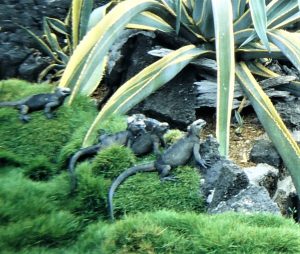 The guide they recommended was Veronica, with whom we caught up for lunch at the Galapagos Hotel. She was ideal: a graduate with excellent English who had lived in Massachusetts, the daughter of a J Walter Thomson advertising executive. We signed her on for a five-day tour at $40 a day. The only catch was that we had to take her daughter along as well, two and a half-year-old Daniela. We thought we could live with that, although we'd never had a child aboard at sea, and it worked out all right.
The guide they recommended was Veronica, with whom we caught up for lunch at the Galapagos Hotel. She was ideal: a graduate with excellent English who had lived in Massachusetts, the daughter of a J Walter Thomson advertising executive. We signed her on for a five-day tour at $40 a day. The only catch was that we had to take her daughter along as well, two and a half-year-old Daniela. We thought we could live with that, although we'd never had a child aboard at sea, and it worked out all right.
Having retrieved from the Port Captain our letter from the Ecuadorian consulate saying that we had the agriculture ministry's permission, we trudged back to the park office. This was a hot walk through cactus forests, the tropical sun bouncing off the black lava rocks. Down at the harbour end, the unique marine iguanas were active and plentiful, particularly around the cactus. We had to be careful not to tread on them, because they did not get out of our way at all.
Proudly, I flourished the letter we had, but we were informed that, no, this was not good enough. What they needed was a letter direct from the Ministry, on Ministry letterhead. Without that, no go. We appealed, and with Veronica's urging the official then radioed his bosses in Quito, on the mainland. Give them three days for a tour, they said to him. Not enough said Veronica, representing us strongly by that time, with her fee riding on the outcome. How long does the Ministry of Defence say they can stay? Fifteen days. Then give them a set itinerary for 15 days, including land trips. No, no, that’s not what they want, she replied. So, finally they approved our planned five-day trip. All we had to do was pay the US$40 each for our park entry tickets (payable by anyone who entered national park land, even those like the short-stay yachts taking day trips already costing at least that much), plus another $20 each for the privilege of taking our own boat to the visitor sites.
That pair of twenty dollars had to be deposited in the town’s only bank. A new catch: the bank neither changed nor accepted US dollars for depositing, and would only take the official Ecuadorian sucre. The only currency change possible was at a poor rate in the street. Another anguished call to the park authorities brought agreement that they would accept whatever we could get. And thus, after three days labour, we finally received the authorisation we thought we already had before we had even arrived.
We still seemed to have a lot to do, and the next step was to arrange for some fuel. We had used more than usual on our slow passage, and we would need plenty for our tour. Sure enough, fuel was found to be a problem. The problem was that there were no private fuel supplies on the islands. All fuel was state owned by the Navy, Electricity Commission, public works or whatever. Fuel needed for private cars had to be imported from the mainland by the individual concerned, who was not allowed to sell it on. Basically, therefore, there was no fuel for sale. However, the officials of the various authorities found it possible to bend the rules far enough to supply yachts from public supplies if they were available. The Port Captain suggested that we simply leave our containers with him, so we returned and left some jerrycans to be picked up later.
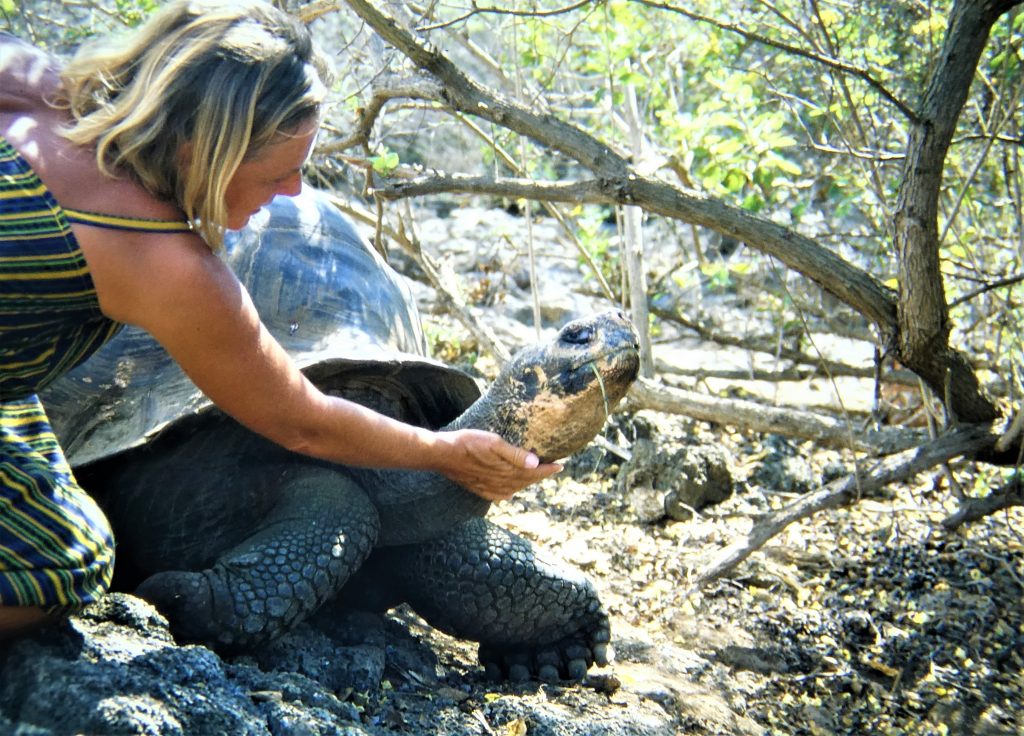 We took the long hot walk up to the Charles Darwin Research Station. Darwin spent 35 days in the Galapagos as naturalist aboard the HMS Beagle, and his observations there led to his elaboration of his theory of evolution. It was 24 years later that he published On the Origin of Species, which gave the islands endless fame.
We took the long hot walk up to the Charles Darwin Research Station. Darwin spent 35 days in the Galapagos as naturalist aboard the HMS Beagle, and his observations there led to his elaboration of his theory of evolution. It was 24 years later that he published On the Origin of Species, which gave the islands endless fame.
We worked our way through the information displays and joined a group being led by Veronica to the tortoise breeding centre. The young tortoises were classified by age and island, having been brought here for incubation and hatching free of introduced predators.
The next step was to the main tortoise enclosure. Norma’s favourite tortoise liked being stroked; others slept among the bushes. While long extinct throughout most of the world, the giant tortoise in the Galapagos still dominated the land in a way that had not been seen since the passing of the dinosaurs.
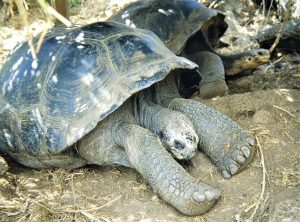 We did some basic shopping on the way back to the boat and looked for a decent guidebook in English, but in vain. Around the wharves there were hundreds of marine iguanas, the only lizards in the world that feed in the sea on marine algae.
We did some basic shopping on the way back to the boat and looked for a decent guidebook in English, but in vain. Around the wharves there were hundreds of marine iguanas, the only lizards in the world that feed in the sea on marine algae.
Checking back with the Port Captain we found he had done nothing about fuel; he and his officials were all full of alcohol, as the main supply ship was in and this involved a good deal of hospitality. Once back aboard, we were visited by the manager of the Qasar Nautica operation, David Gayton, who hoped soon to be visiting Australia, where he had family connections.
It was little comfort to learn that both Annika and Gunilla were also having problems with officials and fees – even though neither had plans to cruise the other islands.
David suggested we try the supply ship, but there was too much going on to make that possible. However, there was a tuna seine fishing boat also out at anchor, and we had heard somewhere that they might help. We went out to them with the jerries, and Norma’s Spanish immediately ensured our welcome. They quickly filled our jerries, and the captain waved away my offer of money.
So, finally, one morning we went ashore to pick up Veronica and Daniela and for clearing out by the Port Captain’s office. This was comparatively easy, once we had winkled him out of a restaurant, filled in a form relating to port dues (legal, small ones), gone over the street to a shop to buy copies of the actual clearance forms (only used by the Port Captain), and taking these back for more laborious typing. We were then free to leave.
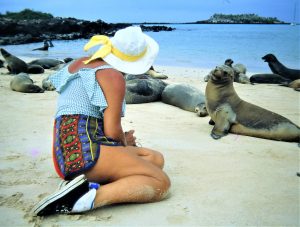
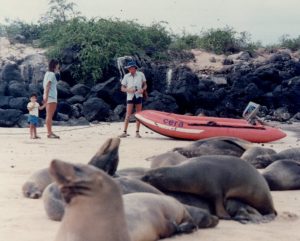 Then out we went, passing by the friendly fishing boat and exchanging waves. There was just enough wind to sail for a while, and it was good to get away. We did not have far to go, about 15 nautical miles to the small island to the southeast, Isla Santa Fe.
Then out we went, passing by the friendly fishing boat and exchanging waves. There was just enough wind to sail for a while, and it was good to get away. We did not have far to go, about 15 nautical miles to the small island to the southeast, Isla Santa Fe.
On final approach we were welcomed by scores of sealions swimming out to us, honking and barking from the water and the shore. We anchored in Barrington Bay, on the north-east corner of the island. The bay was protected from the open sea by a narrow spit of land, and was a lovely place to stop.
We were quickly ashore on the spit but not made welcome by a bad-tempered big male sealion. The many females just lolled around and observed the scene in peace, with rather soppy looks from sleepy eyes.
We took the inflatable dinghy out to anchor and swam from it. We were 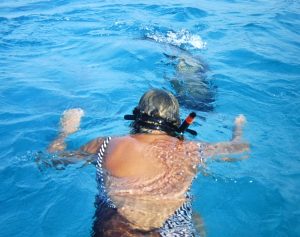 immediately surrounded by sealions having a wonderful time twisting and turning along with us. A game was to swim rapidly towards us and turn away at the last moment; most were blowing streams of bubbles, and Norma teased them by blowing bubbles back. She laughed so much she nearly drowned! They were much diverted by the dinghy anchor and anchor rope, which they tugged and pulled until finally uprooting it and tried to tow us away.
immediately surrounded by sealions having a wonderful time twisting and turning along with us. A game was to swim rapidly towards us and turn away at the last moment; most were blowing streams of bubbles, and Norma teased them by blowing bubbles back. She laughed so much she nearly drowned! They were much diverted by the dinghy anchor and anchor rope, which they tugged and pulled until finally uprooting it and tried to tow us away.
It was all a wonderful experience. Norma had spent years dreaming of swimming with the sealions in the Galapagos, and for her in particular, this was a dream fulfilled. She said she had now “done the Galapagos!”
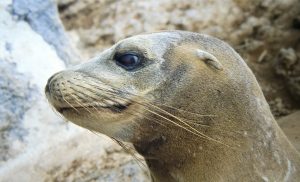 We then went to the big sandy beach at the head of the bay where there were more swarms of sealions. Some females seemed to want to get friendly, sidling up with half-turned head like a shy
We then went to the big sandy beach at the head of the bay where there were more swarms of sealions. Some females seemed to want to get friendly, sidling up with half-turned head like a shy  and dopey Labrador. We walked a trail to the top of an escarpment past extraordinary tree-like opuntia (prickly pear) cacti, with bark that prevents iguanas eating too much of it
and dopey Labrador. We walked a trail to the top of an escarpment past extraordinary tree-like opuntia (prickly pear) cacti, with bark that prevents iguanas eating too much of it
Up there we also came across just such an iguana, the variety of land iguana unique to this island, a big fellow. These iguanas are paler and have a more pronounced dorsal crest than others in the Galapagos. Little Galapagos doves, with blue-circled eyes and pink fronts, were flying around and worrying the soil like chickens, completely ignoring our close presence.
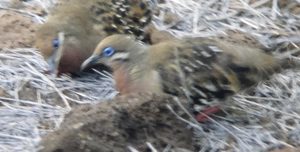 Guides were supposed to accompany visitors closely at all times, but as soon as Veronica realised that we knew what we were doing and our responsibilities – such as sticking to the trails and not disturbing the wildlife - when we went ashore she left us alone while taking Daniela for simpler walks along with herself.
Guides were supposed to accompany visitors closely at all times, but as soon as Veronica realised that we knew what we were doing and our responsibilities – such as sticking to the trails and not disturbing the wildlife - when we went ashore she left us alone while taking Daniela for simpler walks along with herself.
After a hot and steamy night we were up early because we had a fair way to go. We headed north along the east side of Santa Cruz and rounded the top through the Seymour Channel. Here we caught a big fish, a “Sierra” (Spanish mackerel) 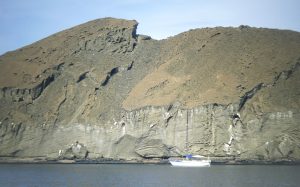 according to Veronica, looking like a wahoo with yellow spots. By early afternoon we reached Isla Bartolome, a small island lying just to the east of the big Isla Santiago. We looked around for a good anchorage with minimal northerly swell and tucked in south of the small peninsula and cliffs at the west end of the island. It was well protected from the wind, but therefore very hot!
according to Veronica, looking like a wahoo with yellow spots. By early afternoon we reached Isla Bartolome, a small island lying just to the east of the big Isla Santiago. We looked around for a good anchorage with minimal northerly swell and tucked in south of the small peninsula and cliffs at the west end of the island. It was well protected from the wind, but therefore very hot!
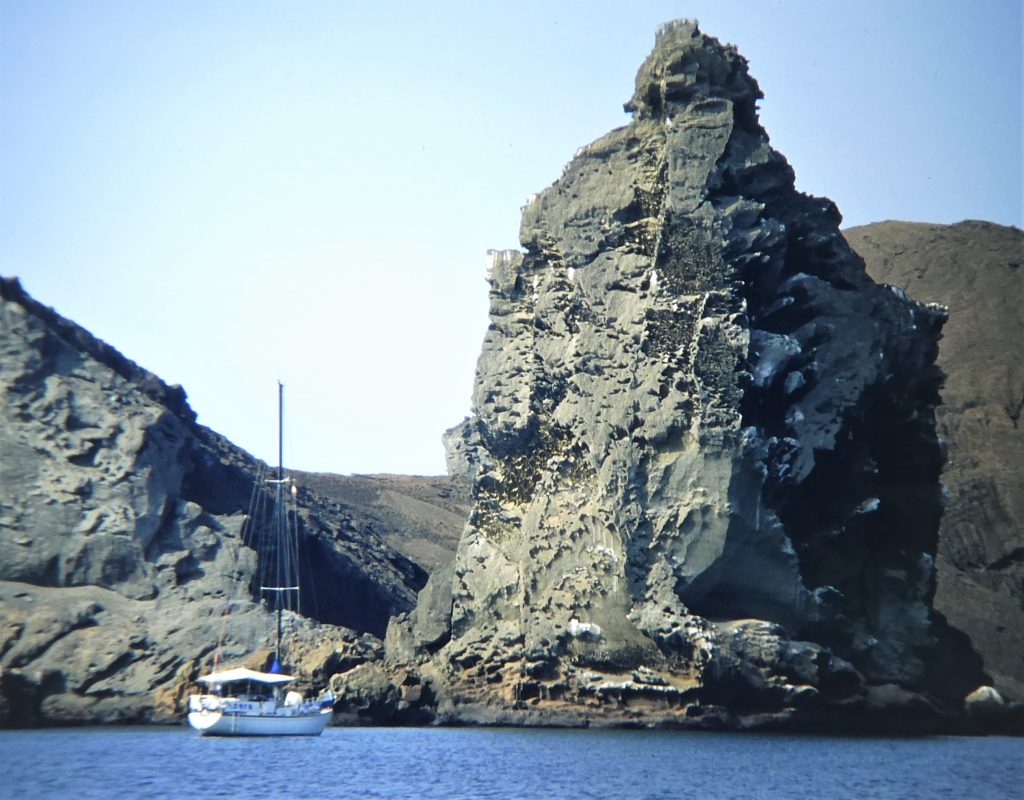 We took the dinghy round to the north side of Isla Bartolome and to a beach by the dramatic and extremely photogenic Pinnacle Rock. The rocks were swarming with red “Sally Lightfoot” crabs, so named because their delicate movements were supposed to mimic the movements of a Jamaican dancer known by the same nickname. We swam off the beach
We took the dinghy round to the north side of Isla Bartolome and to a beach by the dramatic and extremely photogenic Pinnacle Rock. The rocks were swarming with red “Sally Lightfoot” crabs, so named because their delicate movements were supposed to mimic the movements of a Jamaican dancer known by the same nickname. We swam off the beach 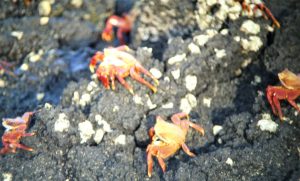 to snorkel, and Norma found herself in the middle of a solid group of the small Galapagos penguins, the only ones in the world to live anywhere near the equator, quite unconcerned as they swam around and underneath her, popping up and
to snorkel, and Norma found herself in the middle of a solid group of the small Galapagos penguins, the only ones in the world to live anywhere near the equator, quite unconcerned as they swam around and underneath her, popping up and  meeting her eye to eye. A huge stork waited for us on the beach, again totally unconcerned by us.
meeting her eye to eye. A huge stork waited for us on the beach, again totally unconcerned by us.
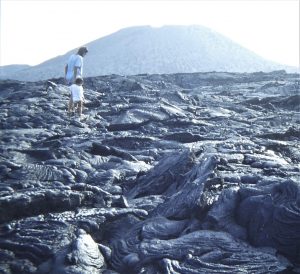 We took the dinghy over to Santiago, and the extraordinary black lava flow which covered much of its landscape. It had solidified as a rocky mousse with a shiny shell, whorled and twirled into rope like patterns, interspersed with solidified and dry mud pools. Hardy little “pioneer” plants were establishing footholds in the moonscape. We dinghied into a little cove within the lava flow and came across a family of sealions, including the usual protective and noisy male, shouting and torpedoing us.
We took the dinghy over to Santiago, and the extraordinary black lava flow which covered much of its landscape. It had solidified as a rocky mousse with a shiny shell, whorled and twirled into rope like patterns, interspersed with solidified and dry mud pools. Hardy little “pioneer” plants were establishing footholds in the moonscape. We dinghied into a little cove within the lava flow and came across a family of sealions, including the usual protective and noisy male, shouting and torpedoing us.
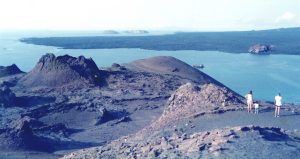 Our evening meal was the Sierra we had caught on the way, great eating, with firm white flesh.
Our evening meal was the Sierra we had caught on the way, great eating, with firm white flesh.
The night was swell-free, and we were up early for an expedition before it got too hot. We took the boat round to anchor near the pinnacle rock and landed the dinghy on a rocky spit. From there we toiled up a steep, dusty and stony trail to the peak of the volcanic hill overlooking the bay. On each side of the trail there was more jumbled lava and small red-brown craters. From the top there was a staggering view over clumps of mangroves, beaches, the prominent pinnacle, and over to Santiago island and the acres of black lava. It was a great experience to see our little yacht, which had come so far, anchored among this iconic spectacle.
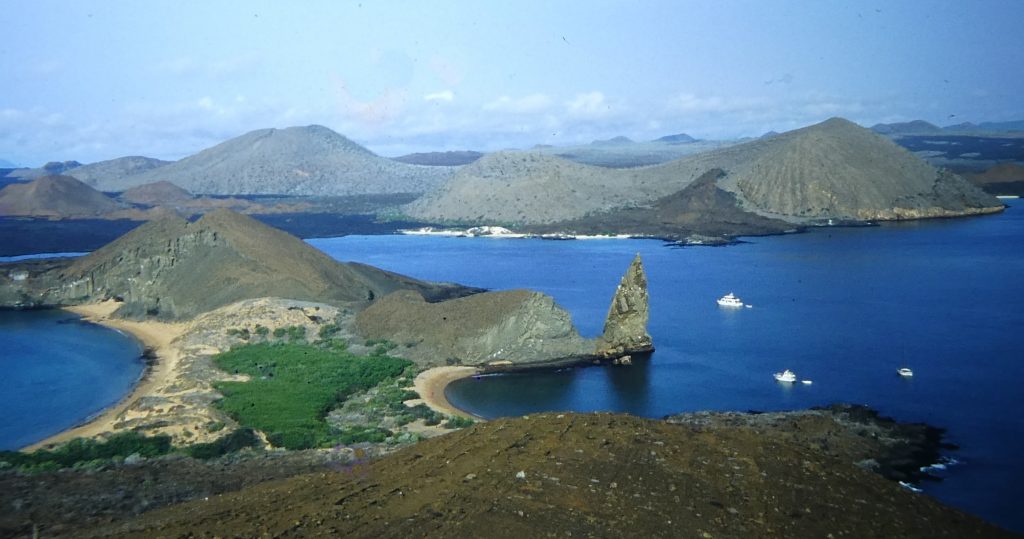
We returned to the boat for breakfast and then actually sailed for a while, peacefully down to the north coast of Santa Cruz. We caught another fish on the way, not so big this time and easier to handle.
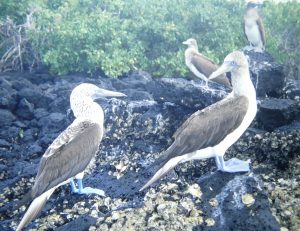
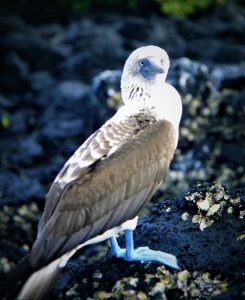 We anchored off the rocky shore and took the dinghy into Caleta Tortuga Negra, or Black Turtle Cove. Within the long but shallow inlet the black rocks were backed by solid mangroves. Blue-footed boobies were sitting on the rocks at the entrance and diving on fish. They were all fearless, as far as we were concerned. In the inner reaches of the inlet, shadows in the water revealed themselves as turtles by the score, lazily paddling round us and periodically poking their heads above water for a look at us and taking a huffy breath of air. In a brackish lagoon behind an adjacent beach three pink flamingos stood peacefully on one leg.
We anchored off the rocky shore and took the dinghy into Caleta Tortuga Negra, or Black Turtle Cove. Within the long but shallow inlet the black rocks were backed by solid mangroves. Blue-footed boobies were sitting on the rocks at the entrance and diving on fish. They were all fearless, as far as we were concerned. In the inner reaches of the inlet, shadows in the water revealed themselves as turtles by the score, lazily paddling round us and periodically poking their heads above water for a look at us and taking a huffy breath of air. In a brackish lagoon behind an adjacent beach three pink flamingos stood peacefully on one leg.
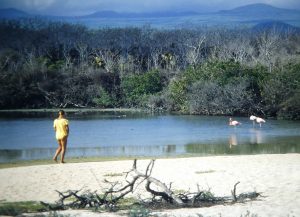 The next morning we took the dinghy along to the nearby Bachas beach. Its steeply sloping golden sand was covered by the tracks of turtles going to their nests at the top of the dune. Over the top of the dune there was a still lagoon with more bright pink flamingos.
The next morning we took the dinghy along to the nearby Bachas beach. Its steeply sloping golden sand was covered by the tracks of turtles going to their nests at the top of the dune. Over the top of the dune there was a still lagoon with more bright pink flamingos.
After extracting the anchor from the rocky seabed we had a gentle sail under #1 headsail and awning up to the south side of North Seymour Island. We didn’t like the look of the “anchorage” near the landing place, so went over the adjacent little Mosquera Island and anchored in its lee off a beach.
Sealions reclined in the sun, from time to time playfully rolling down the sand dunes towards the sea. We took the dinghy back to what was laughingly referred to as a “dry landing”, a rocky little jetty to which we tied the dinghy with an anchor 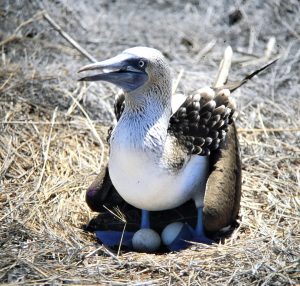 out to hold it off. Immediately after starting on the island’s exploratory trail we came across the first of the nesting blue-foot boobies, sitting unconcernedly on two eggs right by the trail.
out to hold it off. Immediately after starting on the island’s exploratory trail we came across the first of the nesting blue-foot boobies, sitting unconcernedly on two eggs right by the trail.
As we walked on we saw more nests all over, just shallow depressions with one bird – male or female – on one or two eggs. Around each nest was a ring of guano, sprayed by the birds as they rotated to keep the eggs in the shade of the sun, heads up to expose the fluttering membrane of the lower beak. None was in any way worried; some nests were actually on the path and we had to walk round them.
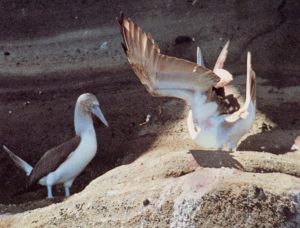 A couple of boobies went through their entire courtship ritual at the side of the trail as we watched from a few feet away. In a stately dance, they lifted one blue foot after the other in unison, and in culmination set the “sky-pointing” position, beaks, tails and wings all pointed skyward as they squealed and squawked at each other.
A couple of boobies went through their entire courtship ritual at the side of the trail as we watched from a few feet away. In a stately dance, they lifted one blue foot after the other in unison, and in culmination set the “sky-pointing” position, beaks, tails and wings all pointed skyward as they squealed and squawked at each other.
On another part of the island the boobies gave way to the frigatebirds, with most of their nests in scrubby bushes high enough to give them a chance of getting 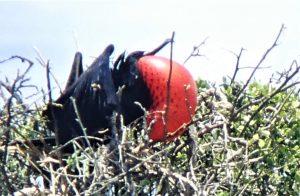 launched; stupendous flyers, they are not so good close to the ground. The brilliant red throat membranes of the males were mostly inflated as they displayed and preened before the females. Many more soared overhead, sometimes whooshing down past us on their way to their nests.
launched; stupendous flyers, they are not so good close to the ground. The brilliant red throat membranes of the males were mostly inflated as they displayed and preened before the females. Many more soared overhead, sometimes whooshing down past us on their way to their nests.
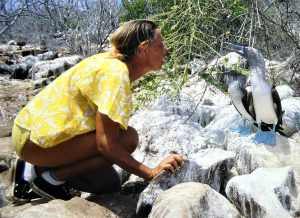 A surf was breaking along the shore, and in it yet more sealions played, body-surfing in towards the rocks, their brown, streamlined forms luminescent in the transparent, curling waves. We came across more sealions and marine iguanas, and the harmless snake of the island slithered past us as we walked back to the dinghy along a low clifftop path, as unfearing as any other of the creatures all around us.
A surf was breaking along the shore, and in it yet more sealions played, body-surfing in towards the rocks, their brown, streamlined forms luminescent in the transparent, curling waves. We came across more sealions and marine iguanas, and the harmless snake of the island slithered past us as we walked back to the dinghy along a low clifftop path, as unfearing as any other of the creatures all around us.
Back in the boat early afternoon we were then away again down the east side of Santa Cruz to a parallel pair of low, flat little islands, the Islas Plaza. We caught a tuna on the way, and just before we got to the islands as the sun went down, Veronica brought in a good-sized amberjack. We anchored between the low, flat islands off the north side of Isla Plaza Sur.
 Of course, we were welcomed again by sealions, spiralling up the anchor chain and snuffling around the dinghy. Over evening drinks we listened to their variety of voices: an old man coughing, a sheep baaing, a donkey braying, a cow mooing – wonderful!
Of course, we were welcomed again by sealions, spiralling up the anchor chain and snuffling around the dinghy. Over evening drinks we listened to their variety of voices: an old man coughing, a sheep baaing, a donkey braying, a cow mooing – wonderful!
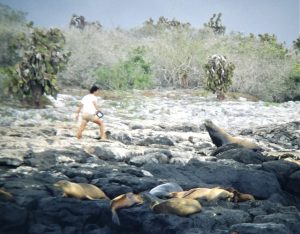
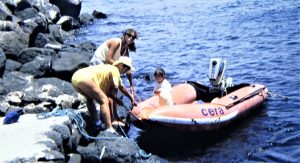 There was very little roll overnight, and we were up early for our walk ashore. We were just beaten to it by a tourist boat. Their tour guide had a lot of trouble clearing a notoriously aggressive bull sealion off the little stone jetty, getting close then running away so that the sealion would leave the jetty and chase him. Veronica told us that another tour guide had been bitten only a week before while doing that trick!
There was very little roll overnight, and we were up early for our walk ashore. We were just beaten to it by a tourist boat. Their tour guide had a lot of trouble clearing a notoriously aggressive bull sealion off the little stone jetty, getting close then running away so that the sealion would leave the jetty and chase him. Veronica told us that another tour guide had been bitten only a week before while doing that trick!
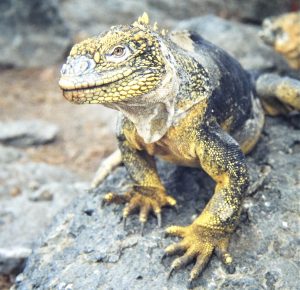 Near the jetty there were lots of land iguanas. We were told that until recent times they had been fed by visitors. They sidled down to meet us, but as in the case of all the creatures of the islands, all visitors were under strict instructions not to feed or touch them. These iguanas, indeed, were at one time in danger of rapidly dying out, because with all the human attention they were getting they were forgetting how to eat for themselves (tasty, but prickly, cactus) or even reproduce.
Near the jetty there were lots of land iguanas. We were told that until recent times they had been fed by visitors. They sidled down to meet us, but as in the case of all the creatures of the islands, all visitors were under strict instructions not to feed or touch them. These iguanas, indeed, were at one time in danger of rapidly dying out, because with all the human attention they were getting they were forgetting how to eat for themselves (tasty, but prickly, cactus) or even reproduce.
 At the end of the island there were swallow-tailed gulls on the cliffs, some nesting with chicks. Marine iguanas were in and around the water, and a couple of them were annoying a bull sealion.
At the end of the island there were swallow-tailed gulls on the cliffs, some nesting with chicks. Marine iguanas were in and around the water, and a couple of them were annoying a bull sealion.
There were lots of cacti around, some 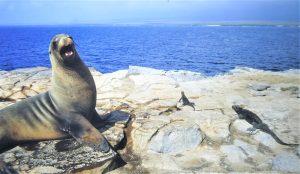 showing bites the iguanas had taken. Returning to the dinghy, we found sealions were already playing with the lines securing it. We took it over to the opposite side of the anchorage, against other little island, and had a final swim with the sealions, looping and twisting around us and worrying at the dinghy anchor line.
showing bites the iguanas had taken. Returning to the dinghy, we found sealions were already playing with the lines securing it. We took it over to the opposite side of the anchorage, against other little island, and had a final swim with the sealions, looping and twisting around us and worrying at the dinghy anchor line.
 We were away before lunch and almost immediately caught a tuna while leaving the anchorage. We had a good sail back down to Puerto Ayora, where the wind was blowing right into the exposed bay and made the water very rough. We anchored about where we were before, helped by David Gayton taking out our stern anchor.
We were away before lunch and almost immediately caught a tuna while leaving the anchorage. We had a good sail back down to Puerto Ayora, where the wind was blowing right into the exposed bay and made the water very rough. We anchored about where we were before, helped by David Gayton taking out our stern anchor.
We then took Veronica and Daniela back home. They had both been good company and Veronica was an excellent and friendly guide.
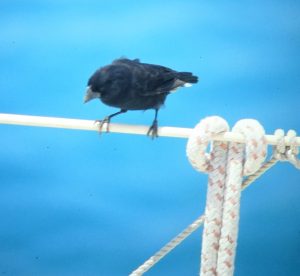 The night was rolly but the wind died by morning. We took a load of washing to Veronica’s house and bought some veg and non-perishable stores at the supermarket. In the afternoon we went up to the house of Augusto Cruz and his English wife Georgina. They were skippering a cruise boat that we had met at Bartolome. Georgina produced two crates of books about to be burnt, and a pile of Spectator magazines! Very valuable, and we filled a box with good reading.
The night was rolly but the wind died by morning. We took a load of washing to Veronica’s house and bought some veg and non-perishable stores at the supermarket. In the afternoon we went up to the house of Augusto Cruz and his English wife Georgina. They were skippering a cruise boat that we had met at Bartolome. Georgina produced two crates of books about to be burnt, and a pile of Spectator magazines! Very valuable, and we filled a box with good reading.
Augusto also filled our jerries with fuel, and we retrieved our washing from Veronica.
In the morning we had to go through the agonies of clearing out. The immigration officer stamped us out, and it was then down to the Capitaneria. The Port Captain asked if we had paid the park fees – yes, on arrival, we confirmed – but we still had to pay minimal clearance and port charges. Finally cleared, we bought some tee shirts at the tourist shop to dispose of our last local currency. A Galapagos finch landed on the lifelines, which had to be a good omen for the passage.
And so to the boat, we got squared away, and we felt entirely ready for the long passage to which we were now looking forward. We thought we would remember the animals and birds of the Galapagos long after we had forgotten the problematic officialdom.
Galapagos to French Polynesia
The passage from the Galapagos to the Marquesas was the last of the mammoth 3000+ milers for a while, thank goodness. We left in the afternoon after getting everything ready, and motored out into a very light south-east breeze. By midnight we were going well, with the wind already having a trade feel to it. This was a relief, because we had thought we would have to get further south from the Galapagos before the trades really set in. After breakfast we caught a nice bonito, and we felt that we were again settling in well to the way of life of two people at sea in a small boat for about three weeks.
The pattern of the days soon became quite consistent, with light airs in the morning gradually building but not changing much in direction. Once well-established, the trade wind strength typically peaked in the late afternoon, sometimes accompanied by darker clouds and showers. The seas were slowly building, but we were making great time; during one 24-hour period we made 170 nautical miles, among our best ever, without stressing the boat or us too much and we were still sleeping well.
At night, during the first week, we had a good bright moon. After the moon disappeared there were times, when the skies were cloudy, that we literally could not see our hands before our face. The most memorable event of that first week was our accompaniment by the biggest whale we had come across, a sperm whale we thought, a lot longer and bigger than our boat. As ever with whale encounters, we welcomed them as curious visitors but were not sorry to see them move away.
As usual on a long passage we changed watch at intervals of about three hours, but each would wait until the other woke up before making the change. Norma usually took the first night watch because she liked to sleep after dinner; I normally took the last night watch until dawn broke for breakfast. During the day we slept when we felt like it, but with one of us awake at all times, having a look around what were practically always empty seas. But not always; on a few occasions, such as when we were about as far away from land as is possible anywhere on earth, about half way between the Galapagos and Marquesas, we did see a few large fishing boats, mainly Korean.
We fished quite successfully ourselves, with enough tuna and dorados attracted to our towed lure to easily keep us fed. Norma baked bread every few days. We read, listened to music, navigated and plotted our gradually-moving position on the chart, kept up with sail and boat maintenance and followed weather patterns on the weatherfax. Every few days we had to adjust the ship’s clocks to keep up with our changes in longitude. Around the middle of the day I would take sun sights with the sextant to confirm the satellite fixes. As the sun went down on clear evenings we would watch out for the “green flash”, a phenomenon that can only be seen when the horizon is absolutely clear and free of clouds. For less than a second, as the sun finally dips below the horizon, the spectrum of its last light turns green.
As the days went by and we entered the second week out, the winds generally increased, sometimes with uncomfortable quartering seas with a two to three-metre swell. We were having to attend to more sail changes and adjustments while still maintaining good speed but well within our capacity and that of the boat. We were still covering between 140 and 160 nautical miles a day.
The lower spreaders were losing their anti-chafe wrapping and damaging the mainsail, which was almost always being pressed hard against them. The most difficult repairs we had to do on this passage were for Norma to repair the mainsail tears, which she did on deck with the main down to the third reef; and for me to climb the mast to the lower spreaders to re-wrap the ends.
As we approached the end of the third week the wind lightened and became more variable in direction. It was getting much hotter, and Norma took to sitting right at the bow watching the pilot fish that were usually accompanying us.
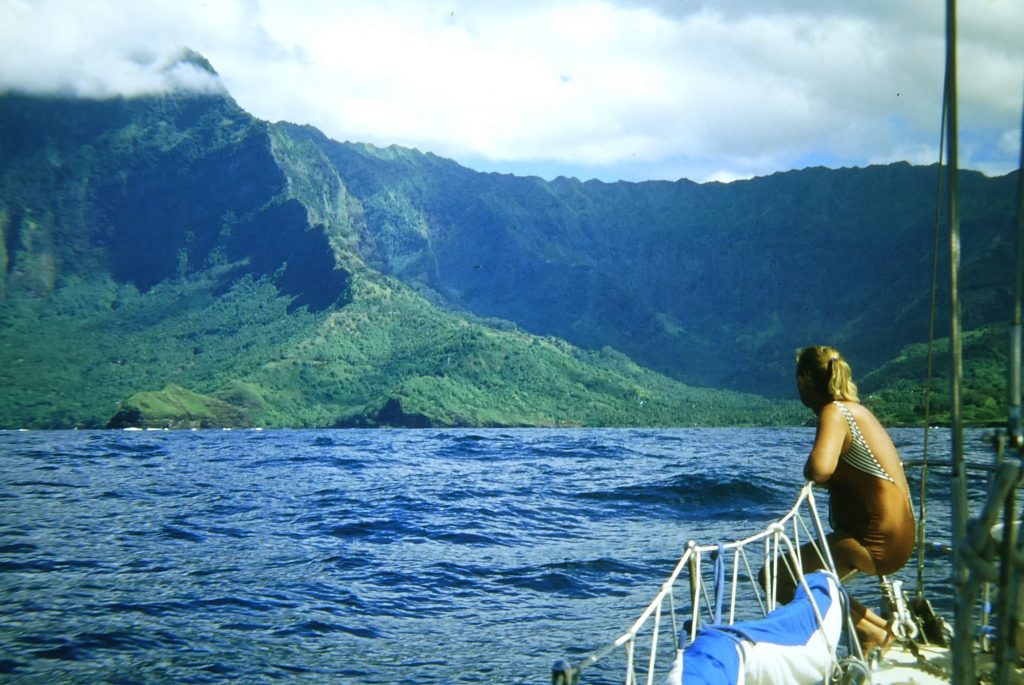 During the final night we slowed right down in order not to get too close to the Marquesas in the dark. Since the middle of the night we had been hit by heavy squalls and rain under black clouds. We dropped the headsail. At first light we could see the small island of Motane to the south and the forbidding black bulk of Hiva Oa directly ahead, rising out of a grey sea.
During the final night we slowed right down in order not to get too close to the Marquesas in the dark. Since the middle of the night we had been hit by heavy squalls and rain under black clouds. We dropped the headsail. At first light we could see the small island of Motane to the south and the forbidding black bulk of Hiva Oa directly ahead, rising out of a grey sea.
We got under way again under solid overcast skies at 6:00 am after a tiring night. As the sun at last emerged, we ticked over 3,000 nautical miles since leaving Ayora. As we neared Hiva Oa, under the weak sun, the island could be more clearly seen as dark green and lush under knife-like crests along the mountain tops, an impressive approach that took longer than expected because the island was further away than it looked.
We entered the vast east-facing Ta’aoa Bay on the south side of the island and then the smaller inlet of Taha Uku bay, the entrance of which was very hard to see. This was the tiny port of Atuona, where we anchored at 11:00 am local time.
Since leaving the Galapagos we had covered a total of 3,011 nautical miles in 20 days and 22 hours at an average of 6 knots, with the engine only used for battery charging. It would be our last mega-passage before returning to Sydney, but we still had a whole lot of the Pacific Ocean to traverse!
The Marquesas Islands
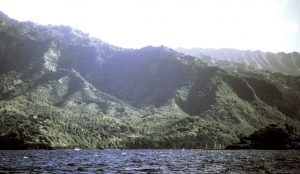 We could see white water to our left as we entered narrow Taha Uku Bay, and surf on the black sand at its inner end. There were about a dozen yachts anchored there, all surging and rolling in the swell, which we soon found was typical of most anchorages in the Marquesas.
We could see white water to our left as we entered narrow Taha Uku Bay, and surf on the black sand at its inner end. There were about a dozen yachts anchored there, all surging and rolling in the swell, which we soon found was typical of most anchorages in the Marquesas.
The wild and rugged Marquesas islands are the furthest north of the high islands of the South Pacific. The first European to colonise the islands were the Spanish in the 16th century, but their behaviour towards the 50,00 or so local people was brutally murderous. They were followed by slavers from Peru, and the population was drastically reduced to about 20,000 by the time the islands were annexed by France in 1842, whereupon the population was further reduced to a devastated 2,000 by 1926. At the time of our visit, the population was around 6,500.
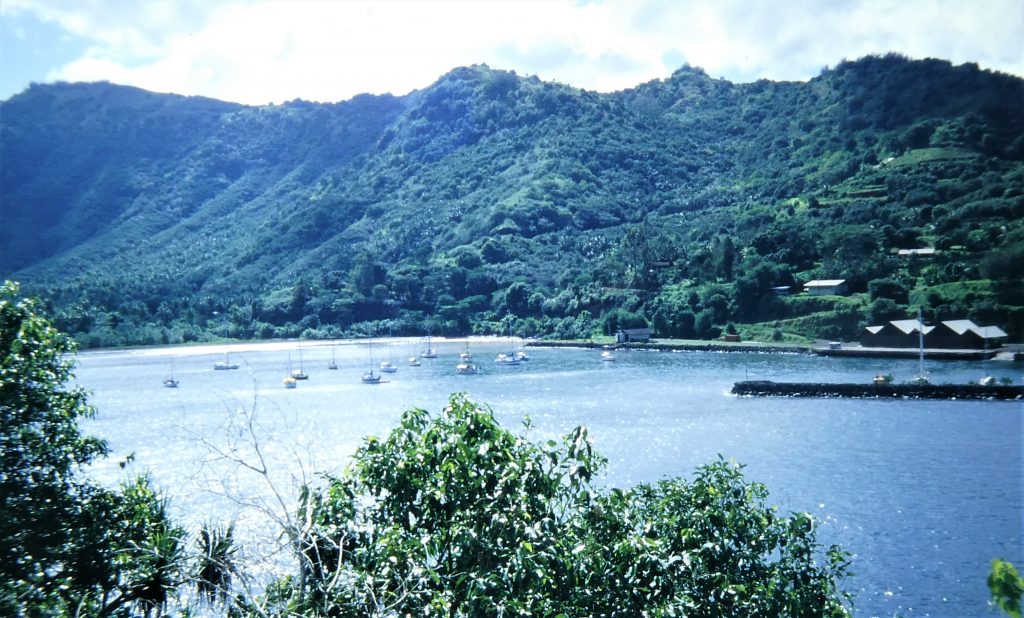 Black rocks and mangrove thickets surrounded us around the bay. Over us loomed precipitous green cliffs, because the bay was actually a volcanic crater, now open to the sea. There were landing steps on the north-west side of the bay, but landing through the breaking water would have been impossible. There was a small breakwater on the eastern side of the bay, which made the waterside a bit calmer but offered little protection for anchored boats.
Black rocks and mangrove thickets surrounded us around the bay. Over us loomed precipitous green cliffs, because the bay was actually a volcanic crater, now open to the sea. There were landing steps on the north-west side of the bay, but landing through the breaking water would have been impossible. There was a small breakwater on the eastern side of the bay, which made the waterside a bit calmer but offered little protection for anchored boats.
Norma managed to get shore on the eastern side, close to the root of the breakwater, and found a good water tap and washing facilities. She returned for water and to do the washing while I started cleaning algae and a forest of goose barnacles off the topsides along the aft quarters. Boats arriving from the US had relatively clean topsides, while those of us from the Galapagos all had some heavy cleaning work to do.
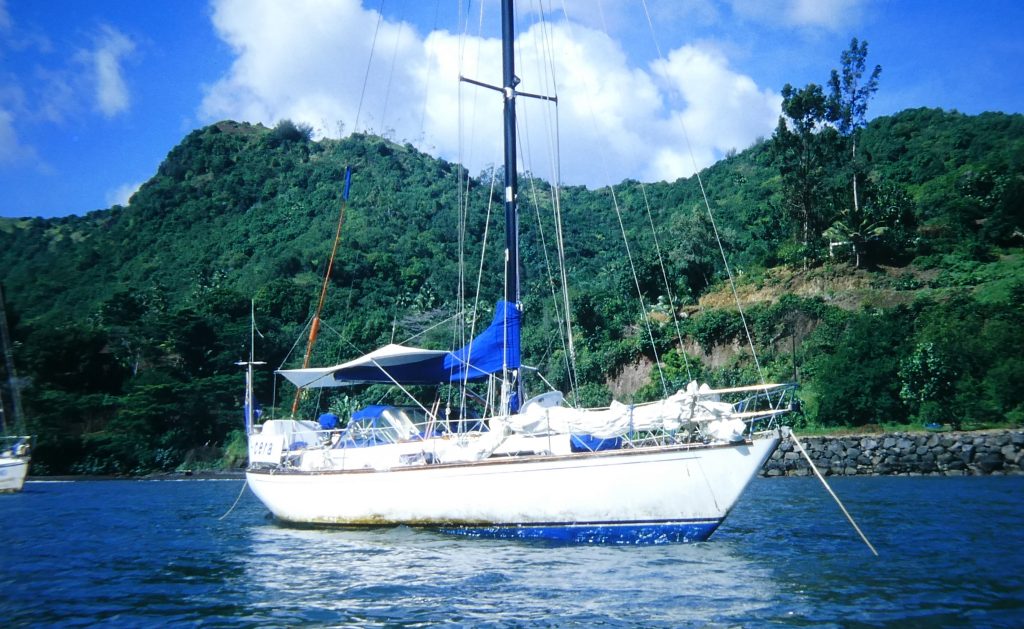
 Unfortunately Norma was very lightly clothed, in the hot and steamy conditions, when she enthusiastically went ashore for the first time since arriving. This first exposure to the notorious “no-nos”, or “no-seeums”, tiny biting flies, soon brought her up in an all-over and horribly itchy rash. They persisted for days and continued to be a pestilential problem all the time in the Marquesas. Norma took to wearing an overall lightweight “Noddy suit”.
Unfortunately Norma was very lightly clothed, in the hot and steamy conditions, when she enthusiastically went ashore for the first time since arriving. This first exposure to the notorious “no-nos”, or “no-seeums”, tiny biting flies, soon brought her up in an all-over and horribly itchy rash. They persisted for days and continued to be a pestilential problem all the time in the Marquesas. Norma took to wearing an overall lightweight “Noddy suit”.
Better clothed, we hefted the dinghy up on the rocks and walked round the head of the bay to the village of Atuona, the administrative centre for the southern Marquesas. It was made famous when Paul Gauguin went to live there in 1902 and died there a year later. . We picked up some coconuts and an orange from the ground on the way. The public buildings in the village looked quite new. The shops were adequate for basic provisions, with alcohol at high European prices.
We went to the gendarmerie to see about posting a bond, which we understood had to be done at the first port of call in French Polynesia and could not be delayed until reaching Tahiti. There was no-one in the office, but a written notice of instructions at the office confirmed these requirements. However, confusedly, it also suggested that a “visa exemption” might be possible, depending on citizenship and the intended period of stay, and arrangements completed in Tahiti. So we returned to the boat, getting a lift in a local’s jeep.
Meanwhile two Australian boats had arrived, and we all got together on Magnum, a catamaran, for a long boozy afternoon. They were all tired and susceptible to the effects of alcohol, and started an argument with each other on strategies for long-distance passage-making. The girls, generally, wanted to take a relaxed approach with little emphasis on going as fast as possible. Once we had described our own approach to passage-making, they presented us as examples for their male partners to take aboard. They noted that our passage times were not slower than theirs while our sailing appeared to be much more enjoyable. Between themselves, it all got a bit heated!
The night was, as expected, rolly, and we left early. We motored round the south side of Hiva Oa, through the Canal de Bordelais, between Hiva Oa and Tahuata islands, passing more of the dramatic Marquesan scenery: steep cliffs down to the sea, high, thin waterfalls from cloud-shrouded mountain tops. Round the north-west corner of the island the land flattened out, with grassy and gentler slopes to the waterside. We caught a nice little tuna on the way.
We rounded into Baie Hanamanu, an inlet open to the north but apparently fairly well protected. We anchored for and aft to keep us facing the sea, as some swell was rolling in. There was a little surf at the black beach at the head of the bay. There were no permanent settlements on the beach, but there were a few simple dwellings a little way in from the beach. One belonged to the welcoming Ozanne family. Norma was soon ashore, and came back with a big bag of lemons. The no-nos were bad, Norma was still terribly itchy, and we smothered ourselves in all kinds of insect repellent.
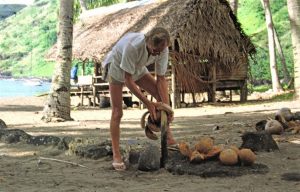
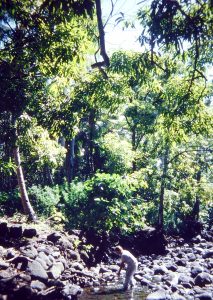 Ashore in the afternoon, I husked some coconuts on a convenient husking spike while Norma did some washing in a stream leading into the bay. Further up the stream we swam in fresh, cool water coming down from an inland waterfall. Later, a big group of local Polynesian men arrived in a fishing boat and set up a weekend camp for hunting wild pig.
Ashore in the afternoon, I husked some coconuts on a convenient husking spike while Norma did some washing in a stream leading into the bay. Further up the stream we swam in fresh, cool water coming down from an inland waterfall. Later, a big group of local Polynesian men arrived in a fishing boat and set up a weekend camp for hunting wild pig.
The swell disappeared and we had the best sleep for ages, a solid 11 hours. The locals were catching lobsters and fish from rocks near the boat, and I joined them with a spear gun with which I managed the rare event of actually spearing a few. The wind switched to the north, and gave us an uncomfortable second night here.
Ashore, we took a long walk up the river valley, through dense growth along the stream and up the slopes past mango trees and the remains of solid stone dwellings, “pae-paes”. In pre-European days the Marquesans lived in houses built on these high stone platforms. We gathered armfuls of mangoes, which Norma took back for bottling. Later, we were invited by the Ozanne family and their fishermen friends to join them for a pig feast, with the animal cooked in an omoo on the beach. The dishes included pig with wild spinach, breadfruit, sweet rice and poisson cru. It was a great party.
 But we had to get away before dark, and sailed away into unexpected clouds and squally winds. These very uncomfortable conditions continued overnight, and it was a miserable, grey dawn as we closed upon the big island of Nuku Hiva and the wide open Baie de Taiohae on its southern side. There were several yachts there, mostly in the north-west corner of the bay to avoid the worst of the incoming swell, and we joined them there. We anchored bow and stern in about eight metres, and then slept
But we had to get away before dark, and sailed away into unexpected clouds and squally winds. These very uncomfortable conditions continued overnight, and it was a miserable, grey dawn as we closed upon the big island of Nuku Hiva and the wide open Baie de Taiohae on its southern side. There were several yachts there, mostly in the north-west corner of the bay to avoid the worst of the incoming swell, and we joined them there. We anchored bow and stern in about eight metres, and then slept 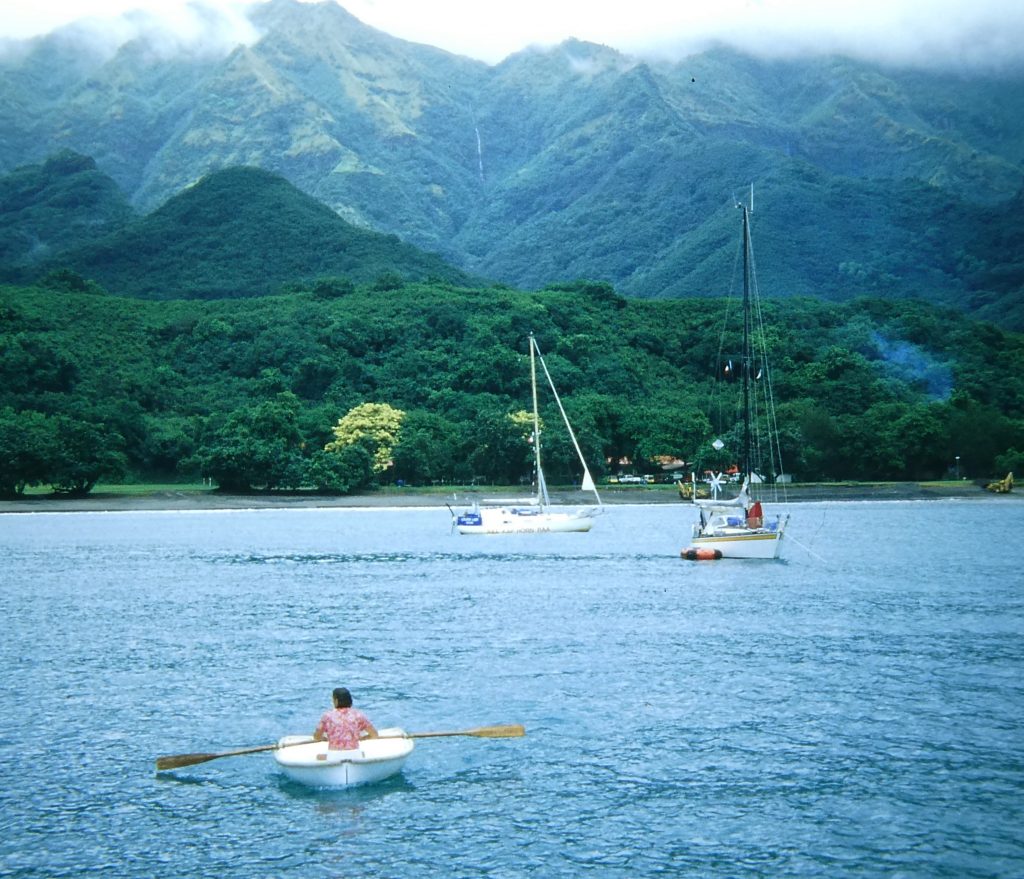 all morning and most of the afternoon after a fast but unpleasant overnight sail.
all morning and most of the afternoon after a fast but unpleasant overnight sail.
Nuku Hiva is the largest and most populated of the Marquesas, and its peak – Mount Tekao – is 1,183 metres high. The town of Taiohoe, off which we were anchored, is the administrative centre of the group. We went ashore, first to try the gendarmerie for clearance. Filling the forms was a slow process but the officials helpful and friendly. It emerged that as UK citizens we didn’t need a visa, we were given a cruising permit and told we could pay our bond in Papeete. In the evening we went up to a bar/restaurant owned by an American ex-cruising couple, for a happy hour for all at anchor.
We had aimed to move on after a day, but while recovering the stern anchor the boat surged and I disrupted a fingernail, which was very painful and put paid to any thoughts of leaving that day. We were visited by a pleasant Canadian couple, Sally and Jim in Pacific Jade, with whom we became friendly throughout our Polynesian adventures. Norma took the dinghy bravely through the surf to get some shopping. The people were not as friendly as in Hiva Oa, and no-one offered her a lift back to the shore with her load.
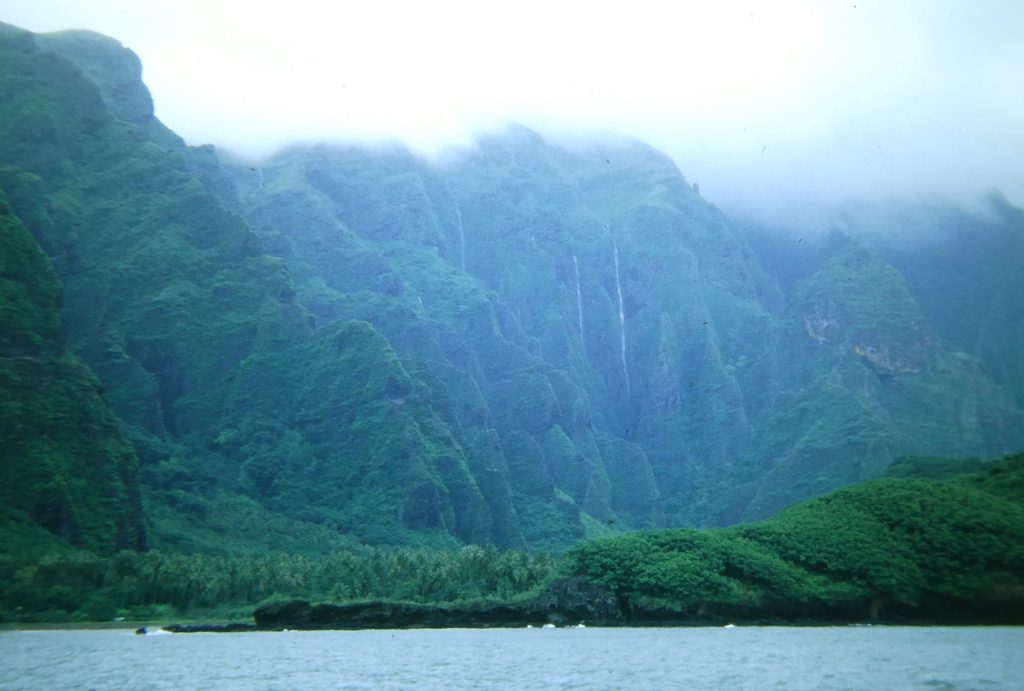 We retrieved both anchors with great difficulty and motored out of the bay into a 25-knot easterly and steep two to three-metre seas. We tracked down the rugged coast to the west and through a slot round a green promontory - which was very hard to see - into the relatively small and well protected Anse d’Hakatea, or “Daniel’s Bay”. It was named after the friendly Polynesian who, with his family, were the only people living there. There was some reflected swell in the bay, but it did seem a great deal calmer! We were soon joined by Pacific Jade, and we had evening drinks with Jim and Sally.
We retrieved both anchors with great difficulty and motored out of the bay into a 25-knot easterly and steep two to three-metre seas. We tracked down the rugged coast to the west and through a slot round a green promontory - which was very hard to see - into the relatively small and well protected Anse d’Hakatea, or “Daniel’s Bay”. It was named after the friendly Polynesian who, with his family, were the only people living there. There was some reflected swell in the bay, but it did seem a great deal calmer! We were soon joined by Pacific Jade, and we had evening drinks with Jim and Sally.
The surrounding scene was truly spectacular. The hills looked vertically steep, with crests of green growth, jagged buttresses with black rocky recesses, most of them channelling the silvery streak of a precipitous waterfall.
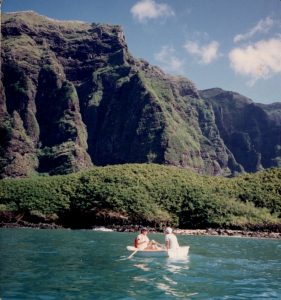 With our Canadian friends we rowed (very low on outboard fuel) to a creek at the head of the bay. There was a bit of a surf on the sand, and we received our dunking for the day. But we were to get a lot wetter!
With our Canadian friends we rowed (very low on outboard fuel) to a creek at the head of the bay. There was a bit of a surf on the sand, and we received our dunking for the day. But we were to get a lot wetter!
We started on an ancient stone path through a pretty coconut grove and to the start of a trail that would take us up the river valley, hopefully to the base of a high waterfall. This Marquesan “highway” was 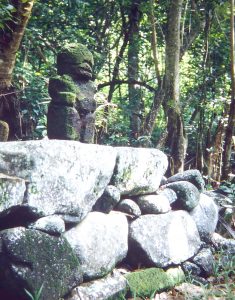 lined each side with rocks. We passed several paepaes and a way up the valley came across a few tikis, stone temples. We walked through grand, overpowering canyon scenery, with jagged crests and spurs, dense green vegetation including mango trees, guavas, lemons, coconuts and breadfruit. Both Norma and Sally went into full collecting mode. We came to the view across the valley to the top part of the tremendous waterfall, streaming over the top of a mountain crest from a plateau behind, encased by cloud from time to time.
lined each side with rocks. We passed several paepaes and a way up the valley came across a few tikis, stone temples. We walked through grand, overpowering canyon scenery, with jagged crests and spurs, dense green vegetation including mango trees, guavas, lemons, coconuts and breadfruit. Both Norma and Sally went into full collecting mode. We came to the view across the valley to the top part of the tremendous waterfall, streaming over the top of a mountain crest from a plateau behind, encased by cloud from time to time.
We knew that in theory it was possible to reach the base of the waterfall, but the trail disappeared and it became very wet, muddy (from pigs digging) and jungly. We waded through several streams but eventually gave up and returned to the head of the bay 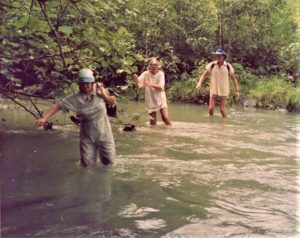 just over
just over 
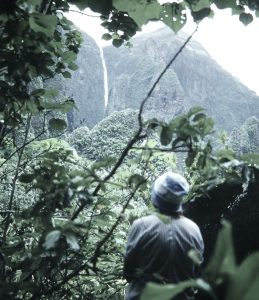 five hours out. We were stiff and tired as we rowed back to the boat. Sally and Jim joined us for rum and coconut water for aperitifs. Our dinner was chicken and breadfruit, bananas and coconut cream, very Pacific!
five hours out. We were stiff and tired as we rowed back to the boat. Sally and Jim joined us for rum and coconut water for aperitifs. Our dinner was chicken and breadfruit, bananas and coconut cream, very Pacific!
The next few days were peaceful and quiet, with some routine maintenance and making the most of a pipe bringing fresh water from the stream to a buoy in the bay. Both the top and bottom of the boat were subjected to thorough cleaning, the results looking good.
The Marquesas had been spectacular and interesting, but we had been unlucky with the weather – it was the late wet season – and we had not enjoyed the swell-prone anchorages. The exception was Daniel’s Bay, which was a very good anchorage that we shared with good company. However, on May 22 we left the bay for the 490-mile passage to the Tuamotu islands.
The Tuamotu archipelago
The 69 coral atolls (41 inhabited) of the Tuamotus cover a vast expanse of the Pacific Ocean, an area of some 1,200 km by 600 km. They are known informally as the “Dangerous Archipelago”, because of their wide scattering, variable currents and poor charts. The low-lying atolls are also very hard to see, even in good conditions, and impossible at night. Most yachts avoid the group because of their dangers. When celestial observations become difficult or impossible, position-fixing is vague and the risk of striking an invisible reef very high. However, we were confident that our basic US Navy Navigation Satellite System (NAVSAT), which had served us so well over the previous five years, would see us through safely. A few other yachts were making use of radar.
Not another hazard for us, we hoped, was the fact that in 1963 President Charles de Gaulle had decided to use the southern-most Moruroa and Fangataufa atolls for nuclear testing. Tests were continuing at the rate of 7 to 10 a year. Testing had been underground since 1974, with huge damage to the atolls. Access to the southern areas was forbidden. The whole matter was remaining highly controversial in the whole of French Polynesia, but wide discussion was frowned upon and most tourists were unaware of it. We had become conscious of the issue when we were in Auckland Harbour in 1981. A Greenpeace protest ship was sunk by the French very close to where we had been berthed.
 The passage the the Tuamotus started well, a beam or broad reach in 10-15 knot winds, a little lighter at night but reverting to good trade strength during the day. On the third day out, after losing a few, we caught and landed a hefty yellow-fin tuna. It was a gift for Norma’s birthday the following day. The clear horizon granted us another gift, a good green flash at sunset.
The passage the the Tuamotus started well, a beam or broad reach in 10-15 knot winds, a little lighter at night but reverting to good trade strength during the day. On the third day out, after losing a few, we caught and landed a hefty yellow-fin tuna. It was a gift for Norma’s birthday the following day. The clear horizon granted us another gift, a good green flash at sunset.
Then, at dawn of the day of arrival I was lucky enough to observe an incredibly rare phenomenon, a morning green flash. To see a sunset green flash we often watched carefully during the minutes and seconds as the sun set, keeping eyes fixed on the correct place the instant its rim dropped over the horizon. To catch and see a morning flash is harder because you have to be looking at exactly the right place at the right time, as I did as I climbed up into the cockpit for my morning’s first daylight look around. I felt very privileged to see this but some sceptics believe there is no such thing!
Later in the morning of the fourth day, after slowing down to avoid arriving in the night, we made landfall at Manihi Island, in a sub-group of the Tuamotus known as the King George islands. We continued sailing down the north-west side of the large atoll and in the early afternoon motored in through the pass in its south-west side. The first part of the pass was easy against the outgoing stream, but I went up the mast for the second part, rather narrower and much shallower, as we knew from the Admiralty’s Pacific Islands Pilot. It was not easy to read the depths, and the outgoing flow was ripping out at about five knots, which made for slow and anxious going.
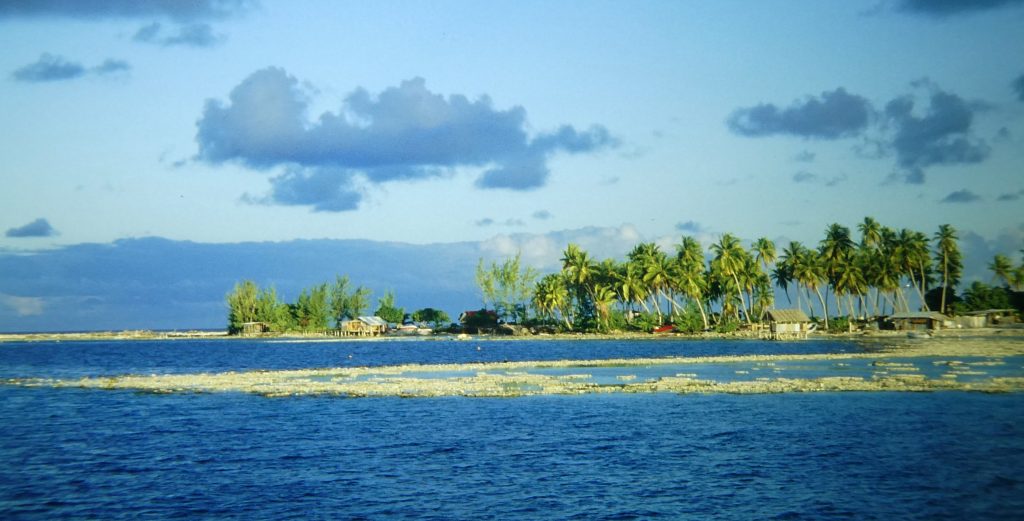 With some relief we anchored in deep water in a bight near the village just inside. We had covered 490 nautical miles in four days and six hours at an average speed of 115 miles a day – not the fastest passage, but a very pleasant one. It was hot, and we were straight in for a swim.
With some relief we anchored in deep water in a bight near the village just inside. We had covered 490 nautical miles in four days and six hours at an average speed of 115 miles a day – not the fastest passage, but a very pleasant one. It was hot, and we were straight in for a swim.
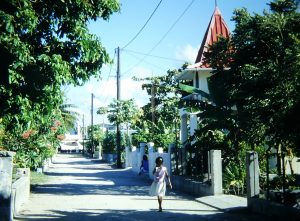
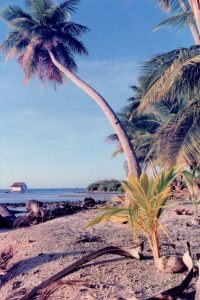 We took the dinghy over some inner reefs the next morning and walked to the village. We had heard Polynesian music from the village meeting house as we approached, and it turned out that the district administrator was being welcomed, having arrived on a small trading ship berthed at the town dock. In his honour the local ladies had laid out ceremonial displays of shells and flowers at one of the churches. The village itself was showing signs of some unrepaired damage from a cyclone in 1983, a few years previously, but the two small shops had ample provisions and quite impressive new dwellings were being built in an adjoining “suburb” with the help of French finance, no doubt.
We took the dinghy over some inner reefs the next morning and walked to the village. We had heard Polynesian music from the village meeting house as we approached, and it turned out that the district administrator was being welcomed, having arrived on a small trading ship berthed at the town dock. In his honour the local ladies had laid out ceremonial displays of shells and flowers at one of the churches. The village itself was showing signs of some unrepaired damage from a cyclone in 1983, a few years previously, but the two small shops had ample provisions and quite impressive new dwellings were being built in an adjoining “suburb” with the help of French finance, no doubt.
The anchorage was rather uneasy, becoming choppy at times when the trades perked up. The anchor chain was being sagged on coral heads and assorted rubbish on the sea bed, including framework for the now disused pearl farms. We moved to the inner side of a motu on the eastern side  of the atoll, which gave more protection and the water was less choppy. Norma took a walk on the motu, but there was nothing there of any great interest except for a small reef shark that gave her a bit of a fright.
of the atoll, which gave more protection and the water was less choppy. Norma took a walk on the motu, but there was nothing there of any great interest except for a small reef shark that gave her a bit of a fright.
It was another disturbed night, but good-looking skies in the morning. Having disentangled the anchor chain from the coral we went our way out of the pass against the incoming tidal stream, so there were overfalls at the inner end over the coral bar. It was a relief when we emerged and set sail for the nearby island of Ahe, a slightly smaller atoll to the west.
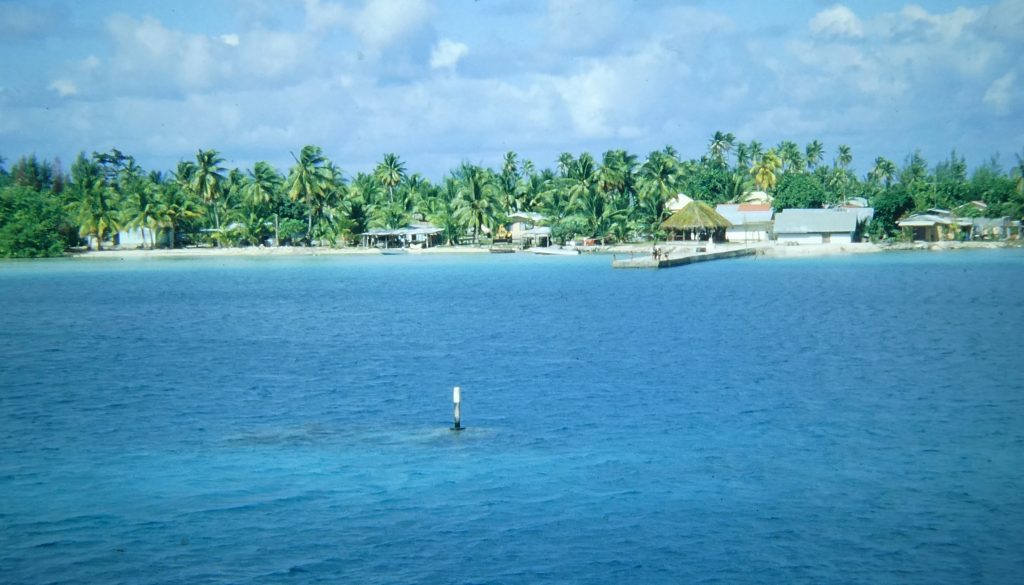 It was a pleasant morning’s sail, but we were a bit anxious about the pass into the Ahe lagoon. It had a bad reputation, and it was hard to see from outside. It was choppy going in, but the tidal stream going out was not that strong. The best route was easy to see, with a blue bottom over sand and a minimum depth of 22 feet. It was a much less nerve-wracking experience than entering Manihi, contrary to our concerns.
It was a pleasant morning’s sail, but we were a bit anxious about the pass into the Ahe lagoon. It had a bad reputation, and it was hard to see from outside. It was choppy going in, but the tidal stream going out was not that strong. The best route was easy to see, with a blue bottom over sand and a minimum depth of 22 feet. It was a much less nerve-wracking experience than entering Manihi, contrary to our concerns.
The pass is on the western side of the atoll, and we then sailed down and across the lagoon to the Ahe settlement. This, in turn, is protected by a coral reef with a channel through, making a small and well protected mini-lagoon. It was a lovely approach, with the village surrounded by trees, the houses roofed by red tiles and palm fronds. A small concrete wharf came out from the town, and myriad small boys were doing what all small boys do in the islands, jump into the water, climb out again, and so on . . and on!
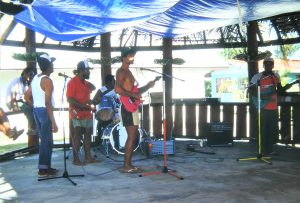 Again we heard music, “just practising”, we were told, attended by families, kids and dogs. That evening they would be playing for a Mothers’ Day party at the church.
Again we heard music, “just practising”, we were told, attended by families, kids and dogs. That evening they would be playing for a Mothers’ Day party at the church.
 The pretty village had been completely restored since the 1983 cyclone, which had totally covered the little island with water to a reputed depth of two feet. It was a pleasure to explore the friendly village, its island and the small coral islets (motus) around it – all part of the string of little islands which, with the coral reef, enclosed the huge main lagoon.
The pretty village had been completely restored since the 1983 cyclone, which had totally covered the little island with water to a reputed depth of two feet. It was a pleasure to explore the friendly village, its island and the small coral islets (motus) around it – all part of the string of little islands which, with the coral reef, enclosed the huge main lagoon.
The anchorage was well protected, and we were the only boat except for the weekly evening supply ship from Papeete, which was only there for a few hours. It was met by scores of islanders running back and forth in outboard-powered plywood runabouts. We were more relaxed there than we had been at any time since the San Blas islands in Panama!
On one of the adjacent motus we found a hut built by yachties on the site of the sojourn there by Bernard Moitessier. In 1968 Moitessier had famously entered the world’s first single-handed round the world race in his 39 ft steel ketch Joshua. The course 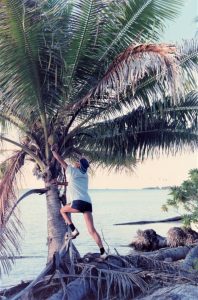 took him, as planned, round the Cape of Good Hope, south of Tasmania and round Cape Horn. He had only to sail back up to Plymouth to (possibly) win the Golden Globe award for the fastest passage. However, he continued sailing east and resigned from the race. He sent a message to his London Times correspondent by firing a message by slingshot onto the deck of a passing ship, stating: "parce que je suis heureux en mer et peut-être pour sauver mon âme" ("because I am happy at sea and perhaps to save my soul"). He passed south of Australia again, turned up into the Pacific and finally came to rest in Tahiti, which he knew well. It took him two years to finish the book about his trip to Tahiti, during which time he met Ileana Draghici with whom he had a son, Stephan. They moved here to the atoll of Ahe, where he attempted to cultivate fruit and vegetables. Years later he wrecked Joshua on the beach at Cabo San Lucas, an episode in Mexico we wrote about earlier in this account of our voyaging. (See the page The Pacific Northwest to Panama.)
took him, as planned, round the Cape of Good Hope, south of Tasmania and round Cape Horn. He had only to sail back up to Plymouth to (possibly) win the Golden Globe award for the fastest passage. However, he continued sailing east and resigned from the race. He sent a message to his London Times correspondent by firing a message by slingshot onto the deck of a passing ship, stating: "parce que je suis heureux en mer et peut-être pour sauver mon âme" ("because I am happy at sea and perhaps to save my soul"). He passed south of Australia again, turned up into the Pacific and finally came to rest in Tahiti, which he knew well. It took him two years to finish the book about his trip to Tahiti, during which time he met Ileana Draghici with whom he had a son, Stephan. They moved here to the atoll of Ahe, where he attempted to cultivate fruit and vegetables. Years later he wrecked Joshua on the beach at Cabo San Lucas, an episode in Mexico we wrote about earlier in this account of our voyaging. (See the page The Pacific Northwest to Panama.)
We did some general maintenance and Norma went into hunter-gatherer mode by collecting clams from the wide expanse of reef, very tasty for dinner. I pulled some coconuts down for the evening aperitif, rum and coconut water.
This was a great and restful stop in a lovely lagoon, the only yacht there, well protected from wind and swell. But at this stage in our Pacific crossing we had to keep going, so after three peaceful nights we set sail south-west for Papeete, Tahiti.
There was little tidal stream in the pass out to sea, and plenty of depth, so it was an easy start to the predicted two-day passage. It was good sailing all day in moderate trade winds, our only obstacle being a line of low atolls: the Palliser group along the fringe of the Tuamotus. During the night we aimed to pass between the atolls of Rangiroa and Arutua, about ten nautical miles  apart. Unfortunately, in the late afternoon the orbiting US Navy satellites deserted us, and so I reverted to celestial navigation and took a four-star fix at dusk (Sirius, Rigil Kent, Canopus and Arcturus). To our relief that established that we were right in the middle of the channel and safely passing through.
apart. Unfortunately, in the late afternoon the orbiting US Navy satellites deserted us, and so I reverted to celestial navigation and took a four-star fix at dusk (Sirius, Rigil Kent, Canopus and Arcturus). To our relief that established that we were right in the middle of the channel and safely passing through.
It got squally under black clouds as we sailed down towards Tahiti, and on the second night we took star sights again because the satellites were still not cooperating. They were back by the time we neared the island on the second morning, but by that time we could see its peak anyway. After what was an awkward and busy passage of 269 miles in 50 hours it was an easy final approach into Papeete harbour, through a placid pass between big markers at the end of the breakwater and the edge of the reef the other side.
Tahiti
We had a look at the wharf by the yacht club, where several yachts were tied, but then moved away a short distance and joined a few other yachts anchored stern-to the shore. We anchored off the Protestant church so often seen in photographs of the waterfront, and took a line ashore to tie it to the roots of a tree the other side of a steep black sand beach.
 We were quickly ashore to sort things out. Papeete town was very busy, with traffic of a density we hadn’t seen for a long time. Many buildings were new, and the general standard of living appeared very high. We picked up a large pile of mail from the friendly Amex agent and bought some good French food. We had our evening meal at “the trucks”, a motley collection of converted vans serving all kinds of food cooked on roaring wood fires in brick lined ovens.
We were quickly ashore to sort things out. Papeete town was very busy, with traffic of a density we hadn’t seen for a long time. Many buildings were new, and the general standard of living appeared very high. We picked up a large pile of mail from the friendly Amex agent and bought some good French food. We had our evening meal at “the trucks”, a motley collection of converted vans serving all kinds of food cooked on roaring wood fires in brick lined ovens.
It continued to be a busy few days. We looked around some shops for provisioning, and established there was a good supermarket nearby. Food prices were OK, but anything alcoholic ferociously expensive. The road directly behind us was very busy and hard to cross.
We called in at a cultural event in a park, three burly Tahitians in pareaus and flowery head-dresses racing to extract copra from coconuts. We had to deposit our bond and pay a small fee for tying to the shore.
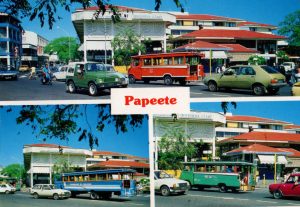
 We took in a concert, the first for a long time. It was at the church of St Trinity in an adjacent suburb that would have been a long walk except that we were offered a lift by a Frenchman going to the concert who had stopped to ask directions from a local. It was a great little concert, with music by a local music conservatorium. The first half of the program was a good mix of baroque instrumental and choral, and the latter part the Vivaldi Gloria. The same helpful man drove us back.
We took in a concert, the first for a long time. It was at the church of St Trinity in an adjacent suburb that would have been a long walk except that we were offered a lift by a Frenchman going to the concert who had stopped to ask directions from a local. It was a great little concert, with music by a local music conservatorium. The first half of the program was a good mix of baroque instrumental and choral, and the latter part the Vivaldi Gloria. The same helpful man drove us back.
Our good friends Robert and Annie in Annika finally arrived to our relief, because we were carrying a pile of mail for them from the Galapagos. With them we rented a car for a drive anticlockwise round the island. We checked out a few nearby anchorages and a fuel dock, then visited the Musee de Tahiti et des Isles. This was very good and well laid out, with interesting reconstructions and displays of Polynesian life. Also interesting was the partly restored 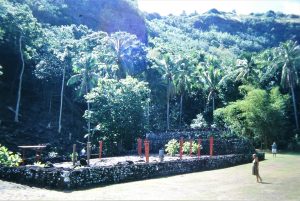
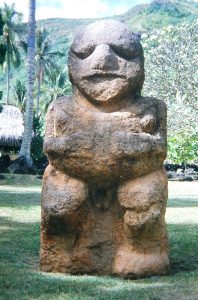 Marae Arahurahu, in a lovely setting, with green cliffs all around, thick with trees. This was a good example of an ancient Polynesian temple and meeting place. The foundations were made of black basalt, similar to what we had seen in the Marquesas. Everywhere, the roadsides were lined by a mass of well-tended and colourful bushes and flowering shrubs. Looking inland from the coastal road we could see green, steep-sided river valleys extending up into the hills.
Marae Arahurahu, in a lovely setting, with green cliffs all around, thick with trees. This was a good example of an ancient Polynesian temple and meeting place. The foundations were made of black basalt, similar to what we had seen in the Marquesas. Everywhere, the roadsides were lined by a mass of well-tended and colourful bushes and flowering shrubs. Looking inland from the coastal road we could see green, steep-sided river valleys extending up into the hills.
A good stop was at the Botanical Gardens and the Gauguin museum, directly the opposite side of the main island to Papeete. The setting was pleasant, but this is on the windward and wet side of the island so that it was raining by then, as appropriate. The museum was basically a detailed account 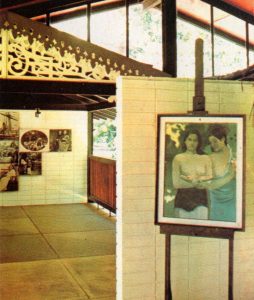 of Gauguin’s generally miserable life while he searched for paradise unspoiled. His paintings of Tahitians do rather feature the heavy features of some Polynesian wahines.
of Gauguin’s generally miserable life while he searched for paradise unspoiled. His paintings of Tahitians do rather feature the heavy features of some Polynesian wahines.
Near the museum is the narrow neck of land connection the main island to its smaller offshoot, Tahiti-Iti. We drove the road along the southern side of the offshoot until it ran out. There was a surprising amount of modern development along the way. Back on the 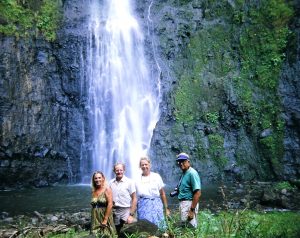 big island we continued up the windward eastern side, where heavy surf was breaking on the fringing reefs and we could see no reasonable anchorages. Half way up we took a nice walk up one of the river valleys to a waterfall running from a deep cleft in the mountainside into a shady pool. The environment was popular with biting insects!
big island we continued up the windward eastern side, where heavy surf was breaking on the fringing reefs and we could see no reasonable anchorages. Half way up we took a nice walk up one of the river valleys to a waterfall running from a deep cleft in the mountainside into a shady pool. The environment was popular with biting insects!
Right at the island’s northern tip we took a look at Cook’s anchorage, Point Venus. This is only partly protected by a curving peninsula and a reef well offshore, but at least it would have been easier for a sailing ship to enter and leave than for most of the better protected anchorages along the coast.
Using the car the next morning we drove around to find anywhere that could fix Annika’s failing refrigeration system – shades of other times that well-equipped American boats had the same problems! We found a man at the “Service Commercial” at the French Navy base in the harbour, who came out straight away.
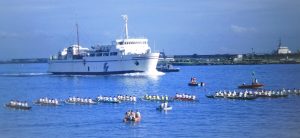 We then cleared out with Customs with great ease, getting a formal clearance certificate for all the French islands. The only constraint was that we could only get our bond money back in Bora Bora, which seemed reasonable. So then, of course, more washing and provisioning. We got away the next morning after watching a large collection of native pirogues assembling in preparation for a big race to Moorea and back, and stayed to watch the start.
We then cleared out with Customs with great ease, getting a formal clearance certificate for all the French islands. The only constraint was that we could only get our bond money back in Bora Bora, which seemed reasonable. So then, of course, more washing and provisioning. We got away the next morning after watching a large collection of native pirogues assembling in preparation for a big race to Moorea and back, and stayed to watch the start.
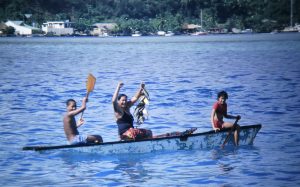 We motored gently away from our beach and turned west, entering the channel between the mainland and the fringing reef. Passing the airport and rounding the north-west corner of the island, we turned down the west (lee) coast and came to anchor by the inner side of the reef. It was quite calm there, apart from wakes from the boats travelling up and down the channel. We dived to do some underwater cleaning, and took the dinghy over to the mainland to fill some jerries with fuel as the water by the fuel dock was too shallow to take the boat alongside.
We motored gently away from our beach and turned west, entering the channel between the mainland and the fringing reef. Passing the airport and rounding the north-west corner of the island, we turned down the west (lee) coast and came to anchor by the inner side of the reef. It was quite calm there, apart from wakes from the boats travelling up and down the channel. We dived to do some underwater cleaning, and took the dinghy over to the mainland to fill some jerries with fuel as the water by the fuel dock was too shallow to take the boat alongside.
It was quieter after the weekend, and we took a walk ashore around the very prosperous-looking suburbs and the impressive houses. Roads were climbing up into each of the clefts in the mountains, and once past the houses we had a good view of the anchorage with Moorea in the background. Norma did some foraging and filled a bag with passion-fruit and pawpaws.
As we had discussed with other thoughtful yachties, our impression was that the French Government was pouring money into the islands to smother any discontent on the nuclear testing matter – stuffing their mouth with gold, some claimed. But one effect of the high prices was that tourism was being badly hit, with the number of visitors way down, as the big tour operators could place people in a similar ambiance far more cheaply in places like Fiji, or even Australia and New Zealand. There were very few French cruising boats in the area; they are famed for their ability to sniff out the bargains, and here there weren’t any. The poorer of the local people were simply not buying much, because subsistence cultivation was so easy that there was always plenty to eat, services such as roads and schools were free, and devices such as solar generating panels were highly subsidised.
By the next morning the persistent showers had stopped. We left Tahiti island through Teapuna Pass in the reef with no problems, ensured by conning from aloft, and motored across the 12 nautical miles or so to the north-east corner of Moorea and along to the entrance to Cook’s Bay.
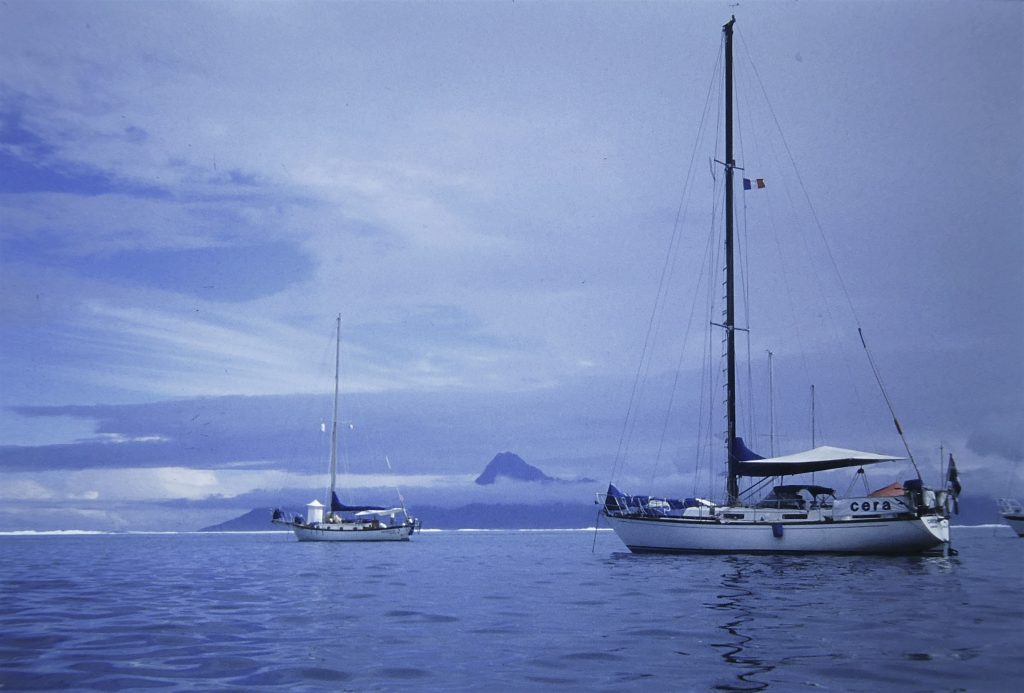
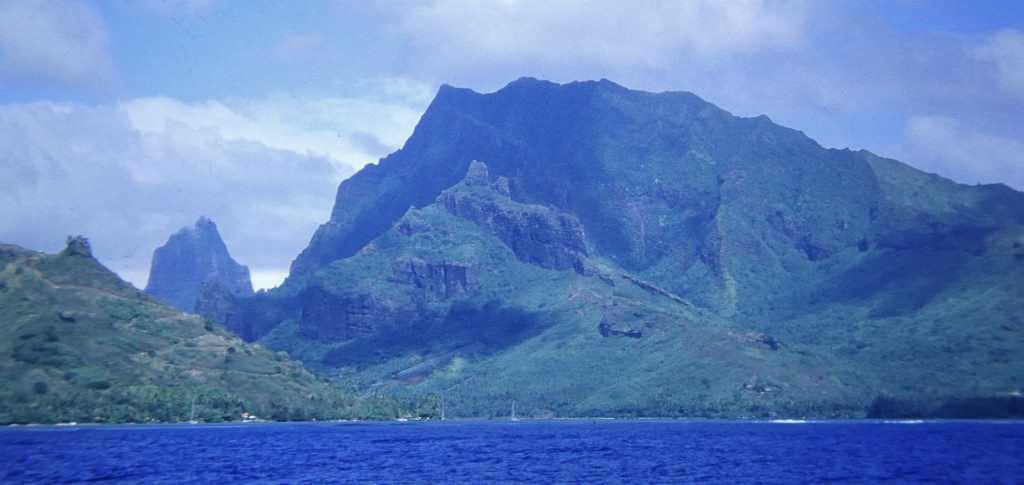 Moorea was green, flecked with shadows from the passing clouds over the pinnacles. The wind was gusting out of Cook’s Bay on our approach, with the island looking beautiful and dramatic. We anchored just outside Cook’s Bay in a passage between the barrier reef and the land just to the east of the entrance.
Moorea was green, flecked with shadows from the passing clouds over the pinnacles. The wind was gusting out of Cook’s Bay on our approach, with the island looking beautiful and dramatic. We anchored just outside Cook’s Bay in a passage between the barrier reef and the land just to the east of the entrance.
The wind stayed gusty and strong for the rest of the day and overnight. We took a walk ashore and down the eastern side of the bay. A typically shambolic Chinese store advertised itself as “Supermarket Moorea”, but we found a better shop a little further down near the Bali Hai club. All the roads were lined with colourful bushes and well-trimmed grass.
We made a most interesting call into the gallery and shop of the well-known local artist Aad van der Hyde. He had a splendid display of his  and others’ work laid out on the grass, and many Pacific artefacts. We had a good chat with him, covering subjects such as writing, critics, and reincarnation. He was at the time writing an incredibly complicated screenplay, on spec.
and others’ work laid out on the grass, and many Pacific artefacts. We had a good chat with him, covering subjects such as writing, critics, and reincarnation. He was at the time writing an incredibly complicated screenplay, on spec.
The wind was finally easing by the time we were back aboard in the late afternoon, and it got cooler as the passing front moved away. In the morning Norma had a row around over the reef, and then we motored gently round the eastern headland and down into Cook’s Bay, surely a highly evocative event for any voyaging sailor. We went right down to the southern head of the bay and anchored off the west side off a church near the village of Paopao. We went ashore to the village, where there were quite a few new buildings, including a school and market.
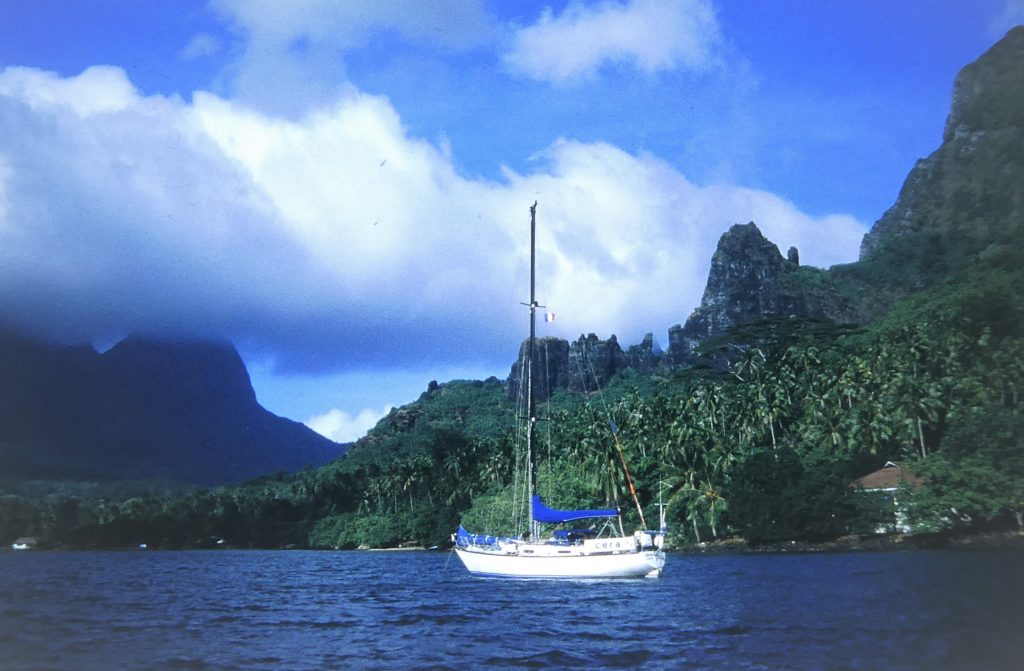
Back aboard we saw flowers dropping from the multitude of bushes and trees around us, with some flowers dropping in the dinghy and others then drifting solemnly past us. We looked up at black basalt spires thrusting through carpets of green growth, piercing the clouds high above.
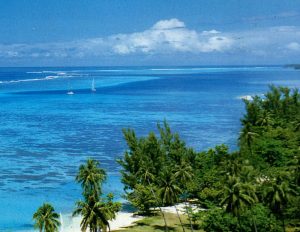 It was another windy and disturbed night – paradise is not always paradisical- but calmer by morning. We took a short walk to the east side of the bay to a supermarket for provisions, and then motored out of Cook’s Bay and round to the other bay immediately to the east, Opunohu Bay. Again, we first anchored between the reef and the land outside the bay, with the famous “shark’s tooth crest clearly visible. There was only a small handful of yachts around, similar to Cook’s.
It was another windy and disturbed night – paradise is not always paradisical- but calmer by morning. We took a short walk to the east side of the bay to a supermarket for provisions, and then motored out of Cook’s Bay and round to the other bay immediately to the east, Opunohu Bay. Again, we first anchored between the reef and the land outside the bay, with the famous “shark’s tooth crest clearly visible. There was only a small handful of yachts around, similar to Cook’s.
The evening was beautifully calm, and we had a splendid dinner of rump steak and potatoes; “like a real meal”, commented Norma. The following day we started to get stuck in to rubbing down the teak deck trim and re-varnishing, quite a big job, but in gorgeous surroundings in a good anchorage.
After a couple of nights there we moved across the outer end of Opunohu Bay and across to another pass between the reef and the island. We motored past Papetoai village, where the water was deep, and then edged carefully through a very shallow channel between an inner reef and the land. This took us into a small inner lagoon with anchorable depth, by ourselves in what we then called “our” anchorage. Ashore, there were just a few native shacks and lots of palm trees. Further along to the west was a very quiet bungalow hotel. Norma went ashore and beat some locals to some mangoes just going on sale.
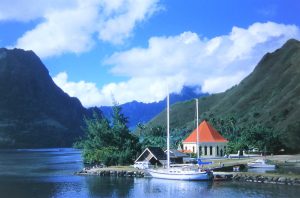 During the day a little dugout convoy came past, obviously after a church wedding. The happy couple’s seat was backed by a high and wide fan of palm fronds, the bride in a white wedding dress and groom in a neat suit. Both were crowned with flowers. A touching sight. The wind died with the sunset.
During the day a little dugout convoy came past, obviously after a church wedding. The happy couple’s seat was backed by a high and wide fan of palm fronds, the bride in a white wedding dress and groom in a neat suit. Both were crowned with flowers. A touching sight. The wind died with the sunset.
In the morning we went ashore to Papetoai village. There was a new toilet block on the wharf, along with a tap from which we filled buckets of water for Norma’s planned washing. There were two small stores, one of them acceptable. The attractive little octagonal Protestant church at Papetoai was built on the site of a temple (there are others) of the war god Oro in 1822. After a chat with a pleasant Auckland family in a yacht tied to the wharf we returned to our boat for more work on the varnishing.
The next day was the shortest day, mid “winter”. We motored out of “our” basin, back past the village and then down the length of Opunohu Bay, anchoring in the south-west corner. The famous shark’s tooth was up the valley, and there were several other high peaks and a high escarpment to admire. We did some socialising on the Kiwi boat and were joined by an American-Australian couple.
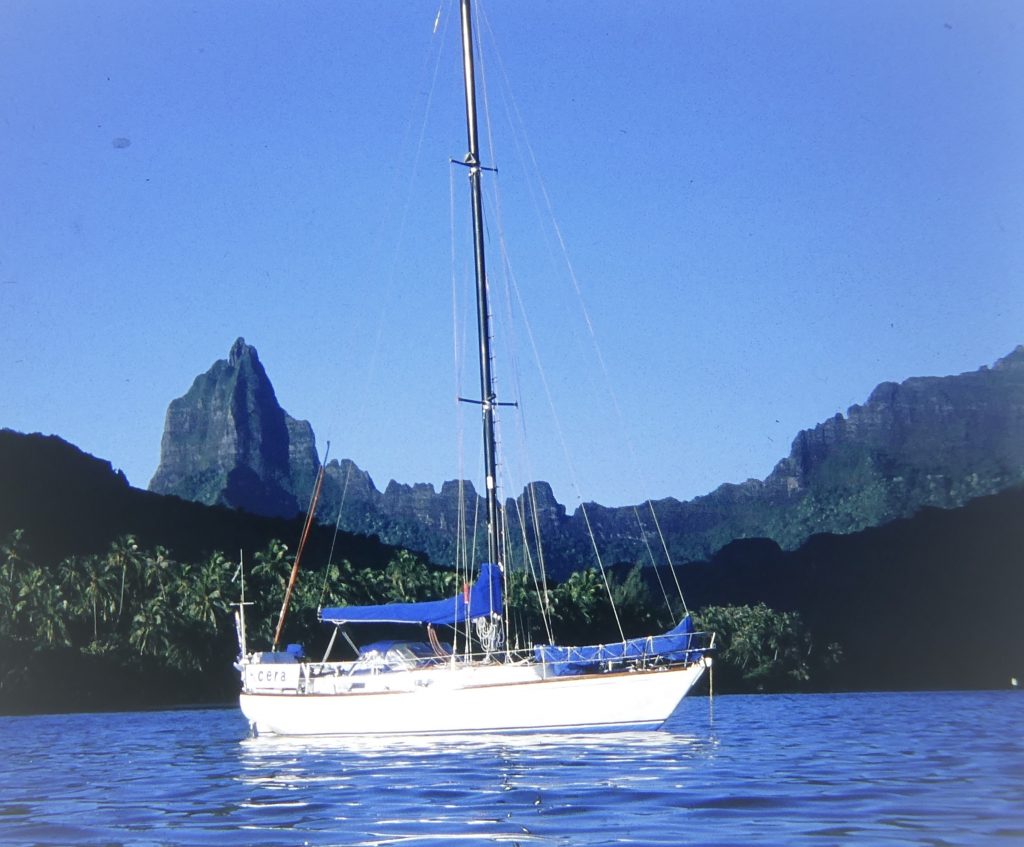
We were ashore early the next morning in relatively cool (74 degrees F) conditions, and started a walk up the valley at the head of the bay. We saw experimental farming areas and shrimp farms, and passed yet more beautiful flowering shrubs and trees with coloured leaves and some old maraes with archery platforms.
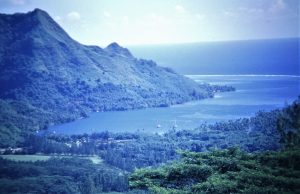 We were picked up by a chatty American, Todd Mills, who gave us a lift right up to the Belvedere Lookout, at the head of the river valley and just at the base of the escarpment. The escarpment is actually the northern wall of a dormant volcano crater. From here there was a staggering view down the valley and over to both of the twin bays, Cooks and Oponomu.
We were picked up by a chatty American, Todd Mills, who gave us a lift right up to the Belvedere Lookout, at the head of the river valley and just at the base of the escarpment. The escarpment is actually the northern wall of a dormant volcano crater. From here there was a staggering view down the valley and over to both of the twin bays, Cooks and Oponomu.
He took us back down again, and then swam across to us for lunch. In the evening he picked us up and took us to dinner at the Tianora restaurant for poisson cru and fish salad, followed by steaks. It was all very kind of him and his friend Gene, also from California. It turned out they were jointly negotiating to buy the place.
In the morning Norma rowed ashore to Arafura (“pig’s”) Bay, a quiet and pleasant corner of the world, complete with pig and a convenient water supply, and walked up to the village for bread.
Leaving late in the day, in accord with the timing for the next leg, we were off for an overnight sail of some 77-miles to the island of Huahine. It turned out to be a windless night, so we had to motor half the way. In the early hours of the morning Norma hooked and landed a four-foot mahi-mahi (aka dorado), a splendid fish. Its sad but particularly spectacular colour change was unusual in our experience with these fish, in this case ending in shining silver with blue spots.
Huahine
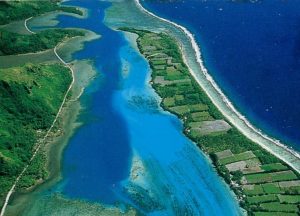 We went through the Passe Farerea between the east sides of the twin islands of Huahine-Iti island to the south and Huahini-Nui to the north. We rounded a little motu and motored down a channel between the long Motu Muri Mahora and the main island. We anchored in the far end of the channel before lunchtime. There were fish traps at the corners of the motu, and many waterfront huts along the motu shore. A road wound along the waterfront of the main island. We were the only cruising yacht.
We went through the Passe Farerea between the east sides of the twin islands of Huahine-Iti island to the south and Huahini-Nui to the north. We rounded a little motu and motored down a channel between the long Motu Muri Mahora and the main island. We anchored in the far end of the channel before lunchtime. There were fish traps at the corners of the motu, and many waterfront huts along the motu shore. A road wound along the waterfront of the main island. We were the only cruising yacht.
After lunch and a siesta Charlie, a big local fellow paddled over in an out-rigger with a huge bunch of small, tasty bananas. He had plenty, he said, and settled in for a while for a chat. He didn’t want money, so we gave him a jar of coffee. The evening meal was breadcrumbed mahi-mahi. It had been hot, but the weatherfax map was showing the approach of a substantial front.
Sure enough, it was solid overcast with heavy rain first thing, so Norma of course got up and filled the water tanks with rainwater. She then rowed up to the end of the long motu and walked to the outer reef and a narrow beach while I caught up with some of the never-ending correspondence with the aid of our little Toshiba and dot printer, which was still working, rather to our surprise.
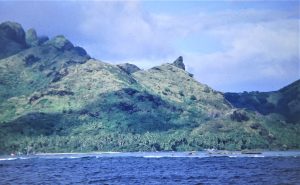 The weather stayed poor for the next few days, and we were very pleased that we had made the short passage over to Huahine when we did. During breaks from the wind and rain we walked ashore both on the main island and along the motu. On the main island the only actively managed plantations were for cantaloupe melons, which were being loaded onto boats for shipment out. The whole of the motu was also a plantation managed by a few local people living in huts along the shore; the main products here seemed to be bananas and coconuts.
The weather stayed poor for the next few days, and we were very pleased that we had made the short passage over to Huahine when we did. During breaks from the wind and rain we walked ashore both on the main island and along the motu. On the main island the only actively managed plantations were for cantaloupe melons, which were being loaded onto boats for shipment out. The whole of the motu was also a plantation managed by a few local people living in huts along the shore; the main products here seemed to be bananas and coconuts.
In clearing and windless but still cloudy weather we left our peaceful anchorage and motored back out of the pass and then up and around the northern headlands of Huahine-Nui, the larger of the twin and nearly adjoined main islands. We continued down its western side to the Passe Avamoa and the harbour of Fare town.
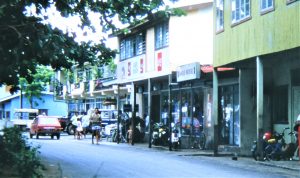 We anchored on the inner side of the barrier reef between the two passes into the harbour. We were quickly ashore before everything shut for the long lunch break. There were plenty of shambolic Chinese-style stores, but otherwise the quite attractive town was simply a single line of shops along the waterfront. It had a “wild west” sort of look to it. There was a commercial dock where a few yachts were tied, with crews doing the stocking up.
We anchored on the inner side of the barrier reef between the two passes into the harbour. We were quickly ashore before everything shut for the long lunch break. There were plenty of shambolic Chinese-style stores, but otherwise the quite attractive town was simply a single line of shops along the waterfront. It had a “wild west” sort of look to it. There was a commercial dock where a few yachts were tied, with crews doing the stocking up.
Clouds were still settling over the mountains and were ranging over to Raiatea; it was clearly visible, as was Bora Bora. Heavy rain and squalls settled in again. We had to go ashore for more extensive shopping and then left to move down the channel between the barrier reef and the land. We anchored in the big open Avea Bay on the northern shore of the island of Huahine Iti, the smaller of the twins, separated by a channel too shallow for us and connected to each other by a bridge. The bay was better protected from the prevailing easterly wind than would appear from the chart and the waters were flat because of the wide 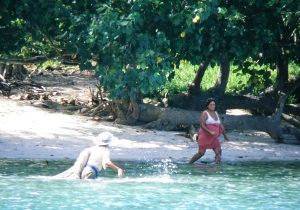 barrier reef outside it. The weather didn’t change much, and the weatherfax confirmed the presence of a stationary trough just to the east of us. We got stuck into some boat work, writing, swimming and cleaning the underwater hull. There were just five yachts there, most with which we were already friends, so socialising was a constant pleasure.
barrier reef outside it. The weather didn’t change much, and the weatherfax confirmed the presence of a stationary trough just to the east of us. We got stuck into some boat work, writing, swimming and cleaning the underwater hull. There were just five yachts there, most with which we were already friends, so socialising was a constant pleasure.
We got the bikes out and took them ashore for a ride round the southern part of Huahine-Iti and round to nearly where we had originally been anchored. We passed a few small thatch-roofed resorts, all looking deserted, some tiny private settlements and isolated cottages. A few local women were fishing from the beach, chasing fish into lightweight nets.
 Copra was being dried on racks under sheets of corrugated iron; the smell was powerful, the coconut meat browning and covered by a fungus-looking growth. Norma picked up some good shells from the beaches. The countryside was as verdant as usual.
Copra was being dried on racks under sheets of corrugated iron; the smell was powerful, the coconut meat browning and covered by a fungus-looking growth. Norma picked up some good shells from the beaches. The countryside was as verdant as usual.
Around Huahine there are numerous maraes, ceremonial and sacred places, most with stone platforms. The most numerous of the collections is over the north of the island, but during our cycle ride we visited one of the best-known maraes in the south, Marae Anini. It was dedicated to the war god Oro and alleged to be one that had been used for human sacrifices.
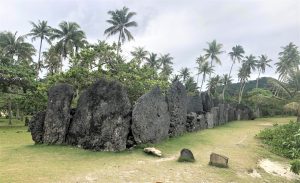 In improving conditions we took a dinghy trip up to the village of Haapu, reportedly the most “traditional” village and, as such, much studied by anthropologists. All we saw was a village similar to others, but it did have a simple store where we bought some basics.
In improving conditions we took a dinghy trip up to the village of Haapu, reportedly the most “traditional” village and, as such, much studied by anthropologists. All we saw was a village similar to others, but it did have a simple store where we bought some basics.
For lunch, we all went ashore for a beach party for the 10th birthday of one of the yachty kids. A wine-infused lunch went on for all the rest of the day, as we sat round a beach fire. This was a splendid yachty get-together, the first for quite a while.
The unstable weather was still very changeable, but as it cleared one afternoon we moved back up to Fare. This time we anchored of an empty hotel, the Bali Hotel, which had a lovely beach under the trees. There were many boats there, but we tucked our way in between the fleet and the shore; by this time we were gaining a reputation for discovering the tiniest little holes to anchor!
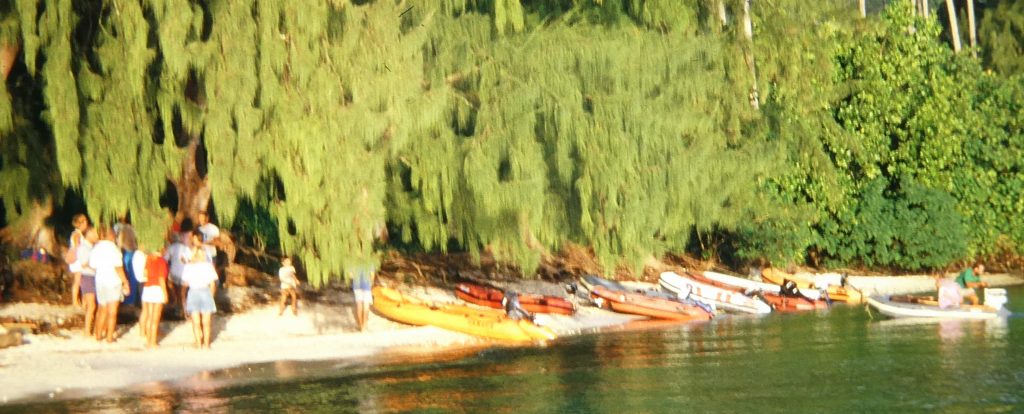
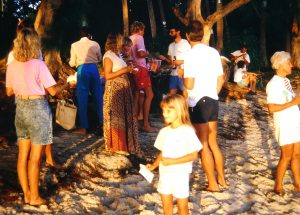 We were by then waiting to sail for Raiatea, but again we stayed to wait for good conditions. This took us through July 4, the big day of celebration for all Americans. They had arranged for a big evening beach party, to which we were invited along with another Australian and a South African boat. Among those there was the famous American sailor and sailmaker Lowell North, with his Tayana 52. We were to became good friends with Lowell and Lynn, seeing them again in many places in the south-west Pacific.
We were by then waiting to sail for Raiatea, but again we stayed to wait for good conditions. This took us through July 4, the big day of celebration for all Americans. They had arranged for a big evening beach party, to which we were invited along with another Australian and a South African boat. Among those there was the famous American sailor and sailmaker Lowell North, with his Tayana 52. We were to became good friends with Lowell and Lynn, seeing them again in many places in the south-west Pacific.
It was another splendid party, complete with a fire and sing-song – very American!
The next morning dawned with blue skies, so we moved out, along with several of the others. We had a good sail for the rest of the morning, squally but dry when we arrived at our next destination in the Society Islands, Raiatea.
Raiatea
Raiatea is the ancient religious, cultural and political centre of the group. It is held that many of the great Polynesian voyages to Hawaii and New Zealand started from here.
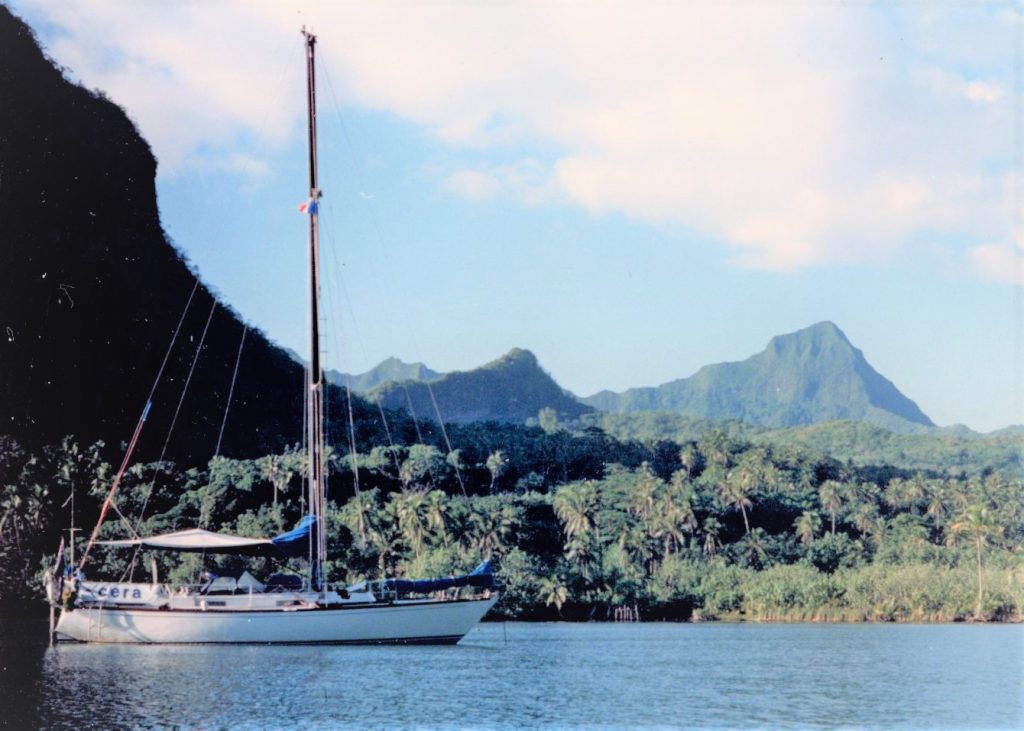
We came through the reef by way of the Passe Iruru on the eastern side. It was another beautiful approach across the lagoon and into Baie Faaroa. This is a long inlet into the island, deep in a steep-sided valley clothed with green cultivation over the hillsides. We anchored towards the inner end of the bay, latterly in muddy, murky water as it became shallow. There were a few simple local dwellings along the southern shore and some trendy French houses on the northern side. At the end, beyond the 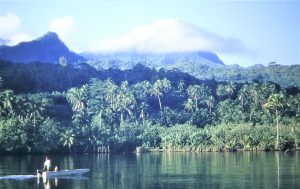 shallows, there was the mouth of the River Apoomatai, with the river valley beyond. This meant that the end of the bay was open, not enclosed as in Moorea.
shallows, there was the mouth of the River Apoomatai, with the river valley beyond. This meant that the end of the bay was open, not enclosed as in Moorea.
 After a calm and peaceful night we took the dinghy up the Apoomatai, the only navigable river in French Polynesia. Soon after the start there was thick growth and overhanding palms, and it soon opened up into wide planation country. There were a few local shacks, with plywood
After a calm and peaceful night we took the dinghy up the Apoomatai, the only navigable river in French Polynesia. Soon after the start there was thick growth and overhanding palms, and it soon opened up into wide planation country. There were a few local shacks, with plywood 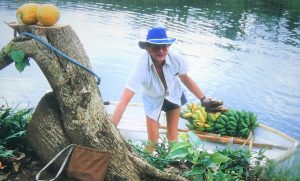 dinghies on stands outside. We were just commenting that the local people here didn’t seem that friendly when a man on the riverside waved a pawpaw at us. He insisted on giving us an enormous bunch of bananas (about 300!), as well as pawpaws, taro and tarna (cassava) leaves. In a little while two geckos emerged, and one spider. Back at the boat, we hung the whole lot over the pushpit rails for later attention.
dinghies on stands outside. We were just commenting that the local people here didn’t seem that friendly when a man on the riverside waved a pawpaw at us. He insisted on giving us an enormous bunch of bananas (about 300!), as well as pawpaws, taro and tarna (cassava) leaves. In a little while two geckos emerged, and one spider. Back at the boat, we hung the whole lot over the pushpit rails for later attention.
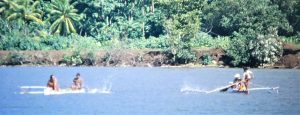 It was a beautiful Pacific afternoon, with a light sea breeze, blue skies and a cooler land breeze as the sun fell. There were sounds of Tahitian drums from the shore. Local people were fishing assiduously all day, trolling from pirogues and setting nets. The following morning was beautifully calm and dewy, although Norma was feeling her bones a bit. We motored out of the bay past green curtains of vegetation draped over the cliffs and hillsides, and turned down south between the reef and the land.
It was a beautiful Pacific afternoon, with a light sea breeze, blue skies and a cooler land breeze as the sun fell. There were sounds of Tahitian drums from the shore. Local people were fishing assiduously all day, trolling from pirogues and setting nets. The following morning was beautifully calm and dewy, although Norma was feeling her bones a bit. We motored out of the bay past green curtains of vegetation draped over the cliffs and hillsides, and turned down south between the reef and the land.
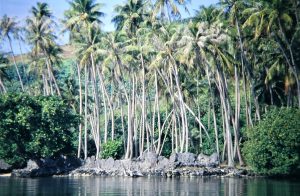 We took a brief stop in Opoa Bay to take a look at the Marae Taputapuatea, one of the largest and best preserved of its kind in Polynesia. Its mighty ahu is 50 metres long and 10 metres wide, and over 3 metres high. In front of it there’s a rectangular courtyard paved with black volcanic rocks. A platform once bore the image of Oro, who is supposed to have been born from the volcano in the centre of the island. It is stated to be a starting place for Polynesian Pacific voyagers, and fires on the marae may have been beacons for the ancient mariners.
We took a brief stop in Opoa Bay to take a look at the Marae Taputapuatea, one of the largest and best preserved of its kind in Polynesia. Its mighty ahu is 50 metres long and 10 metres wide, and over 3 metres high. In front of it there’s a rectangular courtyard paved with black volcanic rocks. A platform once bore the image of Oro, who is supposed to have been born from the volcano in the centre of the island. It is stated to be a starting place for Polynesian Pacific voyagers, and fires on the marae may have been beacons for the ancient mariners.
We continued down to Nao Nao Island, an uninhabited motu on the outer reef at the southern end of the island. It was a popular stop for the yachts and a very pretty anchorage. Norma went ashore there for a walk, but the mosquitoes were bad and continued to be a problem into the evening, which had so far been unusual here. We had to mesh all the hatches and companionway. The bugs drove us away in a bright morning the next day, and we continued circling the island and turning up the western side of Raiatea between the island and the reef. The channel was narrow and shallow in parts, and I did a fair bit of 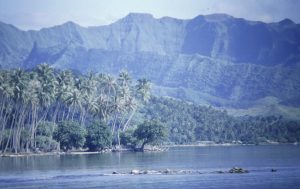 piloting from up the mast. We edged our way very cautiously into Vaiaau bay, past a small village to our left and on to the end. We anchored in mud near the mouth of the Maoroa river. The river valley extended in to the east. A knifelike line of mountain crests ranged further up the valley, its heads in the clouds, the vegetation backlit over the dark precipitous cliff faces. The water was murky, perhaps because most of the waterside dwellings had overwater dunnies . . .
piloting from up the mast. We edged our way very cautiously into Vaiaau bay, past a small village to our left and on to the end. We anchored in mud near the mouth of the Maoroa river. The river valley extended in to the east. A knifelike line of mountain crests ranged further up the valley, its heads in the clouds, the vegetation backlit over the dark precipitous cliff faces. The water was murky, perhaps because most of the waterside dwellings had overwater dunnies . . .
At sundown flowers came drifting down past us from up the river valley. Locals were paddling past, but did not respond to our waves.
The next leg took us out to sea through the narrow and rather shallow Passe Taomaro, the water flat and the transit quite easy. We motored on up offshore with Raiatea looking so pretty, rising up behind the small surf on the outer reef. We approached the land again through the Passe Rautoanui, which was wide, deep and easy. We continued up between the reef and the land, passing modern developments on the land and at the northernmost tip where lay the airport. We anchored on the inner side of the reef in a small lagoon, north of the airport. There were reefs all around us, and close to the north we could see the adjacent island of Tahaa, which is encircled along with Raiatea by a huge barrier reef broken only by a few passes.
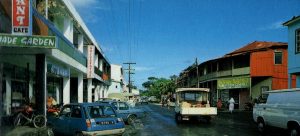 It was a beautiful trade-wind day, blue skies and puffy white cumulus. Norma was soon in the clear water, back under the boat with a brush.
It was a beautiful trade-wind day, blue skies and puffy white cumulus. Norma was soon in the clear water, back under the boat with a brush.
The wind built overnight and we moved back to the island through sloppy chop to a small-boat harbour to the east of the airport. We walked into Uturoa, which is the main town in the Society Islands. It was a typical Polynesian place, a couple of roads, lots of Chinese stores and a conventional supermarket with a reasonable choice of stores.
We did some good stocking up and motored north across the lagoon to Tahaa. There are many banks of coral between the two islands, but the passes between them were well marked and easy to navigate through. We continued up past the south-east corner of Tahaa and came to Baie Haamene. This was another long, winding inlet leading to a village at the inner end, and we anchored on the north side out of the brisk trade wind.
Tahaa
In Haamene bay the first thing we did was sort out our mass of bananas and other fruit. There were two families of geckos still living among them, and we took them ashore. Norma took some bananas to an American yacht with rather a rather weird crew collection.
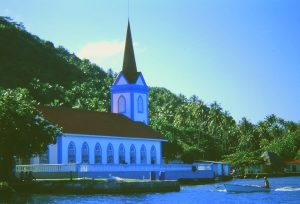
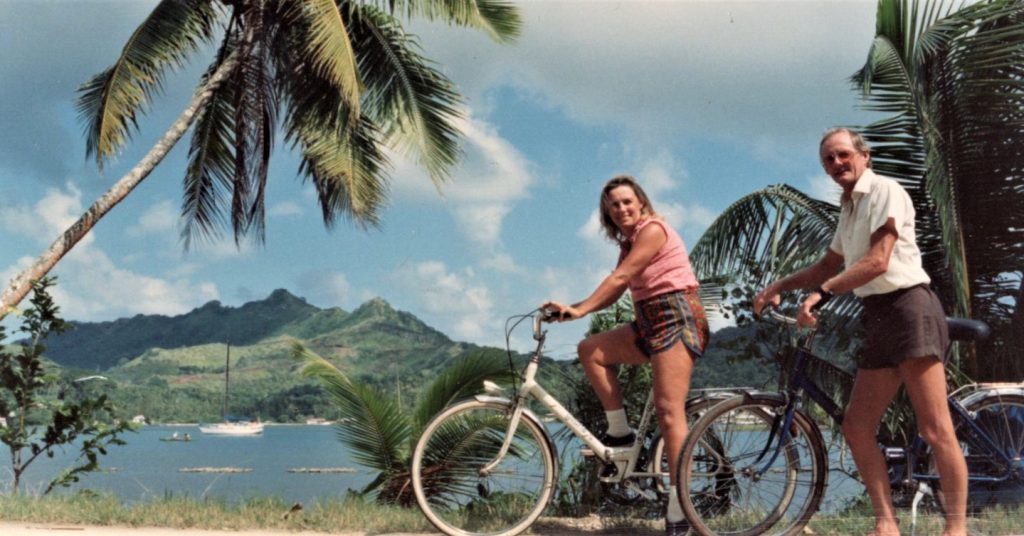 Over the next few days we stayed put because of unpromising weather, and simply did some local exploring. The village ashore was typical: the church was prominent; most houses were simple and some were built from cement blocks. There were many schools for all ages, looking new and neat. The copra racks were full, and copra was being loaded into several sacks. We dined on steak and cassava salad, very Polynesian. There were a couple of Chinese stores – where we bought more insect repellent - and a post office up a road lined with “modern” boxy new houses surrounded, as ever, by bright shrubs and flowers. We cycled along the northern shore of the bay through strings of Polynesian boxy dwellings and copra drying racks.
Over the next few days we stayed put because of unpromising weather, and simply did some local exploring. The village ashore was typical: the church was prominent; most houses were simple and some were built from cement blocks. There were many schools for all ages, looking new and neat. The copra racks were full, and copra was being loaded into several sacks. We dined on steak and cassava salad, very Polynesian. There were a couple of Chinese stores – where we bought more insect repellent - and a post office up a road lined with “modern” boxy new houses surrounded, as ever, by bright shrubs and flowers. We cycled along the northern shore of the bay through strings of Polynesian boxy dwellings and copra drying racks.
We cycled on rough roads of coral rock up a shoulder in the hills behind the village from which we looked down Haamene and a similar bay just to the north, Fa’aha Bay. Up there we met friends from the group with which we had become close, and 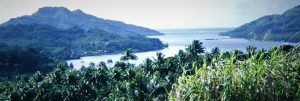 discussed the next leg, over to Bora Bora. Currently, the wind was strong and not in the right direction, being managed by yet another passing “winter” trough. Bora Bora was under black clouds.
discussed the next leg, over to Bora Bora. Currently, the wind was strong and not in the right direction, being managed by yet another passing “winter” trough. Bora Bora was under black clouds.
It was not as spectacular an anchorage as some others we had visited, but it was surrounded by attractive sloping hillsides, covered in the normal dense growth. We were protected from the variable winds and the holding in mud was excellent.
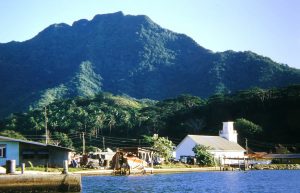 For a change of scene we moved up a little way to the northern shores and pulled into Baie Pahura, anchoring off the tiny village of the same name. It was yet another pretty anchorage, with many palm trees on a rocky point over which we could see Bora Bora. The houses were older-style Polynesian with thatched roofs. Pigs, ducks
For a change of scene we moved up a little way to the northern shores and pulled into Baie Pahura, anchoring off the tiny village of the same name. It was yet another pretty anchorage, with many palm trees on a rocky point over which we could see Bora Bora. The houses were older-style Polynesian with thatched roofs. Pigs, ducks 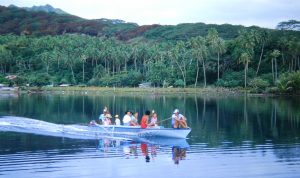 and chickens were wandering around, and cows were in a field by the village. The local people were waving from their outboard-powered outrigger boats, more cheerful and friendly than in many other places. This was probably because very few yachts were anchoring in this particular bay.
and chickens were wandering around, and cows were in a field by the village. The local people were waving from their outboard-powered outrigger boats, more cheerful and friendly than in many other places. This was probably because very few yachts were anchoring in this particular bay.
For another change we moved on round to a large motu in the reef to the north-west side of the island, Motu Tautau. This was a popular holiday place, and a group of local people were camping. There were no other yachts.
The weather cleared and wind became more favourable, so the next day we motored back across from the reef to Tapuamu village in a bay on mainland Tahaa. Norma rowed ashore and found a nice little marina and a place to buy bread.
We left Tahaa through the narrow but well-marked Passe Paipai, the only navigable one on the west side of the island. It was then about 20 nautical miles over to Bora Bora and the pass into the Bora Bora lagoon, also on the western side.
Bora Bora
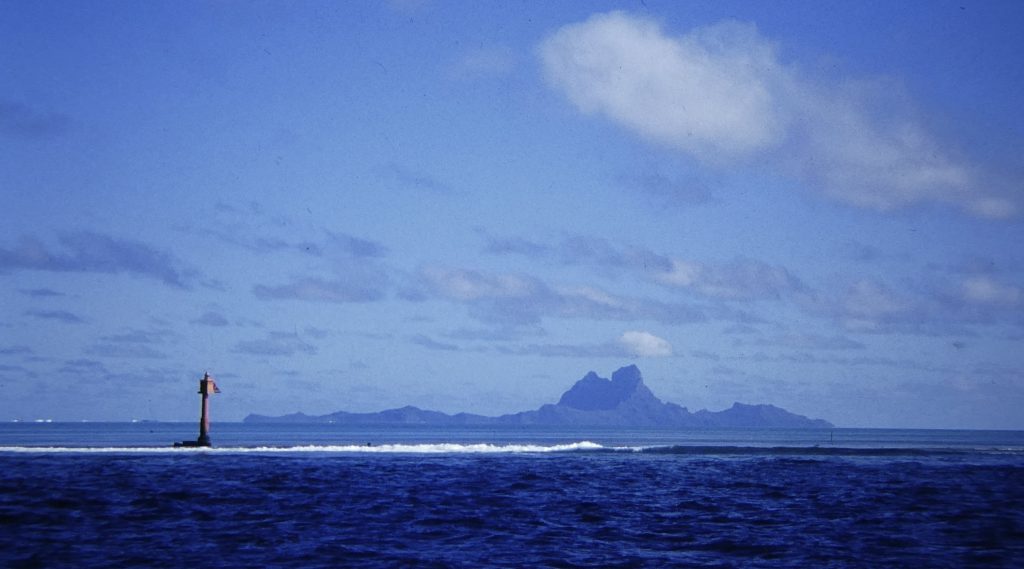 For all its fame, Bora Bora is actually one of the smallest islands in this group, known as the Leeward Islands. But it looked extraordinarily impressive as we skirted the reef that extends a long way off the south of the island and sailed up to the wide and easy pass half way up its western side.
For all its fame, Bora Bora is actually one of the smallest islands in this group, known as the Leeward Islands. But it looked extraordinarily impressive as we skirted the reef that extends a long way off the south of the island and sailed up to the wide and easy pass half way up its western side.
Just in from the pass on its south side is the tiny Motu Tapu with its wide white beach of coral sand. We anchored there. Across the lagoon we could see many yachts lying off the Hotel Oa Oa and the yacht club on the main island. The cliff-like western face of the mountain range was towering over them. There was another larger island close to us, to which we would return later. The whole outlook was extraordinarily beautiful. Two yachts with whom we were already friendly came over for a long wine session in the evening.
It was flat calm overnight, and in the morning we took the dinghy over to the hotel to check out their facilities and moorings. Most anchorages on the western side of the main island were very deep, and the hotel moorings were popular. In the evening we joined a big family in a big boat (Sourisa) for a barbeque on the motu.
The next dinghy trip over to the main island was to the main town of Vaitape, a prosperous little place with many tourists. We visited the Bank of Tahiti, where the manager set up arrangements to pay our bond back in Australian cash. This was Monday, and the cash should be ready by Friday, he said. We did some basic shopping and returned to the boat. The six-year-old boy on Sourisa had impetigo, for which I administered some basic treatment and reassurance.
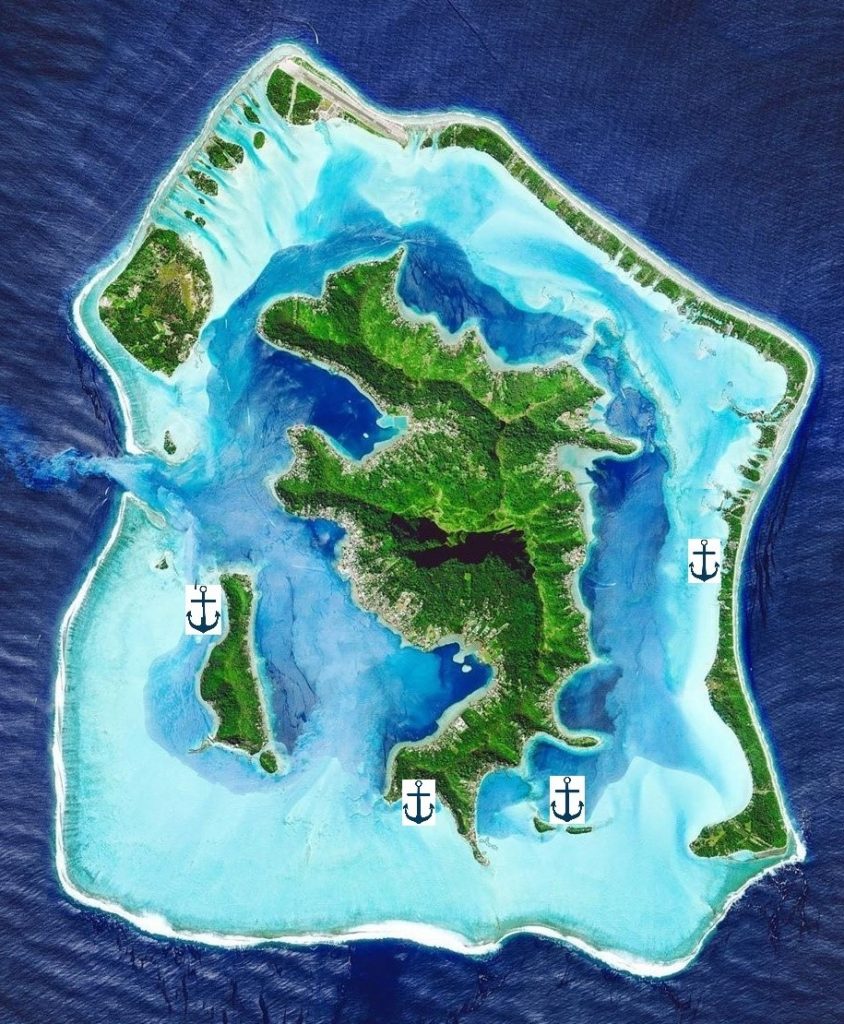 We and Sourisa then set out to go round to the other side of the main island. The channel between the barrier reef and the island was deep to start with and past the airport built out on on the barrier reef, but we soon encountered a shallow strip of sand and coral across the channel round the north-east, followed by a shallow and corally stretch. This can be seen in the aerial picture here, along with the locations of our four main anchorages.
We and Sourisa then set out to go round to the other side of the main island. The channel between the barrier reef and the island was deep to start with and past the airport built out on on the barrier reef, but we soon encountered a shallow strip of sand and coral across the channel round the north-east, followed by a shallow and corally stretch. This can be seen in the aerial picture here, along with the locations of our four main anchorages.
We had had some advice from another boat on where to look for a guidance mark, a bunch of palm trees, and we were closely followed by Sourisa as we edged across the shallows. We anchored in a lovely spot on the inner side of the reef, off a line of little motus and coves at the north end of Motu Taufarii. The view of the “back” side of Bora Bora was gorgeous.
Sourisa was over in the evening for the kids to see Norma’s wonderful collection of shells.
The next day we groped further down the channel, very shallow until we got to deeper water off the village of Anau, then getting narrow again until we came to the southern end of navigable water, We anchored just off the small motus of Motu Piti Uta and Uu Tai. This was another spectacularly beautiful place, and the only other yacht there was Arietta, with Mark and Lorraine, with whom we to become great friends. The Sofitel Maramahotel was on the mainland beach, and around us were several tourists in reproduction dugout outriggers.
Mark speared a big octopus, and the four of us went ashore so that Norma could show them how to deal with it! We took three legs for ourselves.
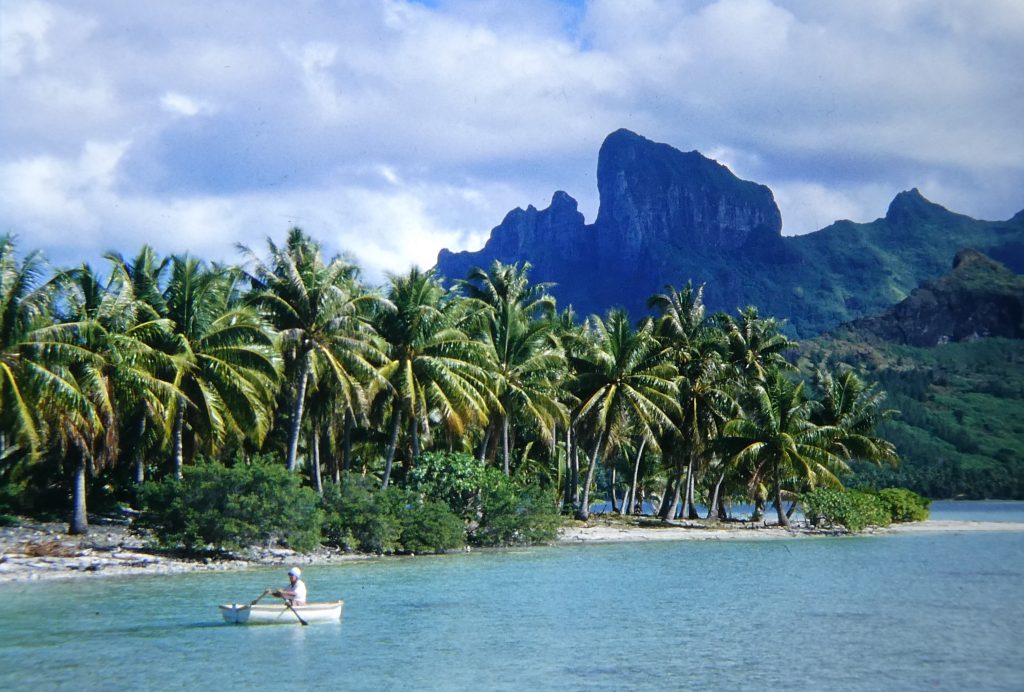
We were well protected here from squally westerly winds, contrary to the prevailing trades. Some boats had left for distant islands to the west, and were having a bad time. Many had not really given Bora Bora half a chance by sitting on moorings or in a marina instead of some (admittedly quite difficult) exploring through the coral.
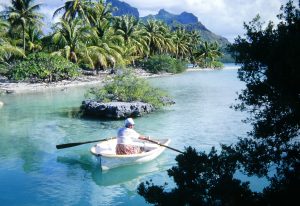 During the afternoon we were upset by the sight of some local children were tormenting a screaming baby goat which then, just as Norma rowed ashore to remonstrate with them, had its throat summarily cut by their parents. It spoiled the idyll, somehow. There was more slaughtering the next morning, so we moved back up to near where we were before, still very pretty and protected by reef motus from the re-building easterly.
During the afternoon we were upset by the sight of some local children were tormenting a screaming baby goat which then, just as Norma rowed ashore to remonstrate with them, had its throat summarily cut by their parents. It spoiled the idyll, somehow. There was more slaughtering the next morning, so we moved back up to near where we were before, still very pretty and protected by reef motus from the re-building easterly.
We had to go back to the main town to see about our bond money, so we motored back out and over the shallows to the western side and Vaitape. Gusty winds were barrelling over the mountain. I went ashore by dinghy while Norma looked after the boat. I was told that the bank in Papeete had “forgotten” to send any Australian money, so I took most in USD and some Aussie dollars they had there. We then swopped places and Norma went ashore for some food shopping – frozen lamb leg and flour, both good deals here.
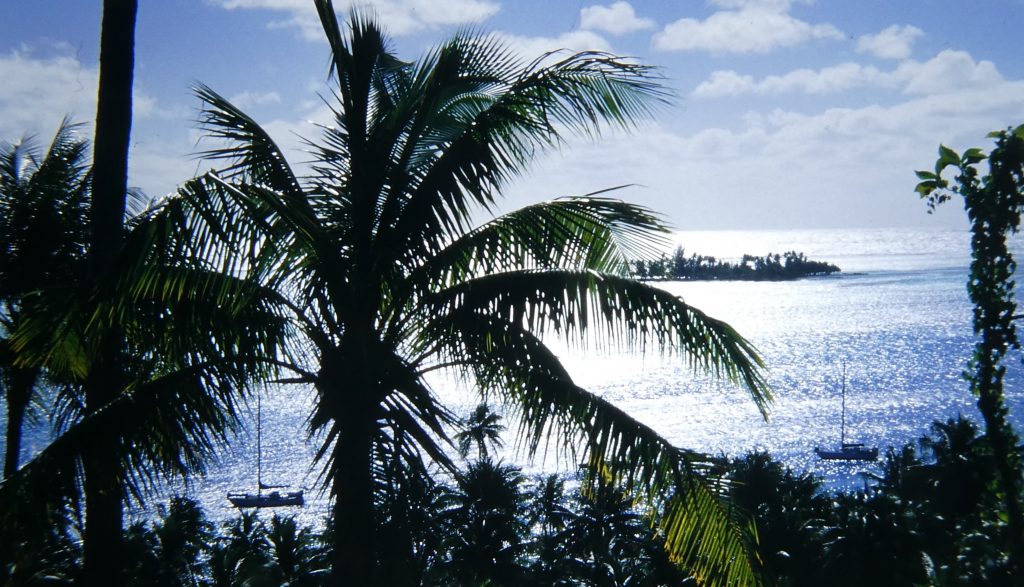 We then went down to To'opua Island, close to the inner side of the great reef to the south west and the tiny Motu Tapu where we'd anchored on first arrival. After a little exploration we anchored in a bay on its western side off the beach in seven metres, not bad for here, well protected from the worst of the gusts over good-holding sand. There were some friends already there in Ambler, and Arietta soon joined us.
We then went down to To'opua Island, close to the inner side of the great reef to the south west and the tiny Motu Tapu where we'd anchored on first arrival. After a little exploration we anchored in a bay on its western side off the beach in seven metres, not bad for here, well protected from the worst of the gusts over good-holding sand. There were some friends already there in Ambler, and Arietta soon joined us.
After a couple of days more great socialising and walking on the island we returned to the main island, at the southern end taking a narrow and shallow passage into a basin by the Hotel Bora Bora. There were no other boats there. We were visited by the gendarmes “pour recherche”, we filled in a form, papers all OK, no problems.
The weatherfax showed more bad weather approaching as a vigorous front, but it was initially calm in the morning. We took a half-hour run in the dinghy to the fuel dock near the Hotal Oa Oa to fill a pair of jerrycans and do a little basic shopping. Returning to our little bay we were joined by Lowell and Lynn North in Wanago. The front came through the next morning but the squalls soon cleared. The coral here had a reputation for excellent snorkelling, and the Norths were very impressed, but for us - all right, but we'd seen better.
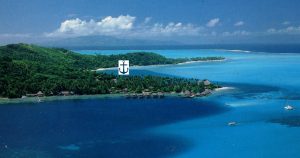 We visited Wanago, where Lynn told me that she had not been feeling well for quite some time: lethargic, headaches, dry and thirsty. I soon diagnosed that she was quite seriously dehydrated and recommended the usual tropical remedy, Tang powder in water with some salt added, as much as possible to be drunk regularly. Like many Americans she never drank water, only Coke in quite small amounts, and never used salt at all.
We visited Wanago, where Lynn told me that she had not been feeling well for quite some time: lethargic, headaches, dry and thirsty. I soon diagnosed that she was quite seriously dehydrated and recommended the usual tropical remedy, Tang powder in water with some salt added, as much as possible to be drunk regularly. Like many Americans she never drank water, only Coke in quite small amounts, and never used salt at all.
A strong southerly whacked in overnight. The anchorage was wide open to the sea to the south, and only protected by the barrier reef, but it was too late to move out before the pitching and tossing began. We were worried about getting out and negotiating the narrow channel in poor conditions, but took it on early in the morning and battled the 30-knot beam winds successfully. We went up past the town, where waves were breaking over the Oa Oa wharf and mooring lines were becoming seriously abraded by the violent movements of the yachts. We motored back over to the north end of To'opua island and anchored in the first bay down on its western side. “Blessed relief”, records the log.
By this time we were waiting to leave, but it was still too windy for comfort. Our philosophy always was that to leave in poor conditions was to invite self-inflicted injury! But then after a calm night catching up on sleep we weighed anchor, motored over to Vaitape for Norma to take the dinghy ashore for a final stock-up, and by 10:00 am we were leaving the pass and farewelling Bora Bora.
We had been nearly two weeks in this most dramatic and beautiful of all the islands in French Polynesia, and it was a fitting climax to this stage of our voyaging in the South Pacific. During the lulls in changeable weather we had enjoyed many different anchorages and much socialising with the many friends that any yachties inevitably make when transiting the same waters and the same islands along the same route.
On review, it did seem that we had enjoyed the Society islands of French Polynesia more than several others. We heard lots of complaints about too-deep anchorages, unfriendly locals, poor snorkelling and diving, and lack of fish. Well, maybe; but there were still many places to anchor which were not too deep for us and which were usually enhanced by surroundings of exceptional splendour. The local people in some islands may have appeared dismissive, but had simply seen enough of tourists, including yachties, and just want to get on with their lives in peace. This was fine by us. And in the more remote spots, many of the locals overwhelmed us and others by gifts of fruits and vegetables.
We didn’t do much in the way of snorkelling, because nothing can really match such places as Belize and Honduras; anyway, swimming around coral and marvelling at pretty fish have always been secondary activities for us, rather than the primary reason for cruising it seemed to be for some. On the plus side, there are few or no frighteners in the way of sharks and barracuda in French Polynesia.
Our planned destination of Neiafu, Tonga, was about 1,200 nautical miles to the WSW. We had decided to sail directly from Bora Bora to Tonga, bypassing the Cooks, because we had previously been to many of the best of the Cook islands during our previous sojourn in the South Pacific when sailing east in 1982.
Vava'u group, Tonga
We were much looking forward to our return to the Tonga's northern Vava’u group, a compact set of islands which make for almost perfect cruising: good winds in flat water for enjoyable day sailing (something we rarely do), lots of great anchorages, exceptionally nice people, and very good provisioning by the standards of islands of the Pacific. We were to find it essentially unchanged, to our delight, and we explored many favourite anchorages of old as well as the few places we had not been to before.
The evening before leaving we were joined by Arietta, who came over for discussions on Sydney, where they were intending to visit. We also had a good talk on passage-making in the trade winds, because we had for some time been getting a reputation as weather forecasters. Observations indicate that seasonal weather in the south-west Pacific passes through in fairly regular waves, and for passages of about a week or less it is possible, by watching the weatherfax carefully, to time departures to make the best of the easterly trade wind conditions. Well, that theory worked well for the first part of the coming passage, anyway.
Over the last four or five days in Bora we had suffered some seriously windy and wet weather associated with a vigorous trough. The indications were, though, that the trough was dissipating, and in accordance with the above we should get a period of good passage-making weather. After a calm night, catching up on sleep, the morning dawned fine with some light but gusty wind from the south-east. The conditions were propitious, in our opinion, and after a quick shopping trip we cleared the pass out of the Bora lagoon at 1000 hours on Thursday July 27, 1989.
In the afternoon we passed a little to the south of Maupiti atoll. We could clearly see the pass on its southern tip and wild surf breaking ferociously on each side. We spoke to a yacht we could see in the lagoon – they couldn’t get out!
The wind was about 25 knots, good sailing, but the winds of the last few days had built up a steep and confused swell. Once past Maupiti we were able to settle in for sailing dead downwind in the trades under sunny skies, and the weather maps looked good. That night we didn’t need to touch anything; the wind was down a bit but the seas still agitee, in the words of the French forecast. We soon passed about 10 miles to the north of the small Manuai atoll, the last obstacle until Palmerston atoll about 500 miles away.
We settled into pleasant, reasonably fast, trade-wind sailing, with little to do in terms of yacht management. We ate regularly and well, settled into our usual routine for the day and night, and slept like logs when off watch. The sound of the sea rushing by the hull was a constant, with the ocean only separated from us by a foot or so and a few layers of glass reinforced plastic. As others have reported (but not including Norma), when lying in my bunk half asleep, in the sounds of the rushing sea I could often hear human voices, but never clearly enough to understand what they were saying to me. I celebrated my 52nd birthday as Norma baked bread.
Approaching the end of the first week out we had to pass through a weak trough, humid with showers with shifty winds and a short spell of dead calm. The wind returned but we were still in a convergence zone with shifty winds, some rain and distant big black clouds with lightning in them. So it was slower and harder going for the next four days, and even during the spells of blue sky the wind was too weak for spirited sailing. A couple of days before arrival we crossed over the Tonga trench, one of the deepest depths in the Pacific at about 9 kilometres.
By this time we were back to sailing quite nicely, although we were hard on the wind approaching the north of Vava'u island and rounding its north-west headland of Point Houmafakalele – what a splendid Tongan name!
We sailed on down the western side of Vava'u until we could turn inland into the passage between the islands of the archipelago that would lead us up to the capital, Neiafu. It was getting dark by this time, but we were familiar with these waters and knew that a convenient overnight stop would be at a lovely little anchorage in the bay south of little Lotuma Island, about three nautical miles in from the open sea and half way to the town. It was flat calm as we anchored – with relief – and dark fell.
It was a reasonable passage with splendid sailing for the first half, but the light and difficult winds during the latter days were frustrating and gave us work to do. We had sailed a total of 1,332 nautical miles (a slight curve to the north of the rhumb line forced by the wind directions had increased the original estimate) in 12 days and 8 hours at an average of 108 miles a day. This was not as slow as it felt, with perceptions influenced by the very slow last four days.
It was a blissfully peaceful night at anchor and we enjoyed the usual jet-lag sleep.
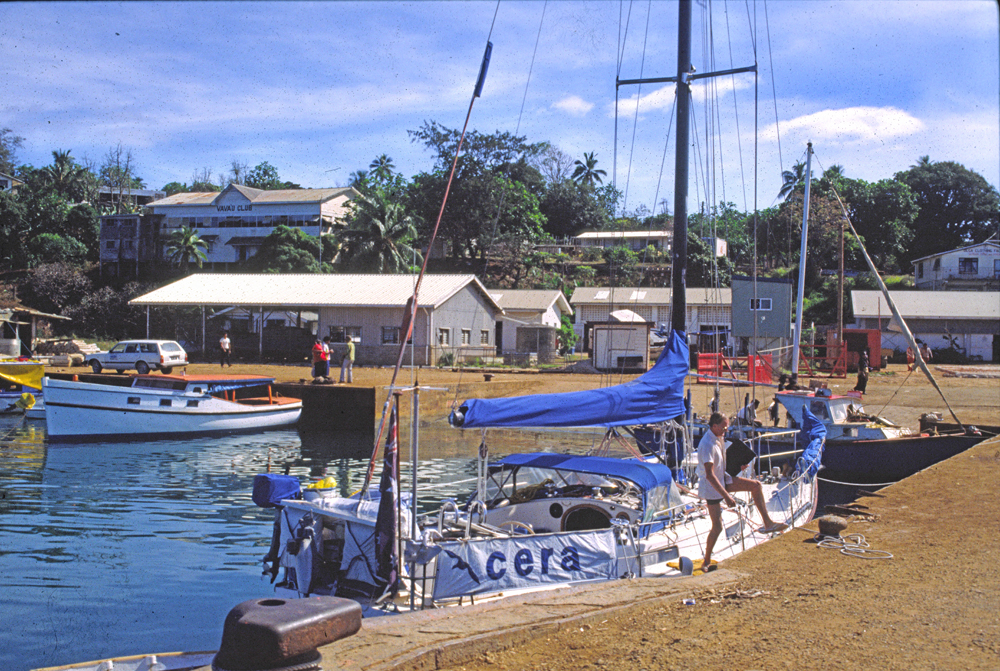 In the morning we tied up at the town wharf to obtain the various clearances. We were told to wait for Customs. After some reminders, Immigration and Customs officials did finally turn up, but we were told to wait for health clearance. We continued to wait, but after a total of five hours we were told to go! Meanwhile, Norma did a pile of washing with water from the wharf tap.
In the morning we tied up at the town wharf to obtain the various clearances. We were told to wait for Customs. After some reminders, Immigration and Customs officials did finally turn up, but we were told to wait for health clearance. We continued to wait, but after a total of five hours we were told to go! Meanwhile, Norma did a pile of washing with water from the wharf tap.
We moved to anchor in Neiafu Harbour, beyond the Paradise Hotel, and started catching up with friends, some of whom we hadn’t seen for years. This is inevitable in such a popular cruising ground as the Vavau group, where many of the yachts were travelling in same (westerly) direction and have been doing so since Europe and the Americas. Mark and Laraine in Arietta soon arrived and joined us for evening drinks.
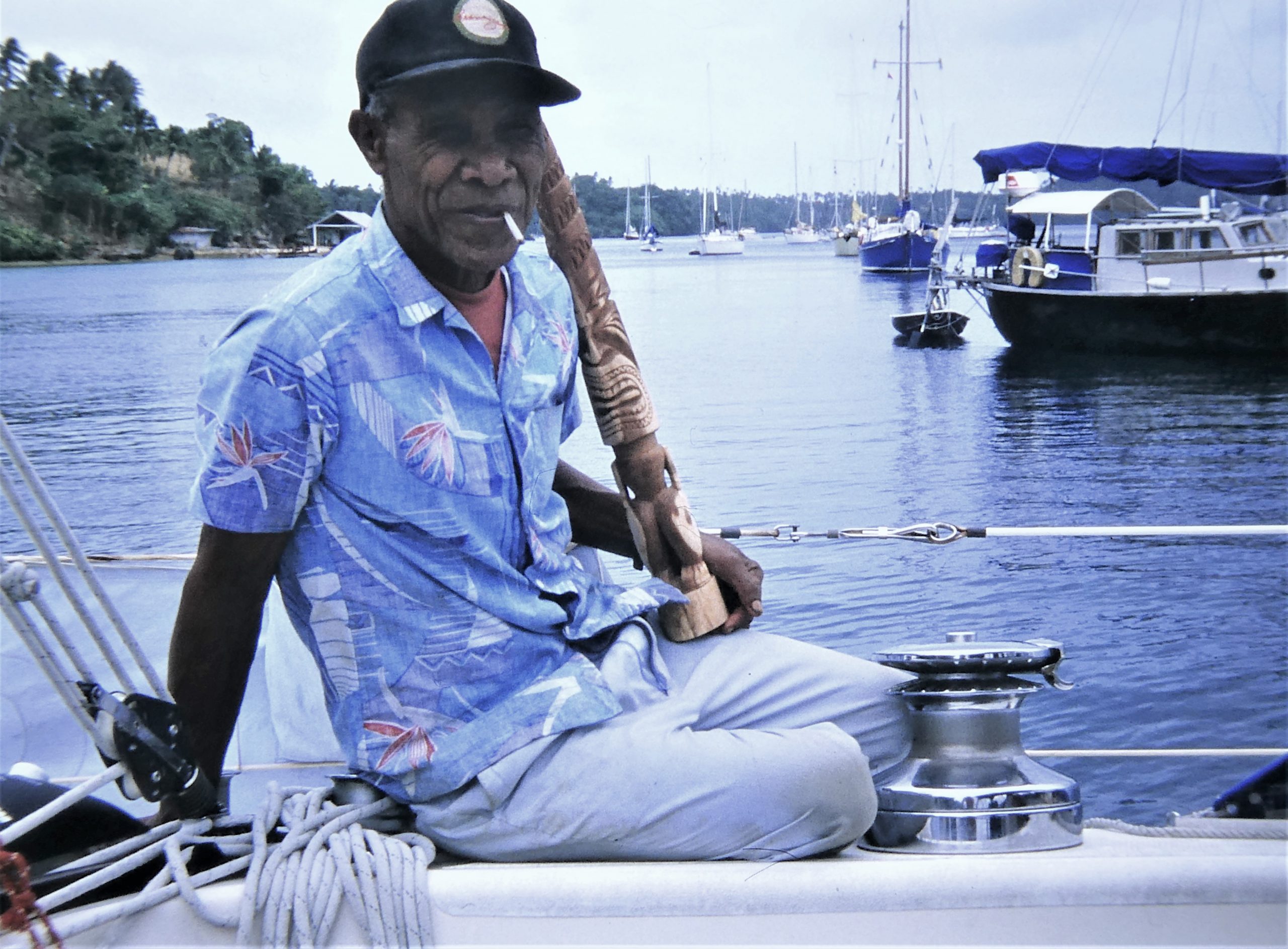 We also caught up with local men who remembered us from six years ago: “where have you been?” asked Metoto, whose feasts we had regularly attended back then. And there was the woodcarver John, who came aboard for a long talk and from whom we bought a lovely carving.
We also caught up with local men who remembered us from six years ago: “where have you been?” asked Metoto, whose feasts we had regularly attended back then. And there was the woodcarver John, who came aboard for a long talk and from whom we bought a lovely carving.
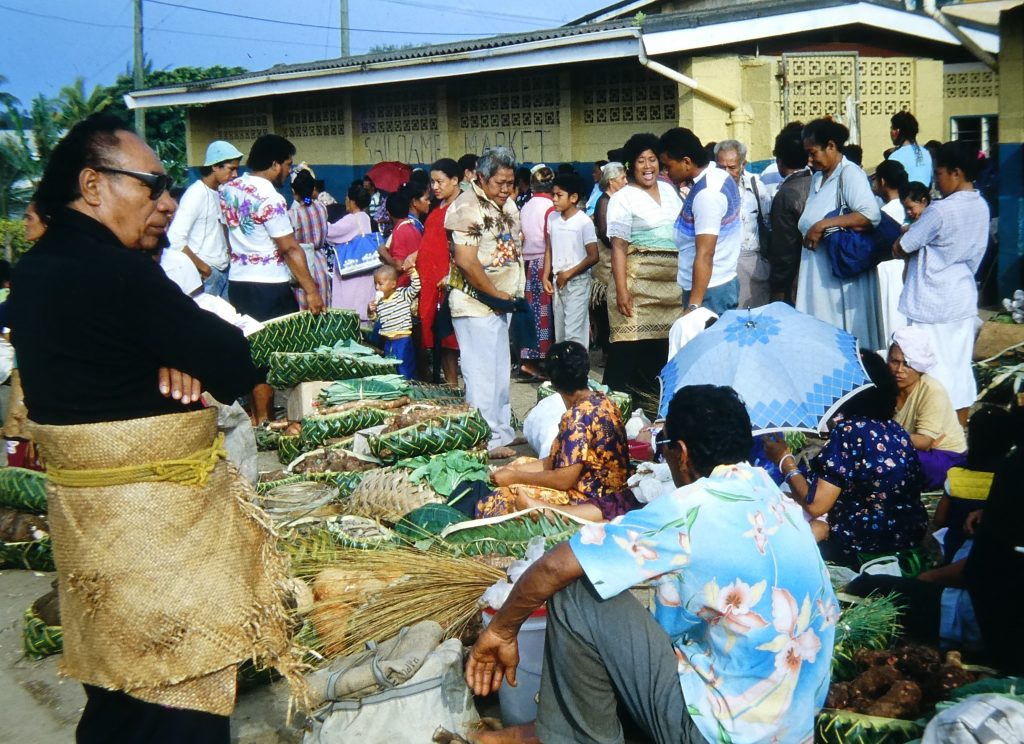 We soon got into the shopping in Neiafu village, where we found that although some buildings had been done up, not much had changed. We were delighted that the butcher was just the same, with wonderful fresh meat at low prices, butchered into big joints and served through a small wooden window. The handicrafts, especially the basketry, were as good as ever. Everyone, as we well remembered, was a pleasure to talk to and deal with.
We soon got into the shopping in Neiafu village, where we found that although some buildings had been done up, not much had changed. We were delighted that the butcher was just the same, with wonderful fresh meat at low prices, butchered into big joints and served through a small wooden window. The handicrafts, especially the basketry, were as good as ever. Everyone, as we well remembered, was a pleasure to talk to and deal with.
For a more peaceful anchorage we moved down to the far end of the harbour bay, where instead of pop music from the hotel we were entertained by singing from the villages. There were masses of flying foxes in the trees. The weather was beautiful.
The next move was out of the harbour and down to anchor off the reef around the small islet of Mala, where we did some snorkelling and Norma found a superb (dead) tiger cowrie. We did a bit of underwater hull cleaning, getting off the longer grass. It was getting to be hard work by now. The water was distinctly cool, although the air temperature was warm.
Mala was being used as a little farm, and Norma went ashore to feed the pigs. We went round Kapa Island to a beautiful semi-circular bay, Port Maurelle. A yacht at anchor there looked very similar to that of a long-time friend, Julia Hazel, who had built a boat from sheets of steel by herself and then circumnavigated the world single handed. She had returned to Australia the previous year, and wondered if it was her. But no; this was a second boat by the same designer and owned by a motor racing 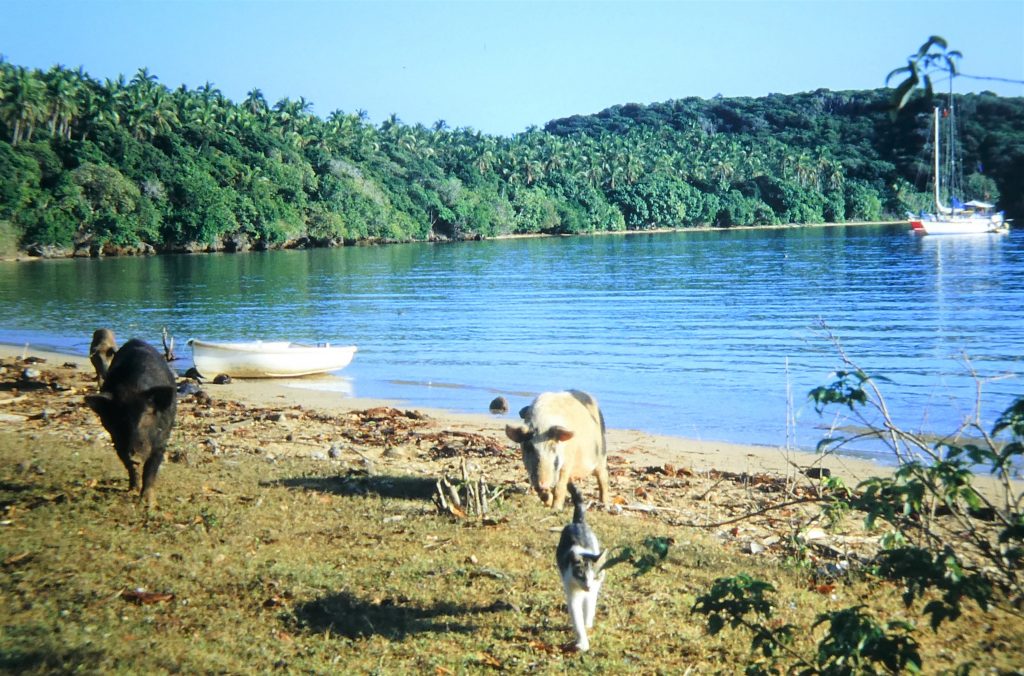 friend of ours, Wally Willmott, who had been Bruce McLaren’s senior mechanic. There was time only for a quick reunion, as they were just off for Suva.
friend of ours, Wally Willmott, who had been Bruce McLaren’s senior mechanic. There was time only for a quick reunion, as they were just off for Suva.
The wind was blowing into this bay, so we moved over to a near-circular bight in in the southern end of the uninhabited Vaka’eitu Island. There were quite a few boats that we knew there, including Dream Maker, with Jim and Pam, whom first met in the Chesapeake. There was very good snorkelling around the fringing reef, with a good drop-off and pretty coral. Norma did some successful fishing from the boat and collected some edible shellfish, all making for a splendid dinner after drinks on another boat. It was calm and blue the next day, and Norma went ashore to feed on the beach some very friendly pigs and a cat.

We motored out and over to anchor off the sand spit between Taunga and Ngau islands. This was a gorgeous spot, with a long golden sand beach washed by shining blue water. We took a dinghy trip around, during which time a southerly wind blew in. By the time the wind got too much it was too late to move, so we had a deservedly disturbed night.
There are masses of coral reefs around the islands of the southern part of the Vavau group, and they separate the western and eastern parts of the archipelago. There is a tortuous and shallow pass through the reefs from one side to another, and although the visibility of the channel for conning purposes was poor, it was sufficient. Once through, we motored up to the big bay – the “old harbour “ – on the eastern side of Neiafu town and harbour. It was possible to walk overland to the town from here, after taking the dinghy up through an expanse of coral along a dredged slot.
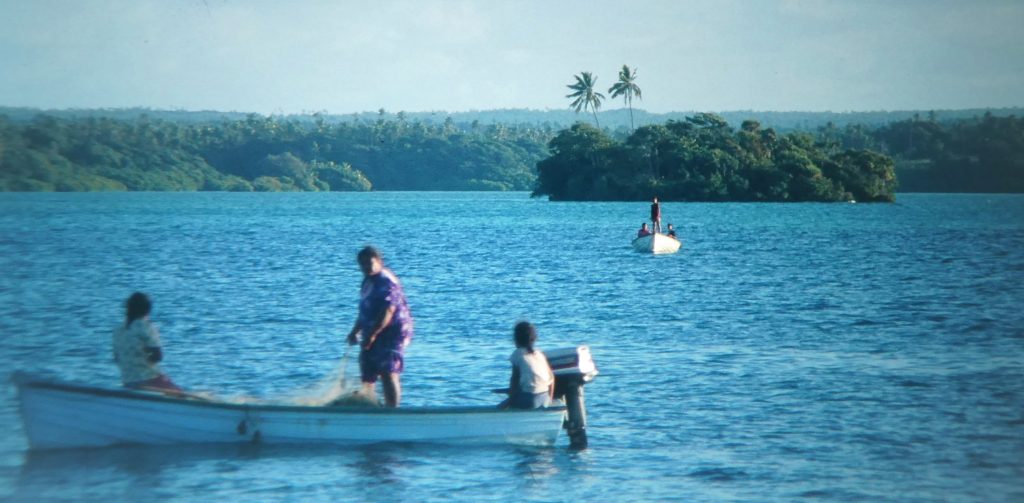 We reprovisioned at the market, including a whole rump steak, which was only available if you knew enough to specifically ask for it on the right day. After returning to the unimpressive anchorage we moved over to a delightful spot in a nearby bay off the village on Oloua Island. We looked over to a very native scene, with scores of children running around, pigs all over the beach, fishing nets being laid in the shallows. We were soon offered a turtle shell, breadfruit, beans and simple handicrafts. We were pleased to see that Arietta was there, and we shared pre-dinner margaritas with them.
We reprovisioned at the market, including a whole rump steak, which was only available if you knew enough to specifically ask for it on the right day. After returning to the unimpressive anchorage we moved over to a delightful spot in a nearby bay off the village on Oloua Island. We looked over to a very native scene, with scores of children running around, pigs all over the beach, fishing nets being laid in the shallows. We were soon offered a turtle shell, breadfruit, beans and simple handicrafts. We were pleased to see that Arietta was there, and we shared pre-dinner margaritas with them.
After a restful night and quiet morning we took the dinghy up into coral shallows at a very low full-moon 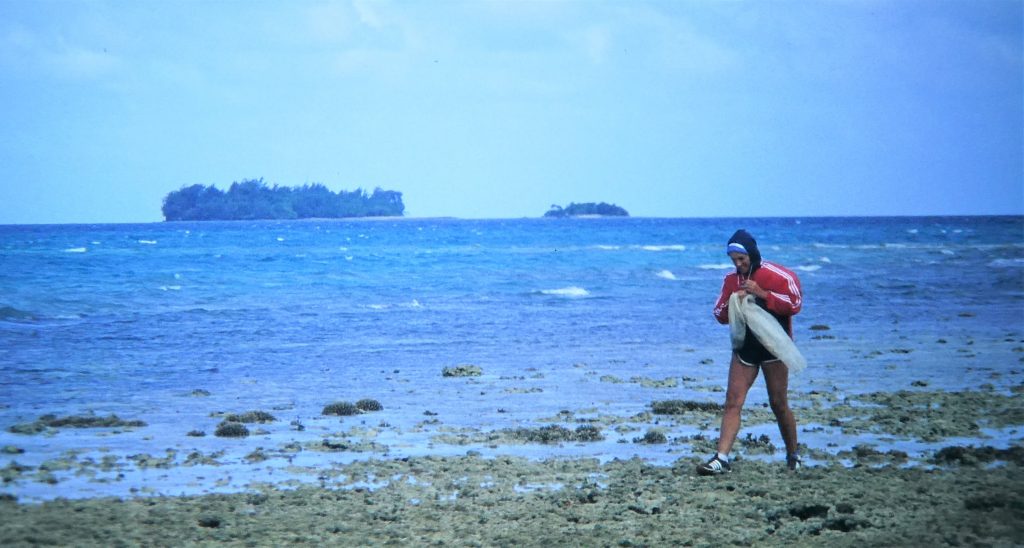 tide. The reef was crawling with tiger cowries, which we had never seen in such numbers. Norma found a good (dead) murex.
tide. The reef was crawling with tiger cowries, which we had never seen in such numbers. Norma found a good (dead) murex.
Arietta moved off because some activities in the village were rumoured for the evening and Mark did not like being personally involved in such affairs! (It could get quite embarrassing for visitors of a sensitive disposition!) They were replaced by Dream Maker.
A cool and windy period set in, and we were anchored only a couple of miles to the open sea to the east, so we motored back through the pass after first enjoying the company aboard of a group of happy, laughing villagers. We went on up to “Aisea’s Beach”, where he hosts his feasts in a very well-protected little bay on the south side of Pangai Motu.
I’d been a bit worried about noises from the engine for some time, but the rattle was getting bad by then. The freshwater pump pulley was wobbly, and clearly the pump bearing had failed. We were able to walk the 8 kilometres or so up to Neiafu with the aid of a lift from a local, and rang our business contact in Sydney. We had already been in contact with him about another engine part, the heat exchanger, so we added a water pump or a replacement parts kit to what we needed. We then called in to the very friendly and cooperative Moorings charter base, and it turned out that they had enough parts to do the fixing.
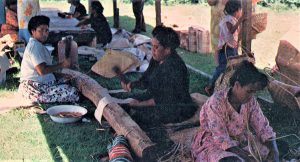 After a starry and peaceful night we sailed out of the anchorage, and down and round into the wide bay protected by the small Ifo Island. In the bay was “Metoto’s beach”, where he hosted his regular feasts. We dinghied over to the German yacht Flamingo, Renate and Hanspeter von Allmen with their daughter Veronica. We had met them in Ramsgate Harbour in April 1986! We were offered coffee and cake, German style. Ashore, we booked in for Metoto’s feast; on the beach were a line of women under a palm thatch shelter, pounding away at mulberry cloth to make tapas. Flamingo joined us for dinner.
After a starry and peaceful night we sailed out of the anchorage, and down and round into the wide bay protected by the small Ifo Island. In the bay was “Metoto’s beach”, where he hosted his regular feasts. We dinghied over to the German yacht Flamingo, Renate and Hanspeter von Allmen with their daughter Veronica. We had met them in Ramsgate Harbour in April 1986! We were offered coffee and cake, German style. Ashore, we booked in for Metoto’s feast; on the beach were a line of women under a palm thatch shelter, pounding away at mulberry cloth to make tapas. Flamingo joined us for dinner.
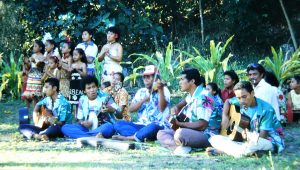
 The next afternoon we caught up with Metoto and Eleanor, with whom we had become friendly in 1982. His comment: “where have you been?” The fun of the feasting was much the same as before, with more “professional” singing and dancing in stylish traditional clothes, and a good music group including a violin. The feast was typically very good, including lobster, octopus, pork, fish in leaf parcels, raw fish, tomatoes and bananas. We added brandy (all we had) to the water in green coconuts, best drunk with a straw.
The next afternoon we caught up with Metoto and Eleanor, with whom we had become friendly in 1982. His comment: “where have you been?” The fun of the feasting was much the same as before, with more “professional” singing and dancing in stylish traditional clothes, and a good music group including a violin. The feast was typically very good, including lobster, octopus, pork, fish in leaf parcels, raw fish, tomatoes and bananas. We added brandy (all we had) to the water in green coconuts, best drunk with a straw.
A wind came in during the night, and a big British yacht that had anchored too close dragged down on us. I got the boathook out to hold them off, and got shouted at for possibly harming their boat and accused of dragging (forward??) into them. With our engine out of operation all we could do was let out more scope, so then we went aground at low tide. Their attitude was very Pom/Med: affronted and snooty!
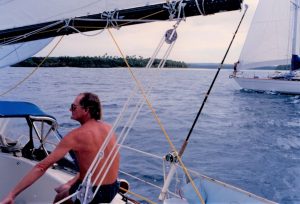 They moved out in the morning, and we sailed all the way back to Neiafu. Lowell and Lynn North in Wanago had been at the feast, and as they sailed past they called us to invite us to dinner with them and others at a restaurant that evening. It was a slow three-hour sail back to the harbour anchorage. I removed and dismantled the water pump and confirmed that the bearings were shot and the impeller cracked. We had a very pleasant dinner at Guenther’s Bellevue Restaurant with the Norths and their crew Tom, plus a visiting couple, friends of theirs.
They moved out in the morning, and we sailed all the way back to Neiafu. Lowell and Lynn North in Wanago had been at the feast, and as they sailed past they called us to invite us to dinner with them and others at a restaurant that evening. It was a slow three-hour sail back to the harbour anchorage. I removed and dismantled the water pump and confirmed that the bearings were shot and the impeller cracked. We had a very pleasant dinner at Guenther’s Bellevue Restaurant with the Norths and their crew Tom, plus a visiting couple, friends of theirs.
The Moorings had enough spare parts to rebuild the pump, and we used their workshop and another at Coleman’s boatyard to reassemble the parts, for which we were very grateful. We dined in luxury that evening on more fillet steak, together with coconut cream. This is quite hard to make, although Norma was already good at it. The meat is scraped out of the shell with a simple native tool, and the scrapings squeezed in muslin to ooze out the cream.
With the engine running again we motored out and all the way round through the coral pass and back to the eastern islands. We anchored north of Ofu Island and joined a big group of friends. We all assembled on Wanago for a long drinks party. Good times were had by all. It was much sunnier and more pleasant than in the harbour off the town, where there was a lot of burning off inland and the smoke was lying in the bay.
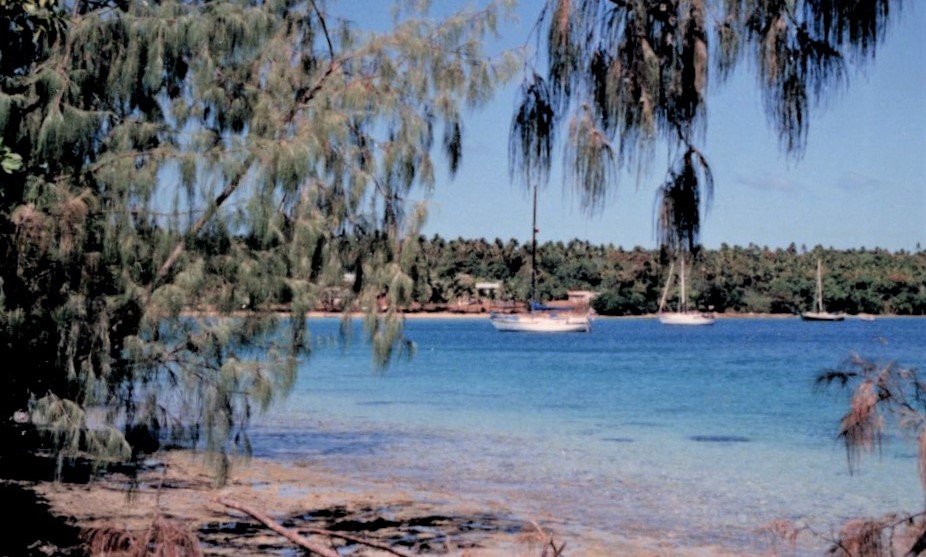 All the others left us to ourselves the next day. After exploring parts of the outer reefs in the dinghy we took the boat back to our previous anchorage by two small islets just to the north of Olo’ua Island. We met up there with another group of friends, including Don and Linda on Green Dolphin. They asked us to join them at a feast they had organised with a villager, Lesieli, at her house. We all provided a small sum “for the village”.
All the others left us to ourselves the next day. After exploring parts of the outer reefs in the dinghy we took the boat back to our previous anchorage by two small islets just to the north of Olo’ua Island. We met up there with another group of friends, including Don and Linda on Green Dolphin. They asked us to join them at a feast they had organised with a villager, Lesieli, at her house. We all provided a small sum “for the village”.
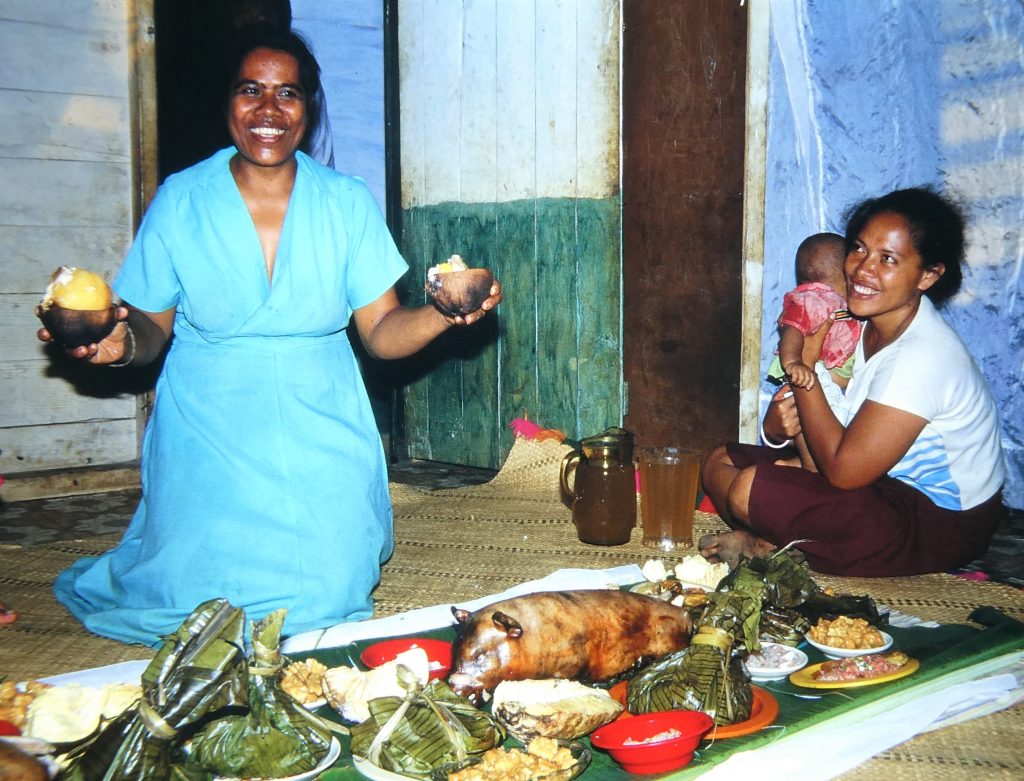 They put on a splendid meal, based on two suckling pigs and supported by the usual array of local food. After that we looked in at a local event. On the following weekend there was to be an inter-village song-and-dance competition, and the Olo’ua village was heavily into practising for that.
They put on a splendid meal, based on two suckling pigs and supported by the usual array of local food. After that we looked in at a local event. On the following weekend there was to be an inter-village song-and-dance competition, and the Olo’ua village was heavily into practising for that.
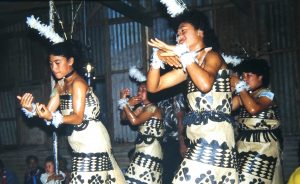 The assembly was in the meeting room, with men, women and children segregated. There was some ad-lib dancing, including the usual laugh-at-a-palangi bit, and then some serious dancing by a quartet of village girls in basket dresses and feather head dresses. There were speeches by the village head man and other local dignitaries. It was all a milling, noisy throng, a great experience.
The assembly was in the meeting room, with men, women and children segregated. There was some ad-lib dancing, including the usual laugh-at-a-palangi bit, and then some serious dancing by a quartet of village girls in basket dresses and feather head dresses. There were speeches by the village head man and other local dignitaries. It was all a milling, noisy throng, a great experience.
Lesieli and two daughters of the chief (she was a daughter-in-law) came out to the boat the next day for an extended visit. They were charming. Lesieli wrote in our visitors’ book: “Hullo, malololelei! We are very happy to meet again. Thank you for your help for us when we have a feast and thank you for all, hope to meet again and do the dancing. Last night I hope you happy when we are in my island thank Cera. God protect you all the time”. Who could not love the Tongan people?
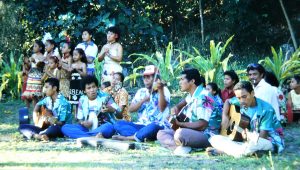
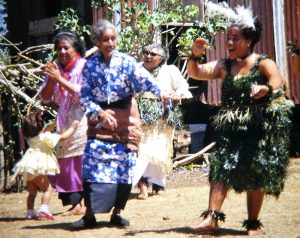 In continuing lovely tradewind weather we moved back to the western isles and anchored on the western side of large Kapa Island, opposite the tiny islet of Nuku. There were activities on the village wharf, and went ashore to see more singing and dancing, with sermonising and preaching. This was a competition between villages in the western group of islands, arranged by the Methodist churches to get young people together. There was much variety in local costumes, and some enthusiastic parodying of the dancing by groups of elderly women. Again, women and men were segregated.
In continuing lovely tradewind weather we moved back to the western isles and anchored on the western side of large Kapa Island, opposite the tiny islet of Nuku. There were activities on the village wharf, and went ashore to see more singing and dancing, with sermonising and preaching. This was a competition between villages in the western group of islands, arranged by the Methodist churches to get young people together. There was much variety in local costumes, and some enthusiastic parodying of the dancing by groups of elderly women. Again, women and men were segregated.
Through the day many yachts came in from the central Pacific, including Bora Bora, Rarotonga, Aitutaki and Pago Pago. Among them were several friends and so there was a lot of socialising. We dined that evening on Sourisa, whose pleasant young family had caught an immense mahi mahi on the way in. They had gangs of local aboard most of the next day, singing in their cockpit. We sailed up to “our” anchorage off Lotuma Island, as the westerly wind was building. We were preparing to leave by now, but this was no weather for sailing west.

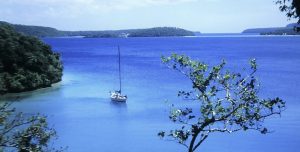 We took the dinghy into Neiafu for some shopping and business with the post office and the Moorings workshop. Boats were still pouring in for clearance. We spent a night in “Isaac’s Bay” (another feast site) under the heights of the pinnacle of Talau, and then moved back to the town for fuel. Engine parts arrived from Australia, so I did more work fixing up the engine.
We took the dinghy into Neiafu for some shopping and business with the post office and the Moorings workshop. Boats were still pouring in for clearance. We spent a night in “Isaac’s Bay” (another feast site) under the heights of the pinnacle of Talau, and then moved back to the town for fuel. Engine parts arrived from Australia, so I did more work fixing up the engine.
We did a lot more socialising with local and yachty friends, of course, and cleared with officialdom to leave. However, the weather was in one of its periodic extended complex-frontal stages, with too much wind and rain, so we moved out of the crowds and down to the southern end of the harbour to get out of the forecast strong westerlies. There was plenty more maintenance to be done, anyway.
As the weather improved we moved out to Lotuma and then down to Nua Papu. After a beautiful calm night and in a clear sunny morning, on 14 September 1989 we sailed away for Suva, Fiji, about 400 nautical miles away on the rhumb line. But along the way we had the many small islands, atolls and reefs of the Fijian Lau Group to avoid.
Fiji
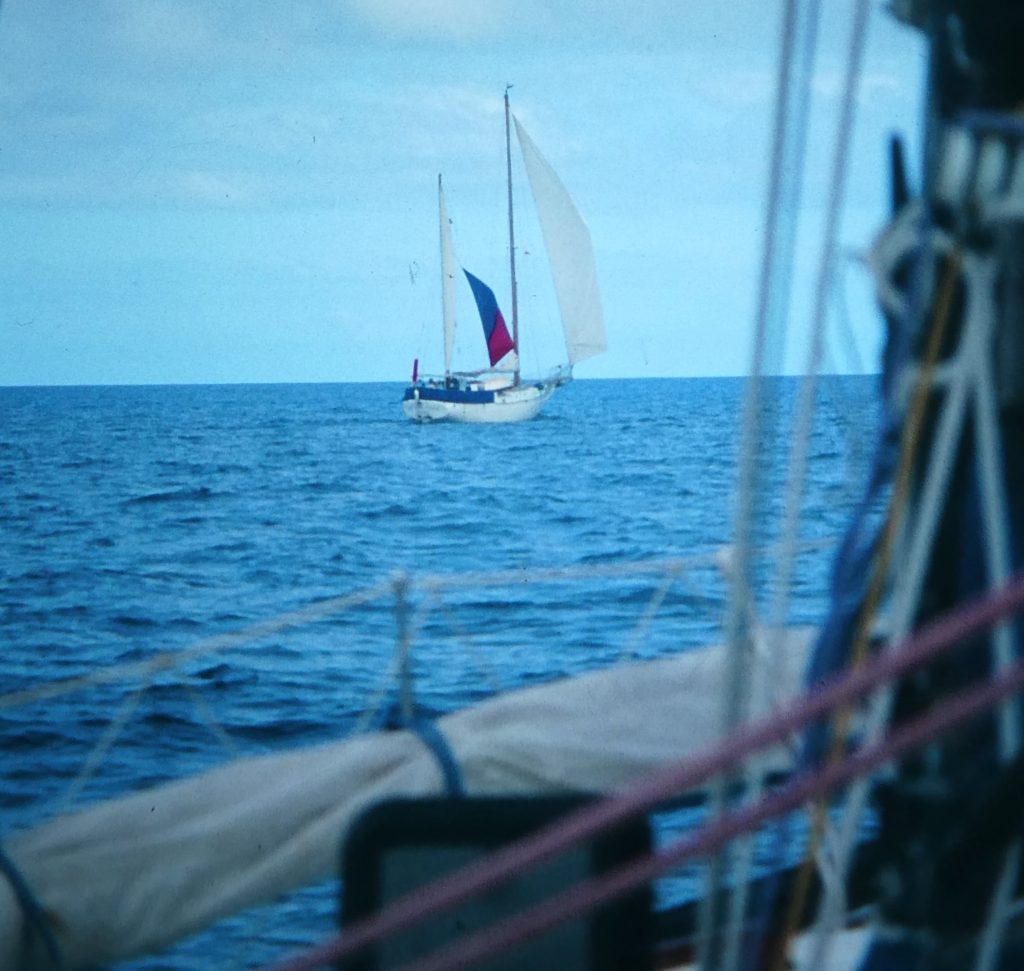 Leaving the Friendly Isles (as designated by Cook) for the open sea we passed our friends in Pacific Jade (right). On the radio we heard Sourisa telling them they’d picked the right boat to leave with: “they never have bad weather!”
Leaving the Friendly Isles (as designated by Cook) for the open sea we passed our friends in Pacific Jade (right). On the radio we heard Sourisa telling them they’d picked the right boat to leave with: “they never have bad weather!”
We soon settled in to good tradewind sailing, and caught a large tuna the second day out. After the recent westerlies the sea was lumpy, and Norma was feeling it, needing a Transderm by evening.
Our plan was to sail round to the south of the Lau group and its dangers, with the main turning point being Totoya Island. This we passed at midnight between the third and fourth days out. We were still sailing in splendid conditions, well settled into the passage-making routine of watch-keeping (sail trimming and having a look around at regular intervals), position-fixing, cooking and eating, reading and sleeping.
We were making over 120 nautical miles a day with little to do but watch the flying fish gliding over the blue sea. Some were landing on deck, as usual, but they are not good to eat.
As we started easing more northerly up the course to Suva the seas flattened because of the reefs and islands of the Laus to our north-east. The weatherfax did show that a front was approaching from New Caledonia, but we hoped to reach Suva before it arrived.
On Monday 18 September, just after midnight, we lowered the headsail in calm conditions to motorsail on the guiding lights through the massive line of reefs into Suva Harbour. In the dark we tracked the buoys through the harbour and anchored in the defined quarantine area. It had been an easy passage in good conditions, and we hoped the next two legs – the last ones before Australia! – would be as pleasant.
We had sailed 454 miles in 88 and a half hours, an average of 123 nautical miles a day.
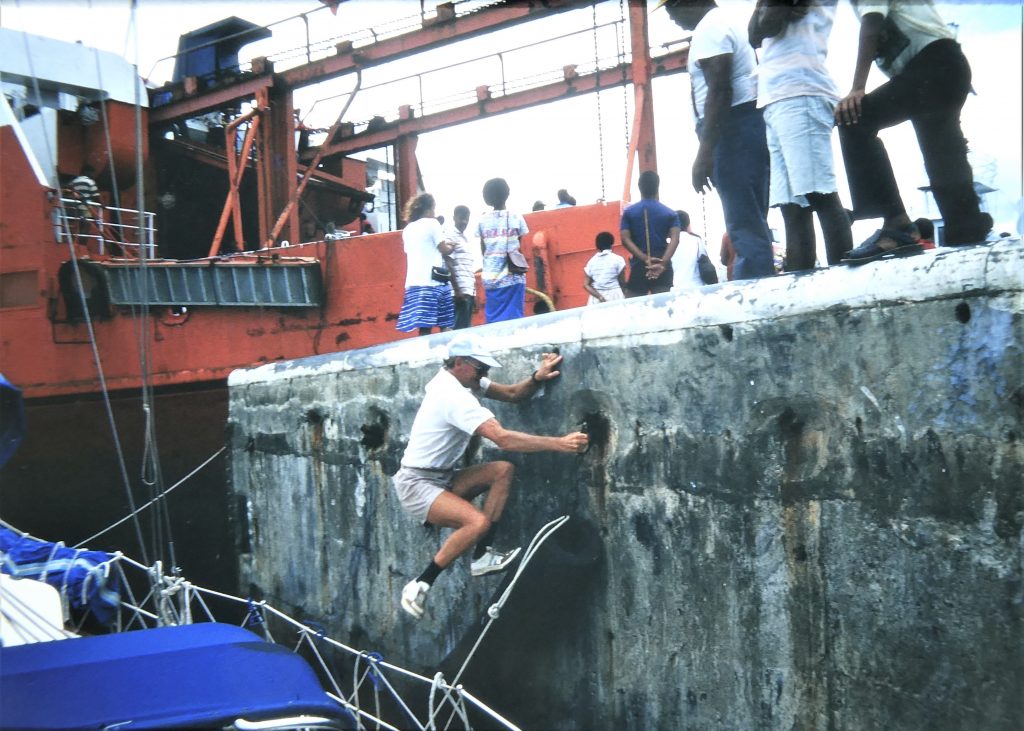 It was warm and humid under clear skies in the morning, and we called port control for directions. Four hours later we were boarded by health officials and given “pratique”, after which we had to go alongside. I had a stiff climb up a high stone wharf, and first visited Customs with an offhand Indian official with three sets of forms. It was then to Port Security, an army operation, friendly and courteous, to fill in more forms.
It was warm and humid under clear skies in the morning, and we called port control for directions. Four hours later we were boarded by health officials and given “pratique”, after which we had to go alongside. I had a stiff climb up a high stone wharf, and first visited Customs with an offhand Indian official with three sets of forms. It was then to Port Security, an army operation, friendly and courteous, to fill in more forms.
We had of course spent much enjoyable time in Fiji in 1982, visiting between New Zealand and Vava’u in the early days of our voyaging. This time it was more of a simple transit stop on our way home. We soon become conscious of the substantial political and other changes to the country’s life since that previous visit. Fiji was under British rule for hundred years before being granted independence in 1970. The British administration brought in thousands of indentured Indian labourers, and ever since then the question of land ownership has been front and centre for local politics. Over 80% of the land is held by indigenous Fijians. Indo-Fijians produce over 90% of the sugar crop but must lease the land they work from its ethnic Fijian owners instead of being able to buy it outright. Indians came to fear an Indo-Fijian government might strip them of their land ownership, and government became fractured and unstable.
There recently had been two military coups in 1987, precipitated by a growing perception that the government was dominated by the Indian community. An ethnic Fijian who was supported by the Indo-Fijian community formed the first majority Indian government, but was soon deposed by a Fijian colonel who revoked the constitution. In a matter of months he resigned and a Fijian-led and Indian supported government took the lead of the new Republic of Fiji. The ramifications and turbulence of those recent years were still having their effects when we visited this time.
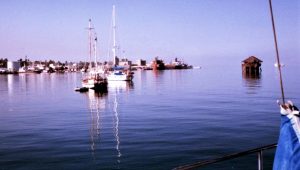 After clearance we were free to go a little further into the harbour and anchor off the Royal Suva Yacht Club, with which we were familiar from our previous visit a few years before. We took a short walk ashore and showered at the club, and dined later with Mark and Laraine on Arietta, a highly enjoyable reunion. They and another boat had been recently burgled, they told us, so we took security a lot more seriously than we ever had before.
After clearance we were free to go a little further into the harbour and anchor off the Royal Suva Yacht Club, with which we were familiar from our previous visit a few years before. We took a short walk ashore and showered at the club, and dined later with Mark and Laraine on Arietta, a highly enjoyable reunion. They and another boat had been recently burgled, they told us, so we took security a lot more seriously than we ever had before.
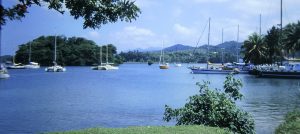 It became very windy from the south, so we moved up the harbour bay to spend a night in a mangrove bay and then moved to the anchorage off the Tradewinds Hotel. This had been a popular place on our previous visit, but the hotel was now shut and its wharf packed with
It became very windy from the south, so we moved up the harbour bay to spend a night in a mangrove bay and then moved to the anchorage off the Tradewinds Hotel. This had been a popular place on our previous visit, but the hotel was now shut and its wharf packed with 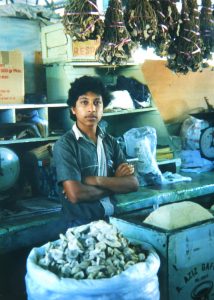 permanent live-aboards. But we could walk to Lami village for some basic shopping and the post office. After this little sojourn we returned to the yacht club and Suva town, where we bought some souvenirs including a beautiful kava bowl and a few other artefacts.
permanent live-aboards. But we could walk to Lami village for some basic shopping and the post office. After this little sojourn we returned to the yacht club and Suva town, where we bought some souvenirs including a beautiful kava bowl and a few other artefacts.
The town was not what it used to be; now rather sombre by the familiar Fijian “Bula!” standards, and the Indian people seemed very subdued.
We had arranged with Mark and Laraine to rent a car for a day. The afternoon we picked up the Toyota Corolla we took it along the southern coast to have a look at a new tourist development, Pacific Harbour, of the kind that the Fijians hope would boost their economy in the future. It was very quiet, and we saw few tourists in Suva. We hoped that the political turbulence would soon settle.
We left early the next day and went through the town to get on to the Kings Road, the main “highway” up the eastern part of the island of Viti Levu and round to the north. It was a winding, 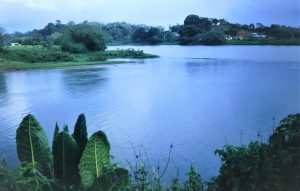 bumpy gravel road which in the early stage of our route ran alongside the wide Rewa river. This is a substantial waterway, lined by rice fields and Indian villages.
bumpy gravel road which in the early stage of our route ran alongside the wide Rewa river. This is a substantial waterway, lined by rice fields and Indian villages.
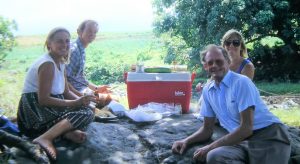 The Kings Road turned west and became a climb to the inland through dense and lush rain forest before coming to dryer country and vast sugar plantations. We returned to the coast near the north-east corner of the island, and viewed the extensive coral fringing reefs and many small offshore islands.
The Kings Road turned west and became a climb to the inland through dense and lush rain forest before coming to dryer country and vast sugar plantations. We returned to the coast near the north-east corner of the island, and viewed the extensive coral fringing reefs and many small offshore islands.
At Tavua we turned south at the intersection there and took the road that cut across the centre of the island. The advice we had received was not to try it because it was only suitable for four-wheel drive vehicles, but we gave it a go anyway. We stopped in the foothills for a picnic lunch and watched all kinds of activity around the harvesting of cane and loading it onto wagons on the narrow-gauge railways. Friendly Indians in the fields shouted to us “no Fijians here!”
 We climbed further up into the central mountain range, this time through many Fijian villages on the way to Mount Victoria. Our arms got tired waving to the Fijians, their faces blooming into huge grins, flashing gapped teeth, two-handed waves, shouts of “bula”, “moce”, and “bye-bye!” Many of the village houses were walled with woven pandanus and looked like chess boards, and
We climbed further up into the central mountain range, this time through many Fijian villages on the way to Mount Victoria. Our arms got tired waving to the Fijians, their faces blooming into huge grins, flashing gapped teeth, two-handed waves, shouts of “bula”, “moce”, and “bye-bye!” Many of the village houses were walled with woven pandanus and looked like chess boards, and 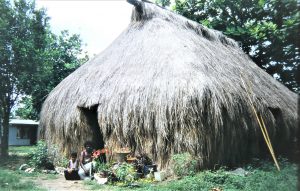 others were totally covered by a long, shaggy thatch. The more up-market houses were made of corrugated iron sheets. Colourful plants and flowers were everywhere.
others were totally covered by a long, shaggy thatch. The more up-market houses were made of corrugated iron sheets. Colourful plants and flowers were everywhere. 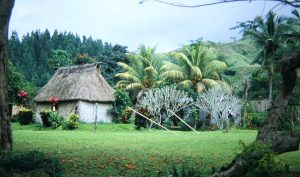 There were several herds of wandering cows, but we saw no pigs. Further on down, in Indian villages, we saw several goats. There was not much wildlife to be seen,
There were several herds of wandering cows, but we saw no pigs. Further on down, in Indian villages, we saw several goats. There was not much wildlife to be seen, 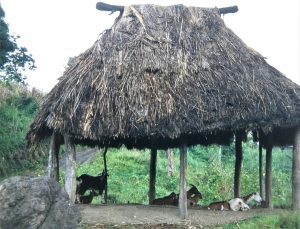 except for one or two mongoose running across the road in front of us.
except for one or two mongoose running across the road in front of us.
We went up to a large dam at Monasavu, which is fed by several rivers and provides hydro power. The road had been acceptable up to that point, but became much worse. To compound the problem the car had minimal ground clearance and poor front-wheel drive traction. Weaving round the bigger rocks was quite an obstacle course. On one steep stretch we simply couldn’t make it, with the front wheels just spinning. Once the three passengers were out, I just managed to nurse it up to the top of the hill.
The countryside was lovely, with layers and layers of mountain ranges extending to the horizon. The weather held, with only a few showers on the windward side and hot and sunny up north.
Latterly it seemed a long run back down to Suva, but the roads got a little better and we got back just before dark after many stops to ask for directions. It had been quite a challenging tour, but we’d had a lot of fun.
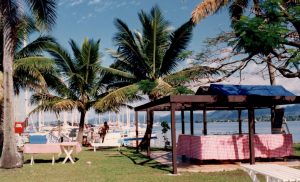 For the next few days the weather was wet and windy under a convergence trough covering the whole South Pacific. We caught up with boat maintenance and there was a good deal of socialising among the yachts. Norma washed the sheets and cushion covers in convenient tubs at the yacht club. She also tried to help a German boat in a serious dispute with a local sailmaker, ending with the Germans being arrested for a while and released without their sail or their money!
For the next few days the weather was wet and windy under a convergence trough covering the whole South Pacific. We caught up with boat maintenance and there was a good deal of socialising among the yachts. Norma washed the sheets and cushion covers in convenient tubs at the yacht club. She also tried to help a German boat in a serious dispute with a local sailmaker, ending with the Germans being arrested for a while and released without their sail or their money!
On the weekend we joined the weekly barbeque at the yacht club, a great social occasion among our many friends. But we all returned to our boats by 8:00 pm because of fear of theft at a time when we all were known to be ashore.
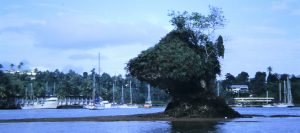 We moved to a lovely little anchorage off Mosquito Island, a picnic place within the harbour on the way to the bay fronting the Tradewinds Hotel, and where the water was clear and clean enough to get to work on the underwater hull. We got friendly with a single-handed Brit, Mike, living on a tiny Wharram catamaran and subsisting on his budget: five dollars a day! We took the dinghy up the Tamavua River, which runs into the harbour opposite the yacht club. It was a scenic trip through rural flats, cows, cultivated fields, and some thick rain forests backed by steep cliffs. There were lots of kids swimming and coming home from school. As usual, all waved and
We moved to a lovely little anchorage off Mosquito Island, a picnic place within the harbour on the way to the bay fronting the Tradewinds Hotel, and where the water was clear and clean enough to get to work on the underwater hull. We got friendly with a single-handed Brit, Mike, living on a tiny Wharram catamaran and subsisting on his budget: five dollars a day! We took the dinghy up the Tamavua River, which runs into the harbour opposite the yacht club. It was a scenic trip through rural flats, cows, cultivated fields, and some thick rain forests backed by steep cliffs. There were lots of kids swimming and coming home from school. As usual, all waved and  grinned, as did workmen in the fields.
grinned, as did workmen in the fields.
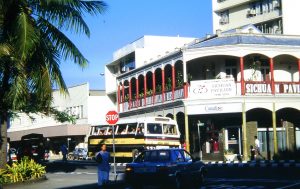 The weather continued very changeable, warm and wet, with a torrential thunderstorm that filled the dinghy. But we were following the weather patterns and started the process of clearing out with officious officialdom. We suffered the usual waits and multiple form-filling at Immigration, Customs and Port Security.
The weather continued very changeable, warm and wet, with a torrential thunderstorm that filled the dinghy. But we were following the weather patterns and started the process of clearing out with officious officialdom. We suffered the usual waits and multiple form-filling at Immigration, Customs and Port Security.
Norma did some shopping at the excellent clothing mart for “seconds”, and we did some further provisioning. We had lunch at our favourite Chinese restaurant in the town centre, where from the balcony we had a good view of the activities below.
On the early morning of Sunday 8 October, after an active and enjoyable (despite the weather) three weeks in Suva, we motored out through the pass in the reef in oily calm, soon to be sailing in a light south-east wind.
Noumea, New Caledonia
We anticipated - and hoped for - a relatively uncomplicated passage to Noumea, the capital of New Caledonia, about a week's sail to the south west. We did need to pay attention sailing through the Beqa passage, between that reef-circled island and the vast fringing reefs of southern Viti Levu , but we were soon past them and sailing fast in a firming sou-easter.
We settled into a few days of great sailing in fine conditions until we met a slow-moving cold front that we had seen coming on the weather maps. The wind eased then suddenly turned to the south during the night, but the barometer showed nothing worrying and on the fourth morning we were under full sail under blue skies. These general conditions then held in well.
On the morning of the fifth day out we were aiming to sail between Mare Island, one of the Loyalty group, and a dangerous reef to its south, Recif Durand. Later that day we could just see New Caledonia through some haze, and navigation became a serious matter as the sun went down in our eyes.
Just off the south-east corner of New Caledonia's main island there begins a long and wide line of reefs extending south-east for about 50 kilometres (25 nautical miles) down to the Isle of Pines. The reefs are not well surveyed and the (old French) charts vague. There are two passes through the reefs but only one is well marked and lit, the Canal de la Havannah, just off the main island's tip. About 10 miles out we were on the leading lights that would guide us through; the skies were clear and the moon was nearly full. But the seas were becoming rough and it was clear that we were soon to be fighting an out-going tide against the wind.
We started the engine, but after 10:00 pm we were battling seriously rough and horrible conditions, nearly stationary in vicious overfalls and tidal rips. By 1:00 am progress was still slow, although we had passed the light at the neck of the channel. We eased over to the north side and the coast with a view to finding shelter in what the chart showed as a protected bay, but its entrance was narrow between two wide reefs. No safe entry was discernible in the dark, despite the moon, so we plugged on down to the easy and lit entry to the Baie du Prony, with which we were familiar. At 2:55 am on Saturday 14 October we anchored in sand on the north shore of Ile Montravel, within Prony, in blessed peace!
We had covered 713 nautical miles in 5 days 18 hours, at a daily average of 124 miles. It had been a pleasant and uneventful run until these final hours!
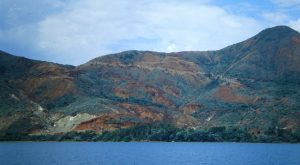 After a calm night we woke late to a beautiful morning and had a refreshing swim in rather cool water. We moved along a little closer to Noumea, passing through the Canal Woodin between the mainland and Ile Ouin and came to anchor in the Baie Ngo. This was new to us, and it was not nearly as pleasant an anchorage as Prony. The hills all around were scarred by roadways and resulting red landslides. We moved on the following morning, assisted by a building SE trade wind blowing up the lagoon.
After a calm night we woke late to a beautiful morning and had a refreshing swim in rather cool water. We moved along a little closer to Noumea, passing through the Canal Woodin between the mainland and Ile Ouin and came to anchor in the Baie Ngo. This was new to us, and it was not nearly as pleasant an anchorage as Prony. The hills all around were scarred by roadways and resulting red landslides. We moved on the following morning, assisted by a building SE trade wind blowing up the lagoon.
We entered Noumea harbour in the afternoon and headed into the large Baie de l'Orphelinat, south of the town centre and popular with cruising yachts. We anchored near John and Mary Lavery in Sitisi III, whom we had last seen in Morro Bay in 1983 and had meanwhile been on an eastabout circumnavigation, their second. Also near us was Mike in his little Wharram catamaran, still sticking to his minuscule budget.
We spent the night there but had to move round to the Baie de Moselle, off the city, for entry formalities. These were completed quickly and politely. The bay was extremely crowded with at least 60 boats at anchor, but we found a hole and anchored in 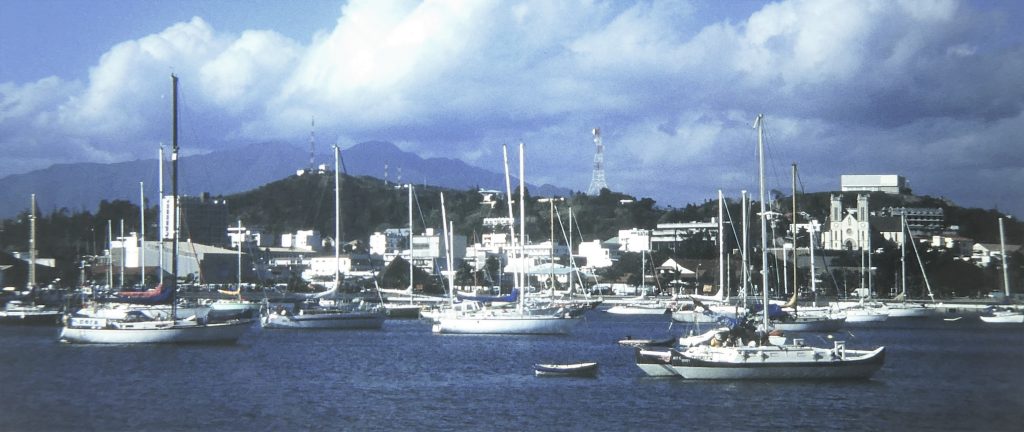 splendid protection out of the wind. We were told that the whole bay would soon be filled with a massive new marina and would then no longer be available for anchoring.
splendid protection out of the wind. We were told that the whole bay would soon be filled with a massive new marina and would then no longer be available for anchoring.
We were soon ashore for shopping, and the posh and very well stocked Prisunic supermarket was the best we had experienced since the Canary Islands! And it was a lot less expensive than in Papeete. We lashed out on delicious pates, cheeses and baguettes among lots of other foodstuffs.
Over the next few days we simply wandered around, 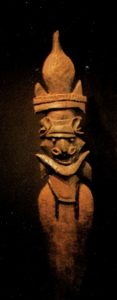 did some letter-writing, caught up with a few friends in the anchorage, and dealt with more officialdom in preparation for clearing out. The Musee de la Ville de Noumea was nearby, and we found it to be an excellent collection of New Caledonian
did some letter-writing, caught up with a few friends in the anchorage, and dealt with more officialdom in preparation for clearing out. The Musee de la Ville de Noumea was nearby, and we found it to be an excellent collection of New Caledonian 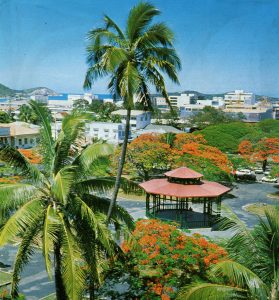 artefacts. There were examples of village huts, pirogues and indigenous carvings. One of these was the original Fleche Faitiere figure, a copy of which adorned the mainland bulkhead in our saloon. We had won it for success in one of the categories in the Sydney-Noumea yacht race in 1977, our first serious oceanic passage.
artefacts. There were examples of village huts, pirogues and indigenous carvings. One of these was the original Fleche Faitiere figure, a copy of which adorned the mainland bulkhead in our saloon. We had won it for success in one of the categories in the Sydney-Noumea yacht race in 1977, our first serious oceanic passage.
As a week ran out we were carefully watching the weather forecasts and weatherfax maps in preparation for our crossing the Tasman Sea back to Australia. Among unexpected visitors we came across a Sydney couple, members of our cruising club, who were in Noumea for a tennis tournament and swam out to the boat! Other visitors were Wally Willmott and Elsa, on Jeshan, also on their way home.
The weather was settling, with light and variable winds, and although the weather map showed a front approaching it all looked good enough to leave.
On Sunday 22 October we sailed out of Noumea in a light SE wind under clear skies for what we trusted would be our last long passage before finally returning home. Sailing out to the big barrier reef we followed Mike Bromley in his little cat. We were through the reef by mid-day. By evening the wind and seas were building and becoming uncomfortable and we reefed before nightfall.
Conditions then moderated, with reasonable winds and good sailing under clear skies. By Wednesday the wind was backing and a southerly change was forecast for late Friday. On Friday morning the wind was strengthening and backed to the north west, as expected with an approaching cold front. A black night settled in, and the wind shifted to the west then south-west, dead against us. There was lightning to the north and east of us. We dropped the headsail and jogged along under a double-reefed main, waiting to see what would happen next.
In the early hours of Saturday conditions became very uncomfortable, with a strong SSW wind and steepening seas. As we were not making much progress towards Coffs Harbour, our intended destination, we chose to heave to for a few hours to get some rest and sleep. We well remembered the experience just a year ago in this bit of ocean of our good friend Julia Hazel, in the last leg of her incredible single-handed and engineless circumnavigation. In similar but probably worse conditions her yacht, Jeshan, was completely rolled by a high, steep wave. Both she and the boat were unharmed, but so much water was shipped that she had lots of interior damage and lost most of her photographs. This was a tragedy for one who was partly funding her sailing through writing for sailing journals. Not wanting to duplicate this event we became super-conservative sailors for a while!
The southerly settled into a solid 25-30 knot SSE, and by dawn Sunday we were flying along, up to our knees in water on the foredeck, spray everywhere on the boat and us. A little bird - a swift or martin, we thought - was as concerned as us; he settled under the dodger until Norma took him below and shut him in the wok. We hove to again mid-morning as a vicious squall went through. By evening the wind was finally easing, although the seas were still awful.
Early Monday morning under clear skies and light winds we sailed gently into Coffs Harbour. The log records: "Back in Australia!! It's all over".
We released the little bird and after checking with Customs came into the inner harbour and tied up on the public wharf. We were almost immediately joined by Mike in his little catamaran - well done, we thought.
The officials complimented us on our nice clean boat, and relieved us of foodstuffs and garbage. We had a short debate about our status. The rules were that it was not possible to re-import a vessel if it had been out of the country for more than five years. However, we had clarified that matter with the Customs Bureau while we were still away, and established that as long as we had been living on the boat that limitation did not apply. We had a letter from the authorities to that effect, and we were accordingly waved in to the country and a berth in the marina.
On this passage, not an easy one (typical of the Tasman) we had covered 876 nautical miles (about 1,700 kilometres) in 7 days and 22 hours, a slow passage at an average of 111 miles a day including periods hove to.
We had six nights of poor weather in which to recuperate, and then sailed overnight down to Port Stephens for another rest in rain and wind, re-exploring very familiar waters. Before leaving for our voyaging we had purchased a waterfront block in Lemontree Passage, and we had a look at it. From there it was an over-nighter to Sydney Harbour, which we re-entered nearly eight years and two months since departing on 28 September 1981.
In review, our voyaging had been undramatic by the standards of so much we had read. We had been to no place we had really disliked, battled no survival storms, had no serious sail, engine, rigging or gear failures, and no crew problems (no crew!).
We spent the night in Quarantine Bay and caught up with our daughter Anita. We then moved round to Sailors Bay in Middle Harbour and tied up on the wharf at the home of our old sailing friends Peter and Jo Dan. In line with tradition, we dressed ship with most of the multiple courtesy flags we had flown in the 45 or so nations we had visited in our voyaging.
The log records, "And now for something completely different".
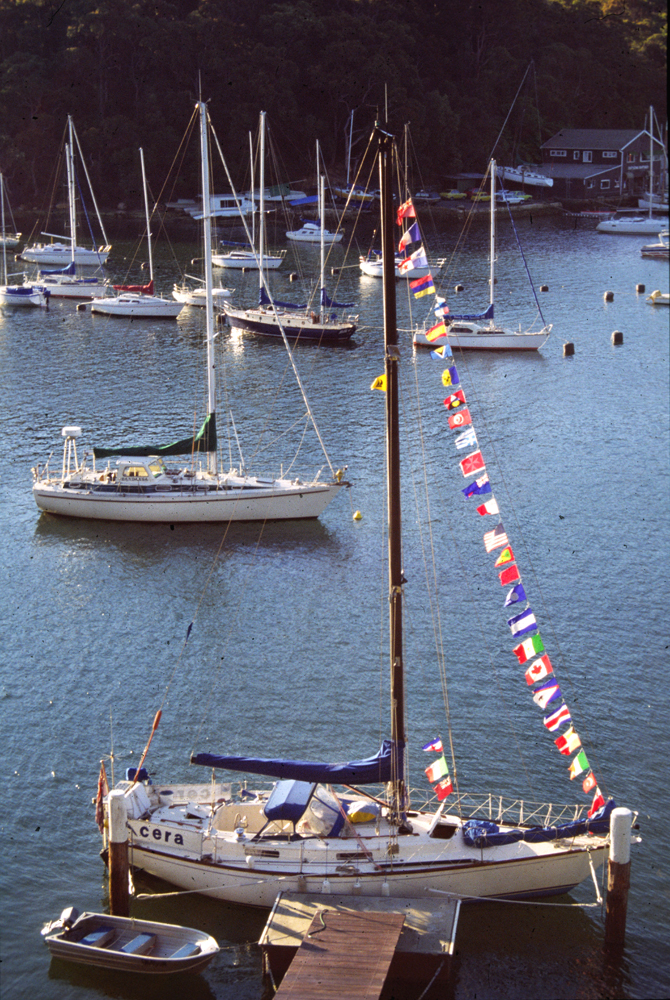
Our calls to Suva and Noumea were only to break up the passage-making, as “cruising” in the strict sense of the word, was over for us by that time. We were simply heading for home, like a hungry horse with the scent of his stable in his nose. But they were both enjoyable stops, sociable among the many boats with whom we had made friends during the ill-dubbed “milk run”. In both Fiji and New Caledonia, the current political problems were only too apparent, sad to say.
We had for many months regarded the last long leg of the voyage, across the Tasman, with great trepidation, not helped by the fact that the previous year our very good friend Julia Hazel, single-handing her way home after an awe-inspiring engineless circumnavigation, had been capsized just a day or two out of Sydney. So when we got the inevitable cold front, bringing the equally inevitable foul seas despite a southerly of below gale force, we just hove to and sat it out for half a day before pressing on to Coffs Harbour.
Entry procedures there were as easy as we had hoped. There are still many who think that after more than five years away, duty is payable on the boat. The situation – which we clarified years ago – is this. Sure, the regulations say that a vessel is liable for duty after this period. But as long as you can show that the yacht has remained in your possession and use while away there is no time limit, and it is re-imported free of duty as a “personal possession”.
In review, our voyaging has been undramatic by the standards of so much we have read. We have been to no place we have really disliked, battled no survival storms, have had no serious sail, engine, rigging or gear failures, and no crew problems (no crew!).
Coffs was a good place to ease back into the real world, with a convenient marina which is cheap by world standards. We sat out some wet and windy weather there while getting adjusted to the fact that in a few days we would be back in Sydney, anxious to see our daughter, other relations and friends, but not so anxious to tackle the logistics of re-establishment ashore. Back in Sydney we were happy to stay aboard for several weeks while tenants continued to keep us solvent. Leaving Cera would see the end of an eight-year period that we were sure would be the highlight of all our years together.
